ISLAMIC ART AUCTION


THURSDAY 22 JUNE 2023





Oriental Art Auctions
Warmtekrachtstraat 2 8094 SE Hattemerbroek The Netherlands
tel: +31- (0)38-3380783
info@orientalartauctions.com
www.orientalartauctions.com
CoC. 66070651
VAT no. NL856383405B01
Auction status: Open, accepting bids.
Auction dates: Thursday 22 June 2023, start time 11.00 CEST
Viewing dates: 19-20-21 June 2023 from 11.00 - 17.00 hrs.
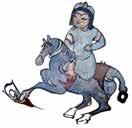
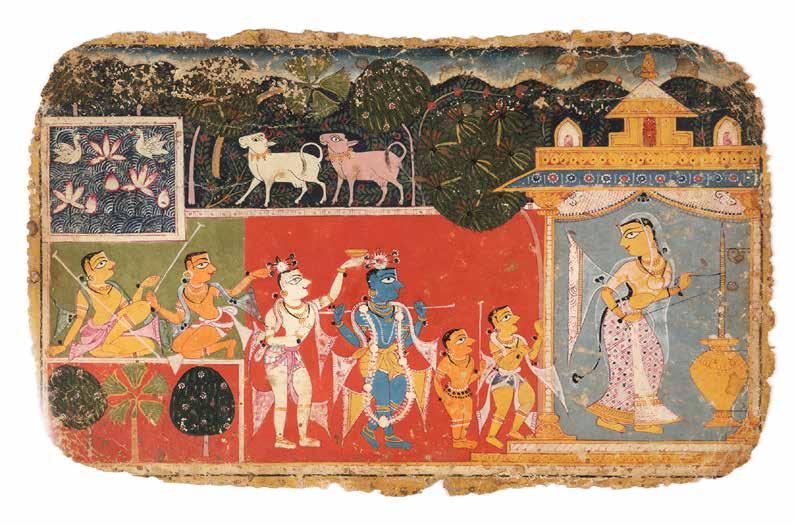
Krishna watches his mother Yashoda churning butter and requests her to let him eat it. 27 by 16.5 cm.
Daniel Ehnbom has defined at least ten anonymous painters contributing to this series of Bhagavata Purana paintings. These are referred to by Ehnbom as Painters A-J. For more on this series, see Sotheby’s New York, March 17, 2015, Lot 1110-1112; Edwin Binney 3rd, Rajput Miniatures from the Collection of Edwin Binney 3rd, Portland, 1968, p.4-5, cat.1c; Daniel Ehnbom, Masters of the Dispersed Bhagavata Purana, fig.4, p.77-88 (in M.C. Beach, E. Fischer and B.N. Goswamy, Masters of Indian Painting 11001650, Artibus Asiae Sup.48/I, 2011); Daniel Ehnbom, An Analysis and Reconstruction of the Dispersed Bhagavata Purana from the Caurapancasika Group, The University of Chicago, 1984, p.235; and Darielle Mason (ed.) (essay by John Seyller), Intimate Worlds: Indian Painting from the Alvin O. Bellak Collection, Philadelphia, 2001, pp.48-49.
Private collection, Germany
Estimate € 12.000 - € 15.000
Lot 2
A sakhi brings a message from Radha to Krishna Krishna requests the gopis for an audience with Radha. 29 by 19.5 cm.

PROVENANCE
Private collection, Germany
Estimate € 12.000 - € 15.000
Lot 3
MAHARAJA RANJIT SINGH OF PUNJAB IN PROCESSION, 19TH CENTURY
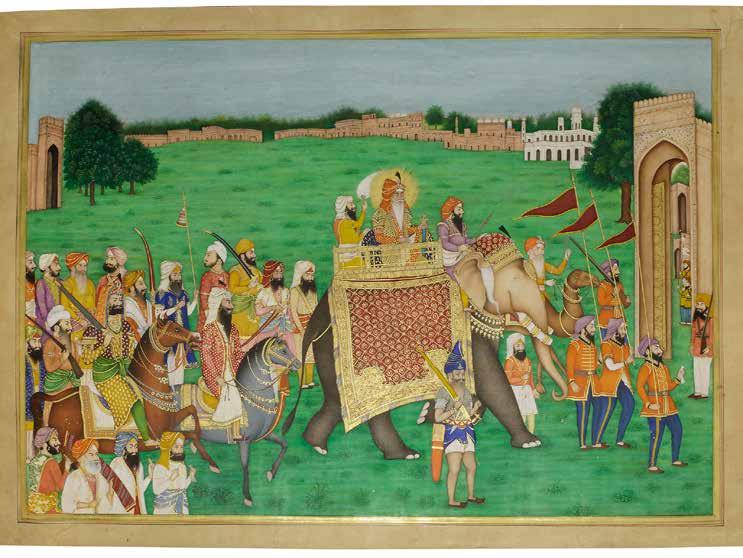
Maharaja Ranjit Singh of Punjab (B.1780-D.1839)
Lahore School, Punjab, 19th century. Probably by a royal court artist of the Punjab Rulers. Opaque pigments and gold on paper, within an inner golden border and an outer ivory border. 51 by 35.5 cm.
PROVENANCE
Private collection, Germany
Estimate € 15.000 - € 20.000
Maharaja Ranjit Singh of Punjab (b. 1780, reg. 1801-1849) rides a richly caparisoned elephant as its mahout with a goad in his hand, while an attendant seated behind him holds the requisite chowrie. His two sons Raja Kharak Singh & Raja Sher Singh follow on decorated horses. Soldiers with appropriate emblems and standards march in front with a more renowned group of Nobles and attendants behind. The procession takes place in a green landscape and seen in the distance are palaces and houses of the city.
Painting in the Punjab up to the middle of the nineteenth century had been largely the domain of artists from the Punjab Hill states, lured by the prospect of patronage to the great cities of Lahore and Amritsar (see Archer). Simple portraits or decorative pictures for their Sikh patrons changed possibly under the influence of British taste after the annexation of the Punjab in 1849 into more genre-orientated pictures, slices of real life apparently painted by Sikh artists, as well as portraits in more up-to-date taste of what remained of the Sikh nobility. These are naturalistic and highly decorative as in the painting of Maharaja Ranjit Singh in the Bazaar in the Hodgkin Collection (Topsfield, no. 77) or Dost Muhammad being entertained in Lahore in the Kapany Collection (Stronge, fig. 189). A painting in the same style signed by the artist Bishan Singh of the court of Ranjit Singh is dated 1864 (Christie’s London, 7 October 2008, lot 245), worked in the Punjab in the nineteenth century (pp. 41-59) known Sikh artists as Kehar Singh, Kishan Singh (Stronge 1999, fig. 203and Kapur Singh (ibid., fig. 199). They were based in Amritsar and were equally adept at wall paintings as well as paintings on paper and even in oils. These Amritsar families of artists were called upon by the local nobility to decorate their palaces, particularly those in Patiala.
Stronge, S., ed., The Arts of the Sikh Kingdoms, London, 1999
Topsfield, A., Visions of Mughal India: the Collection of Howard Hodgkin, Oxford, 2012
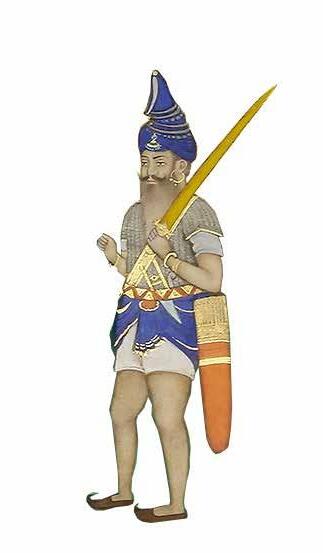
Lot 4
DARBUR OF BHARPUR SINGH, RAJA OF NABHA (REG. 1847-63), ENTHRONED WITH ATTENDANTS AFTER THE UMBALLA DURBAR OF 1860

Nabha or Delhi, circa August 1858.
Gouache and gold on paper.
46 by 31 cm.
Private collection, Germany
Maharaja Jaswant Singh of Nabha died in 1840 and was succeeded by his son Devinder Singh. In 1845, during the Sikh war, Devinder Singh withheld supplies from the British, and as punishment was deposed in 1846 and died in confinement in 1865. Devinder’s son, Bharpur Singh, was installed as the Maharaja in 1847. During his minority, the affairs of state were managed by his grandmother.
Bharpur Singh helped the British during the mutiny of 1857 and was rewarded with the grant of the divisions of Baval and Kanti with permission, later on, to purchase a portion of Jhayar territory. Like other Phulkian chiefs, he was granted the right of adoption, the power of life and death over his subjects and the promise of non-interference by the British in the internal affairs of his state. In September 1863, he was nominated a member of the Viceroy’s Council but died at Nabha shortly afterwards, childless, in November 1863.
Estimate € 10.000 - € 15.000
Lot 5
VIEWS OF THE GOLDEN TEMPLE AT AMRITSAR EUROPEAN SCHOOL



19TH CENTURY
Gouache on paper. An album with nine different views of the Golden temple.

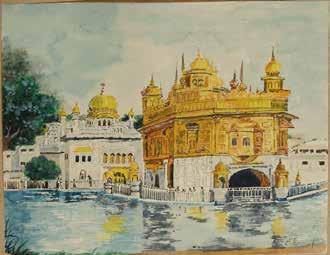
Album: 33 by 26 cm.
Estimate € 4000 - € 6000
Lot 6
KRISHNA AND RADHA AT A PALACE COURTYARD, KISHANGARH, RAJASTHAN NORTH WEST INDIA, LATE 18TH CENTURY

Gouache heightened with gold on paper.
Krishna gazes at Radha, with gold-outlined green nimbuse, set in a palace scene with gopis on all sides of the palace some bathing in a pool.
37.5 by 27 cm.
Estimate € 5000 - € 8000

Leaf from a Ragamala series: Desakh Ragini. Gouache and gold on paper.
32 by 19 cm.
Ragamala paintings are inspired by a genre of poetry that assigned a specific form, mood and ambience to various musical modes .The paintings employ human characters to personify the ragas , and along with various props and architectural compositions ,convey the emotional state of the corresponding music and its poetic symbolism. These illustrations therefore form a bridgebetween music,poetry and painting. This particular Ragamala depicts pursuits of athletics prowess and strength ,including wrestling (considered a noble activity in the Mughal era), as well as weightlifting and archery.
Estimate € 1500 - € 2000

Gouache heightened with gold on paper. Delhi School.
44 by 27.5 cm.
Estimate € 1800 - € 2400

The lady seated on a golden throne and attaching her earrings with the aid of a mirror, with attendants and musician on an open veranda of a palace, green parrots above and roosters in the foreground, an inscription at top Opaque pigments on paper. 26 by 16.5 cm.
In the bilaval ragini, a woman traditionally dons eight types of auspicious ornaments in preparation for her husband’s arrival. Most paintings of this subject depict the woman attaching her earrings (see K. Ebeling, Ragamala Painting, 1973, p. 59, fig C17 and p. 155, fig. 8).
Estimate € 1500 - € 2000
Lot 9
Raag Deepak- An illustration from a ragamala series: a prince and a maiden seated on a palace terrace with attendants. Gouache on paper. Heightened with gold. 25 by 20.5 cm.
Estimate € 2500 - € 3500
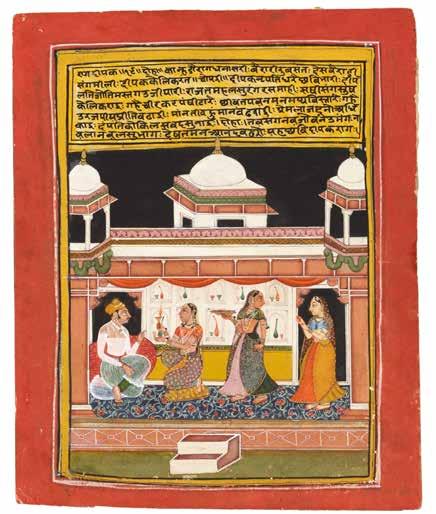
Lot 11
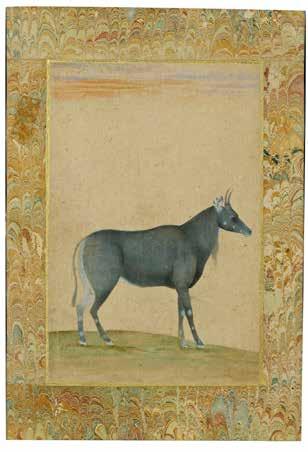
Gouache on paper, the black and white buck stands against a green landscape , between minor gold rules on margins on buff ground, highlighted marbalized border.
18.5 by 12.5 cm.
Lot 12
THE GODDESS KALI GULER OR MANDI, PROBABLY MANDI, NORTH INDIA CIRCA 1820

Opaque pigments on paper, depicted in a classical stance after her killing spree, her tongue struck out, wearing a belt of hands and a necklace of skulls, brandishing a sword, holding a decapitated head, standing over Siva’s body, below with a vulture and foxes, with black borders.
19.5 by 12 cm.
Lot 13
A COLLECTION OF EIGHT DRAWINGS/SKETCHES OF SRINATH JI AND DIFFERENT RULERS RAJASTHAN, KOTA AND NATHDWARA, 18TH CENTURY

Ink and wash on paper, partly pounced along outline, laid down on paper.
Largest: 22.5 by 17.5 cm.
Smallest: 12 by 11 cm.
Estimate € 800 - € 1200
Lot 14
FIFTEEN ILLUSTRATED LEAVES FROM A MANUSCRIPT ON HORSES, INDIA RAJASTHAN, 19TH CENTURY
Pencil, ink and gouache on paper, lines of Devanagari above, narrow yellow border, black rules, buff margins, the reverse of some of the folios with further lines of Devanagari and illustrations.
Drawing: 24 by 17.5 cm.
These illustrations were painted by a company school artist and would have originally been part of an equine medical manuscript. The manuscript is likely to have been a collection of treatments and procedures based on the Shalihotra Samhita treatise.

Estimate
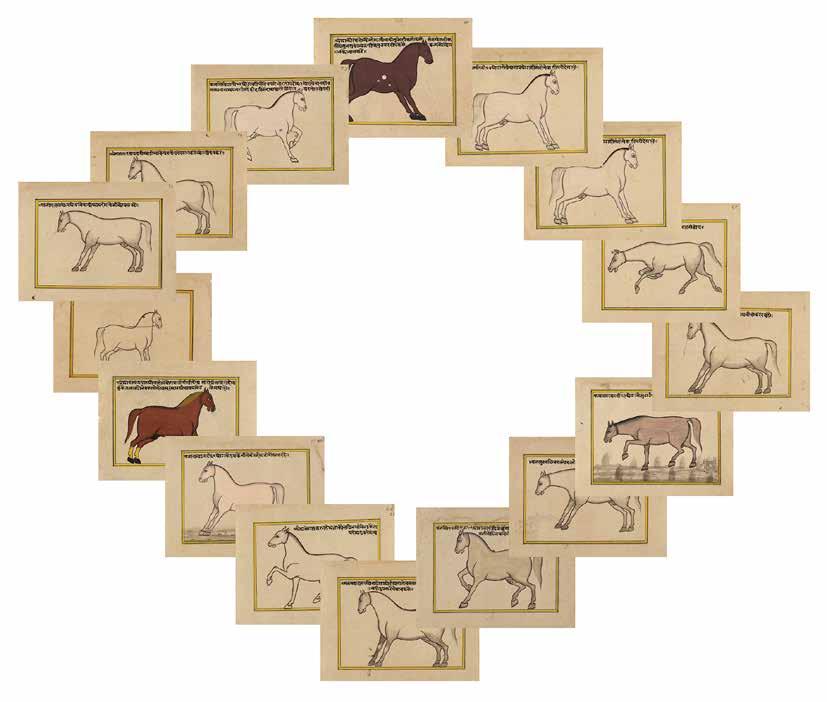
Lot 15
GURU GOBIND SINGH SEATED WITH A FALCON, PUNJAB, NORTH INDIA 19TH CENTURY.

Opaque pigments on textile. 94 by 63 cm.
Estimate € 4000 - € 6000
Lot 16
Gouache heightened with gold on textile, a nimbate Emperor Akbar is depicted in old age, wearing gold flowered pants, a light cream Jama with a red and green turban, falcon held in one hand and a push dagger in the other.

85 by 57 cm.
Estimate € 15.000 - € 20.000
Lot 18
A JAIN MANDALA WITH PADMAVATI GUJARAT
NORTH WEST INDIA, 17TH-18TH CENTURY
Opaque pigments on cloth, the Goddess Padmavati seats in the centre of the upper mandala, other deities and door keepers (dvarapala) around within square panels, each within yellow rules, laid down on textile. 43.5 by 28.5 cm.

Lot 17
THE COSMIC FORM OF HANUMAN POSSIBLY SIROHI, 19TH CENTURY

Gouache and opaque pigments on textile. 89.5 by 63 cm.
Estimate € 3000 - € 5000
Estimate € 3000 - € 5000
Lot 19

Opaque and gold pigments on textile, the standing tirthankara with rows of animals and figures at his chest and upper arms, the jambudvipa at his waist, and rows of further animals and figures at his legs; a standing white and green Deities at top left and right shoulders flanked by the jinas on either side and each surrounded by squares of similar figures.
56 by 41.5 cm.
Estimate € 3000 - € 5000
Lot 20
JAIN MANDALA WITH PADMAVATI, GUJARAT, NORTH-WEST INDIA
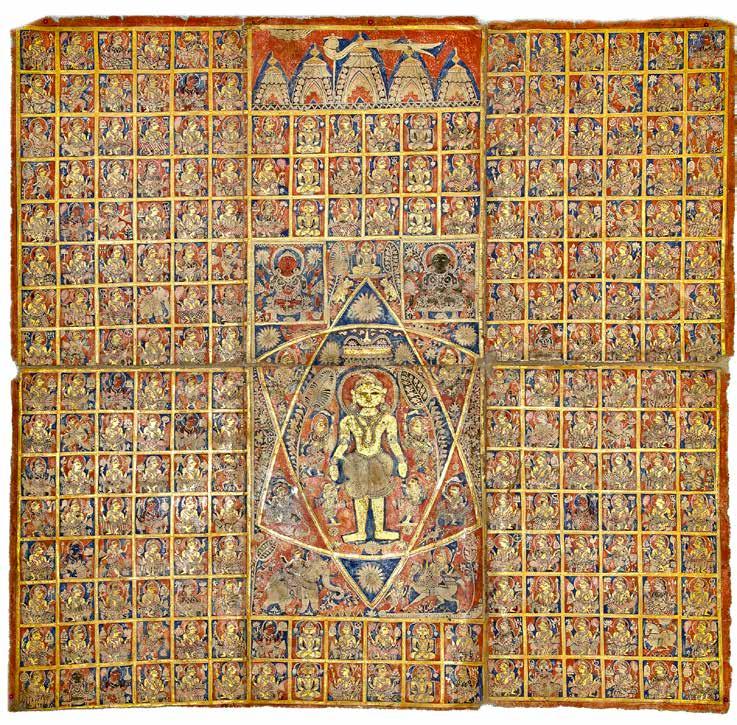
17TH CENTURY
Opaque pigments and gold on cloth, the Goddess Padmavati stands in the centre of the upper mandala, other deities around within square panels, each within yellow rules, laid down on canvas. 61 by 59 cm.
Estimate € 8000 - € 12.000
Lot 21
MAHARAJA SHER SINGH IN DURBAR (B. 1807-D.1843), ENTHRONED WITH ATTENDANTS ATTRIBUTED TO BISHEN SINGH, LAHORE OR AMRITSAR 19TH CENTURY.
Gouache heightened with gold on paper, 37 by 30 cm.
Private collection, Germany
This painting depicts the court of the Sikh ruler, Maharaja Sher Singh, in audience with local ladies flanked by his close circle of ministers, and attendants. He is depicted in the centre seated on his father’s famous golden throne
Estimate € 15.000 - € 20.000

Lot 22
BARAHMASA (TWELVE MONTHS) ILLUSTRATION DEPECTING THE CHARACTER AND SYMBOLISM OF THE LATE SUMMER RAINY, (SRAVANA & BHADON) BUNDI RAJASTHAN, CIRCA 1780
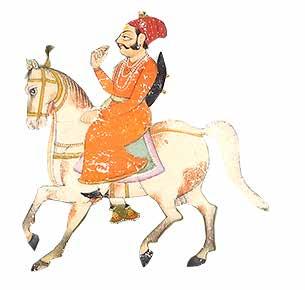

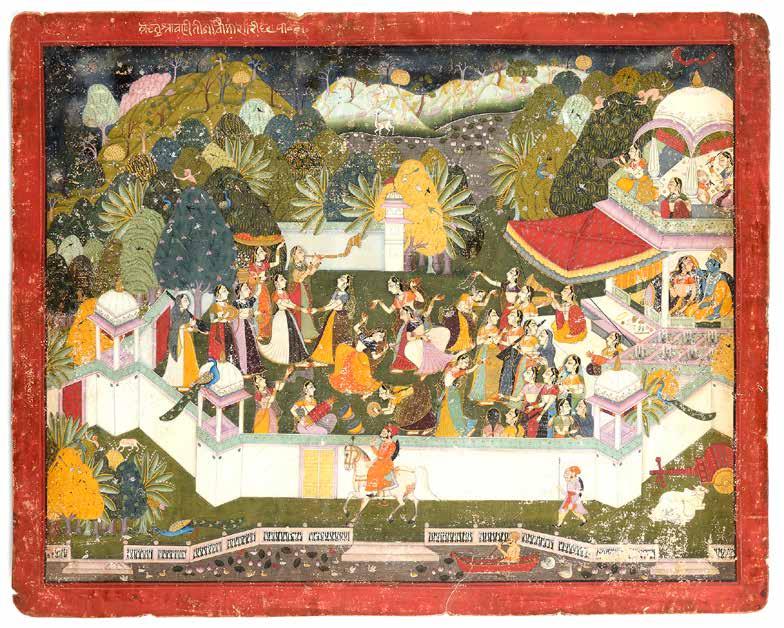
Opaque water color on paper. 50.5 by 39 cm.
PROVENANCE
The V.S. Naipaul Collection. (Object n:2015.311)
Estimate € 20.000 - € 40.000
Lotus-filled lakes and streams coursing with rainwater were ubiquitous aesthetic spaces in the pictorial and poetic imagi- nares of early modern northern India. An eighteenth- century painting, likely made in the town Bundi,near kotah.reveals the elements and emotions associated with the monsoon. Along with the standard tropes of besotted lovers, lightning streaks, thundering clouds, crying peacocks, monkeys, and dears, the painter invites us to savor the lotus-filled lakes created by the onslaught of rain. Blue-hued Krishna and his lover sit together in a courtly pavilion while a group of ladies celebrates the rainy season with dance and song or enjoys its cool breezes, playing on the swings in the verdant landscape. Because ascetic wan- dering and travel were forbidden during these rainy months, on the outside of the wall a nobleman astride a white horse. The artist’s goal was to convey the emotional, social, atmospheric, and sensorial experience of the monsoon season.
On the painting’s border, a scribe notes (Retu Sawani Teez Chaumasa ro Tuohaar). Meaning four months of the rainy season. That the picture depicts the months of Savan (July and August) and Bhadon August and September), covering the anticipated weather cycle of the rains, starting from late summer leading up to the Wetter days. The inscription identifies the painting’s presenta- tion of the bhava of the rainy months. Poetic verses associated with the rainy months of Savan and Bhadon were not always inscribed on monsoon paintings. However, the citation of familiar images and tropes across innumerable paintings persuades us that historical viewers, like contemporary art historians, plausibly related these painterly visions to the literary descriptions that circulated within courtly contexts and beyond. The poetic genre of the barah-masa was the paramount expression of the moods of people, places, flora, and fauna in the rainy season. The barah- masa is always structured as a lament divided into descrip- tions of the twelve months, each expressing the pain of separation when the lover of a nayika, the female heroine or lover in the Sanskrit and Hindi courtly literary tradition, goes abroad.’ The poet Keshavdas, one of northern India’s most prominent exponents on aesthetic theory in Brajbhasha, com- posed an extensive barah-masa in his acclaimed Kavipriya (1601).° His verses describing the rainy months of Savan and Bhadon are in the voice of a woman desperately trying to convince her lover to stay.
The Palace of many moods .Udaipur’s painted lands and Indias Eighteenth century by Dipti Khera.(Page no 69)
A painting from the series is in the Virginia Museum of fine arts, Richmond
Lot 23
TWO MINIATURE PAINTINGS OF SHRI NATHJI, NATHDWARA AND KOTA

RAJASTHAN, 19TH CENTURY.
Priests Worship Shri Nathji of Nathdwara, Rajasthan and Tilkayat Dauji II celebrating Nandamahotsav before Shri Nathji (Kota).
Gouache on paper. 33 by 24 cm and 32 by 23.5 cm.
Estimate € 1500 - € 2500
Lot 24
TWO INDIAN MANUSCRIPTS
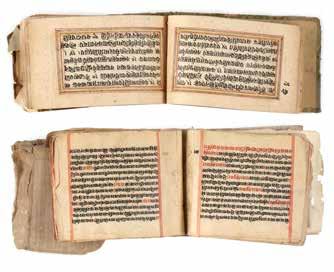
NORTH INDIA, 19TH CENTURY
One book on Jainism with two miniatures and dated SAMVAT1902 the other BHAGWAT GITA. 20 by 13 cm 14 by 9 cm.
Estimate € 500- € 800
Gouache on paper.
An illustrated manuscript with fifteen leafs and eight miniatures.
The name of the book is Chinta Mani Granth written by Ram Pratap Brahman dated Samvat 1962. Containing 24 dohas(poems).

Painting: 20 by 13.5 cm.
Manuscript: 25.5 by 16.5 cm.
Estimate € 1500 - € 2000

A Ramayana by Tulsidas with 53 illustrations. Printed on request by Miyan Chiraguddin Sirajuddin. Printed at Victoria Press, Lahore.
Estimate € 1000 - € 1500


Arabic manuscript on paper, 30 volumes, 5 lines to the page, written in Sini script in black ink, verses separated by red florets, surah headings in red cursive script amidst red panels, text within red rules, tajwid and diacritics in red ink, the two opening with illuminated rectangular panels comprising three lines of text, the borders of the panels decorated with floral and geometric gold motifs.
30 volumes
20 by 25 cm.
The spread of Islam into China began during the Song period in the tenth century. Almost a century later, in the year 1070 AD, a Muslim community mainly composed of soldiers and mercenaries had been officially established by the Emperor in the harsh northern territories to act as a buffer zone between China and her enemies. With the ascent of the Mongols (1260-1368) Muslim China began a new phase, with Muslims rising to positions of power and importance under the Yuan. Later, the Ming period (1368-1644) saw a decrease of Muslim power, and the community became increasingly Sinified as their rights were withdrawn. Their isolated communities were increasingly integrated by the indigenous Chinese, and their social, economic and religious freedom was gradually inhibited. The Muslims took Chinese names, wore Chinese clothing and often married into indigenous families until eventually the Muslims thought of themselves as Chinese. However, their cultural heritage became more important to them as it slipped away, thus the community’s Sinicisation went hand in hand with the preservation of the language, particularly in religious life. By the end of the sixteenth century, Arabic and Persian books had been translated into Chinese and were circulating throughout the Muslim community.
Estimate € 14.000 - € 18.000
Lot 29
Arabic manuscript on paper, interlinear Persian translation, 14 lines to each page, written in black Kufic script, diacritics in red, rosette verse markers outlined in black, occasional marginal floral motifs indicating the juz.
Folio: 25 by 37 cm.
Inscriptions
surah Al-Nisa v.23-v.28
Estimate € 2000 - € 3000
Lot 28
Comprising the 4th and 5th juz’, Arabic manuscript on paper, 36 leaves, each folio with 11 lines of elegant black naskh script, surah headings in gold thuluth script outlined in black, Basmallah in white Kufic script, gold and polychrome rosette verse markers outlined in black and pointed by blue dots, ruled in blue and gold borders, tajwid in red, occasional marginal floral motifs indicating the ‘Juz, Hizb, Aushr and Khums’, colophon of each surah with gilt and blue decoration, in black morocco binding with gilded decoration.

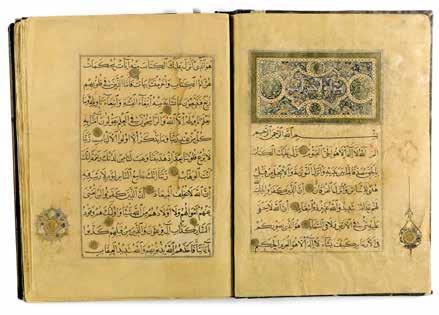
Text: 14.5 by 22 cm
Folio: 23 by 31.5 cm
Estimate € 8000 - € 12.000
Lot 30
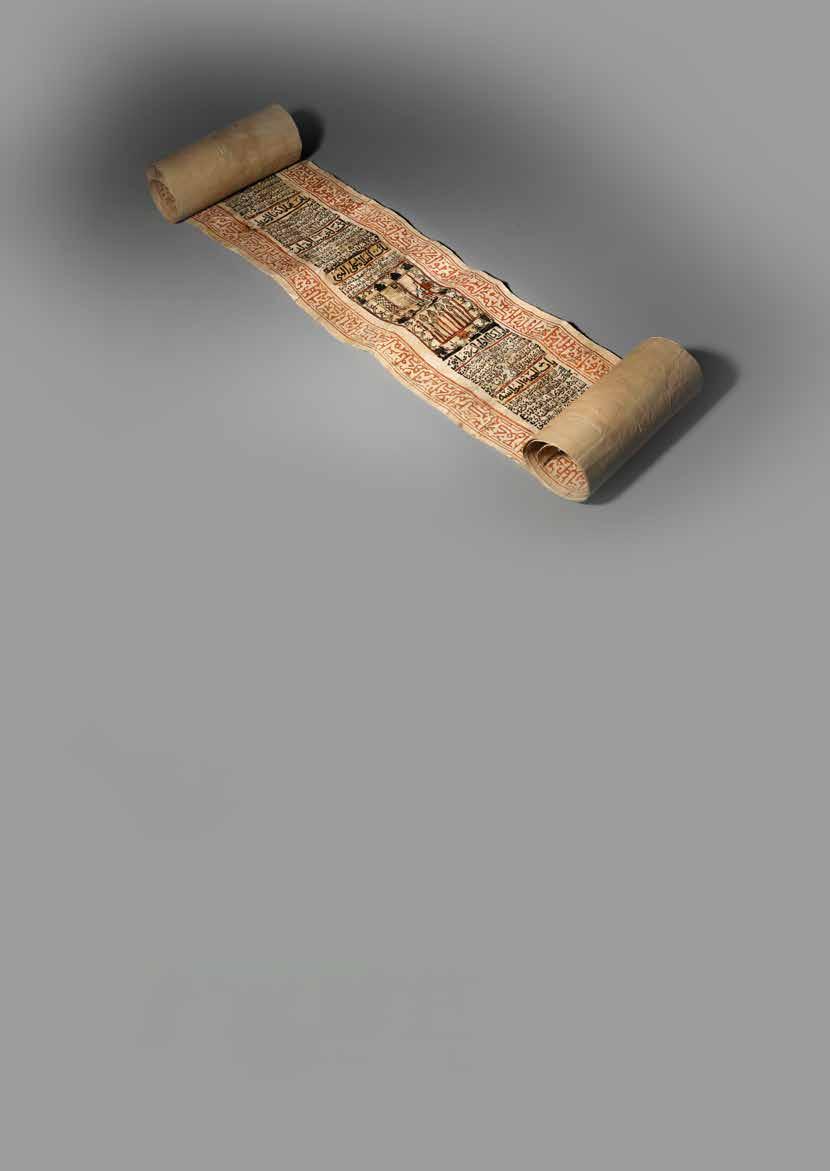
Arabic manuscript on paper, written in Maghribi and angular Kufic script in black and red ink. 135 by 15.5 cm.
Surah Al-Ikhlas is written 12 times in angular Kufic script in red ink, as a frame for the entire scroll. Scroll’s sections:
1.Description of Mecca is honored by Allah (God). This part includes verses 97-98 from Al Imran’s Surah and part of verse 185 after starting by the name of Allah (God).
2.Verses 3 to 5 from Al- Mulk’s Surah to keep pains and illnesses away.
3.Description of the doomsday, verses 105 to 109 from Taha’s Surah.
4.Verses to enhance safety from Al-Furqan’s Surah 22 to 24.
5.Tongue’s function and its acceptance which includes verses 22 to 26 from Al-Ma’idah’s Surah.
6.Demise of enemies, verses from Al- Nahel’s Surah 10 to 14.
7.Verses to facilitate dystocia, this part includes interpretation of verse 34 from Luqman’s Surah.
8.Verses to praise the prophet, verse 56 from Surah Al- Ahzab.
9.Verse to tranquilize children during their sleep, verses 21 to 27 from Al-Kahf’s Surah.
10.Verses to spread love and relief, and it includes some supplications.
11.Verses to overcome remorse enhanced by the commentary on verse 88 from Hud’s Surah.
12.Supplications for dropsy with the commentary on verse 54 from Al-A’raf’s Surah.
13.Musa and Yahia, this section is marked by a drawing of Musa’s stick snatching the sorcerer’s talismans. The drawing is surrounded by verses 15 to 85 from Taha’s Surah with the words Mohammad, Taha, and the Star of David on the left side.
There are three decorative drawings in the form of beacons, niches, and domes. The six-pointed star, a familiar symbol in Islamic art, is usually called ‘Solomon’s seal’.
Estimate € 8000 - € 12.000
Arabic manuscript on paper, 33 leaves, with 2 fly-leaves, 5 lines to each page, written in very elegant large black muhaqqaq script, gold rosette verse markers outlined in black and pointed in red dots, surah headings in large black thuluth script within gilt and polychrome decorated cartouches, occasional marginal gilt floral roundels indicating “ Hizb, Nisf and Juz”.Two opening pages with gilt and blue decoration framing 3 lines in clouds reserved on a red floral sprays decorated ground.In black morocco binding.

Inscriptions
surah Al-Waqiaa v.77-v.80, surah At-Tubah v.94-v.129, surah Yunus complete, surah Hud v.1-v.5. 30 by 45 cm.
Estimate € 20.000 - € 30.000
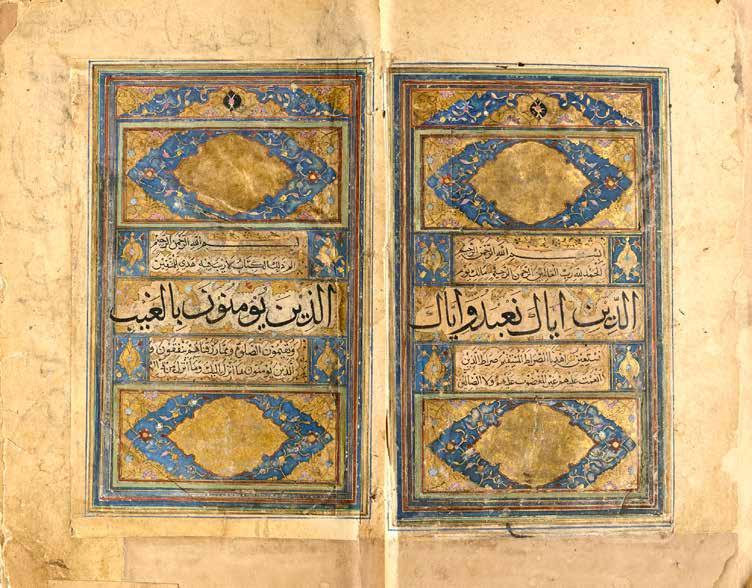 ABDULLAH IN 924 AH/1518 AD
ABDULLAH IN 924 AH/1518 AD
Arabic manuscript on cream paper, each page with 15 lines. The first, central and the last line in very elegant black thuluth script, the other 12 lines arranged in two blocks of 6 lines, each of very strong naskh script within gold and polychrome border outlined in black, gold roundel verse markers outlined in black with blue dots. Surah headings in red thuluth script on a decorated panel, occasional marginal notes of “Khums, Nisf and Hizb”, tajwid in red. Two opening biofolia heavily with gilt and polychrome decoration framing 4 lines of naskh script and 1line of large black thuluth script in clouds reserved on a gold striking ground. Final folio signed by ‘written by Abdullah in 924 AH.’
In black morocco binding stamped with gilt floral motifs.
Text: 9 by 15 cm.
Folio: 14 by 21 cm.
Estimate € 12.000 - € 15.000

Comprising the 15th juz’, Arabic manuscript on paper, 18 leaves plus two fly-leaves, each folio with 11 lines of black thuluth script, Basamallah in black muhaqqaq script, gold and polychrome rosette verse markers pointed in blue, ruled in blue and gold borders, tajwid in red, occasional marginal floral motifs indicating the ‘Juz, Hizb and Aushr’. The colophon of each surah with gilt and blue decoration, in black morocco binding with gilded decoration.

Text: 15 by 22 cm.
Folio: 24 by 32 cm.
Estimate € 12.000 - € 15.000
Lot 34
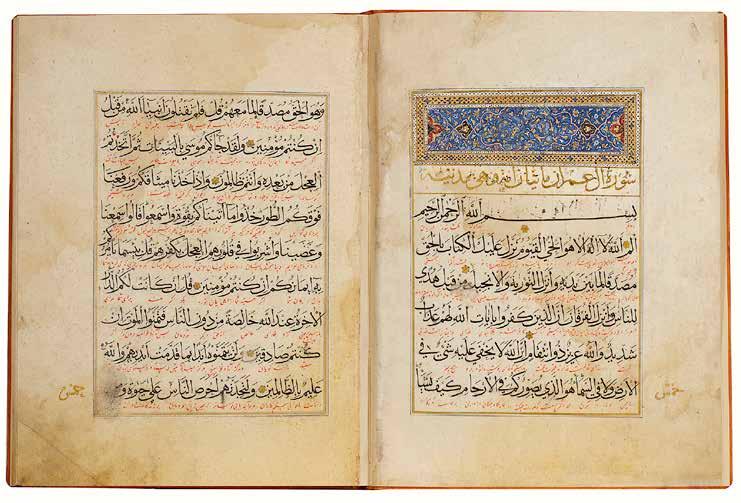
Arabic manuscript on paper, with later added interlinear Persian translation, 45 leaves with 2 fly-leaves, 9 lines to each page in elegant black muhaqqaq script within a gilt and polychrome borders. Surah heading in gold thuluth outlined in black within a cartouche, opening biofolio with striking blue and gilt decoration. Gold verse markers outlined in black and pointed in blue dots, gilt occasional marginal “Hizb, Aushr and Juz “markers.
In light morocco binding stamped decorated with floral motifs.
Text: 15 by 21 cm.
Folio: 24 by 31 cm
Inscriptions
surah Al-Imran with 200 verses.
Estimate € 10.000 - € 15.000
Lot 35
Arabic manuscript on cream paper, 20 leaves with 3 fly-leaves, each page with 9 lines. The first, central and the last line in very elegant black Muhaqqaq script, the other 6ll. arranged in two blocks of 3 lines, each of very strong naskh script within gold border outlined in black, gold roundel verse markers outlined in black, Surah headings in red and gold thuluth script on a decorated panel, gold marginal floral motifs, tajwid in red. Two opening biofolia heavily with gilt and polychrome decoration. Final folio signed by ‘written by Ahmed al-Rumi in 858 AH.

In brown morocco binding with flap stamped with floral motifs.
Inscriptions: v.56 -v.93 from surah Al-Naml, surah Al-Qasas, v.1-v.45 from surah Al-Al-Ankabut
Text: 10.5 by 16 cm.
Folio: 19 by 26 cm.
Estimate € 20.000 - € 30.000
Lot 36
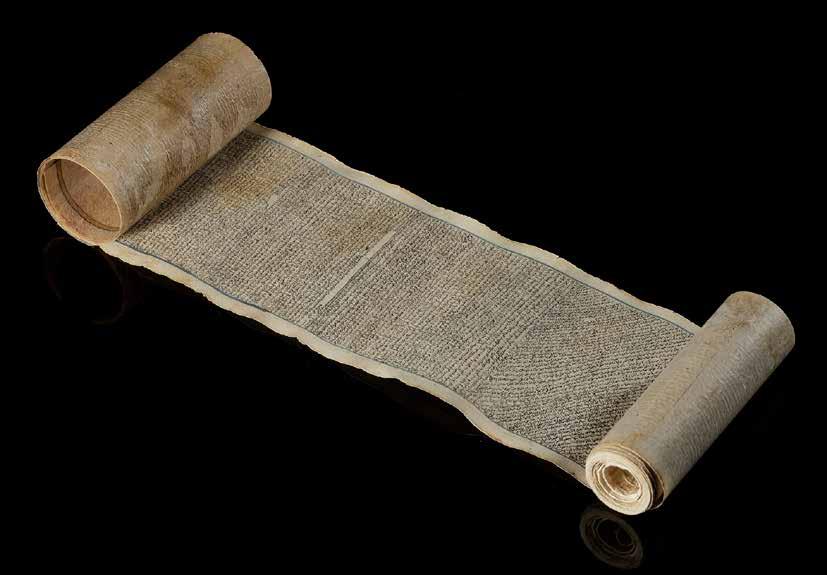
17TH CENTURY
Arabic manuscript on paper in scroll form, written in black ghubar script of the whole Quran, the headpiece with gold and royal blue decoration enclosing surah al-Fatiha in naskh script.
7 by 220 cm
Estimate € 3000 - € 5000
DALA’IL AL-KHAYRAT BY MUHAMMAD BIN SULAYMAN AL-JAZULI (D. 1465 AD)
SIGNED MEHMED LATIF, OTTOMAN TURKEY, DATED 1245 AH/1829 AD
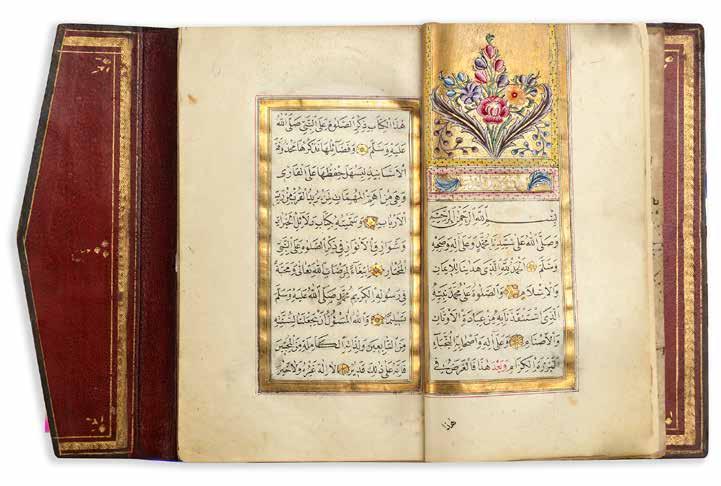
Arabic manuscript on paper depicting prayers in honour of the Prophet Muhammad, 108 leaves with 3 fly-folio, each folio with 11 lines written in elegant black naskh script, with gold verse markers pointed out in polychrome dots, some words picked out in red, text within double gold and red rules, two opening biofolio with royal gold and rococo-style decoration.
Further two detailed illustrations Mecca and Medina with Al-Masjid AL-Haram and Al-Masjid AL-Nabawi, different attributed names to the Prophet, occasional marginal floral motifs, colophon signed ‘Mehmed Latîf Efendi student of Mehmed Sakir Efendi and dated 1245 AH’
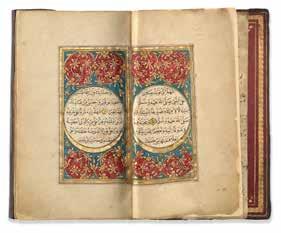
In original tooled and stamped gilt brown morocco binding with flap. 10.5 by 17 cm.
Estimate € 8000 - € 12.000

Arabic manuscript on paper, each folio with 15 lines of elegant black naskh script, diacritics and vowels in red, marginal occasional notes indicating ‘Juz’ and Hizb’, text within red and blue rules, surah headings in thuluth red script, two opening bifolia fully illuminated in gold and polychrome decoration framing 7 lines of elegant naskh script in clouds reserved against a sprinkled ground.
In gilt lacquer binding with central cartouche surrounded by spandrels containing scrolling floral vine.
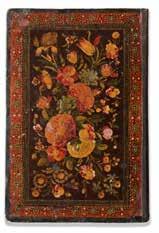
Text panel: 12.5 by 21 cm.
Folio: 20 by 30.5 cm.
Estimate € 8000 - € 12.000
Lot 39
TWO QURAN PAGES, ATTRIBUTED TO YAQOT AL-MUSTAISIMI 13TH CENTURY LATER ILLUMINATION AND DEDICATION, PERSIA, 16TH CENTURY

Arabic manuscript on paper, 11-13 line per page, written in black naskh script, surah headings in large thuluth script outlined in black, the Basmallah in elegant muhaqqaq script, marginal commentary notes in nastaliq Persian script in clouds reserved on a gold sprinkling ground. Gold verse rosette markers outlined in black and pointed with polychrome dots, all ruled in blue and gold borders.
Inscriptions: surah Al-Ikhlas, surah Al-Nas, surah Tabbat Yada and surah Al-Falaq.
Text: 11 by 15 cm.
Folio: 18 by 27 cm.
Estimate € 20.000 - € 30.000
One page bears a colophon with the name Yaqot al-Mustasimi ( Yaqot bin Abdullah) and the date Jumada II 666 AH (February 1267 AD). The legendary calligrapher Yaqot, Master of the Six Pens, remained famous for centuries after his death in 1298 and his works are sought after to this day. Over the centuries his penmanship was frequently imitated and emulated by various scribes, who often copied manuscripts signing with his name.
Calligraphic exercises by the great masters were often cut and laid down on album pages, see for example a calligraphy signed by Yaqot with later sixteenth century Persian illumination sold at Christie’s London, 20 October 2016, lot 12, and an ‘unwan from the Shah Jahan album, which combined a text written by the Timurid calligrapher Mir ‘Ali with a refined Mughal illumination dated to circa 1640.
Lot 40
TWO MAMLUK QURAN FOLIOS, EGYPT OR SYRIA 14TH CENTURY
Arabic manuscript on paper, each folio with 17 lines of large black naskh script, diacritics and vowels in red, gold rosette verse markers outlined in black with polychrome dots, large gilt and polychrome floral marginal medallions indicating “juz,Nisf and hizb”. The names of the surah in gilt ink outlined in black within decorated cartouche.
Inscriptions: surah Ash-Shu’ara v.149- v.227
Folio: 26 by 33 cm
Estimate € 2000 - € 30001
Lot 41
THREE MAMLUK QURAN PAGES EGYPT OR SYRIA, 13TH-14TH CENTURY
Arabic manuscript on paper, 9 lines to each page, written in black Muhaqqaq script, with gold rosette verse markers pointed by polychrome dots, diacritics in red.

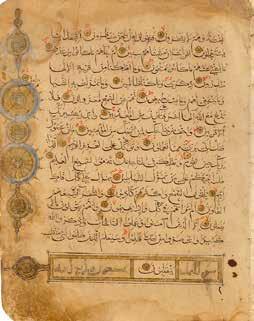
Inscriptions: surah Al-Tawbah v.100-v.120. 22 by 30 cm.
Estimate € 2000 - € 3000
Lot 42
MUHAMMAD BAQIR IBN MUHAMMAD TAQI MAJLISI (D.1698 AD), ZAD AL-MA’AD, PERSIA QAJAR, COPIED 1243 AH/1827 AD
Arabic and Persian manuscript on paper, each folio with 21 lines written in black naskh and nastaliq script, parts with Persian interlinear translation in red nastaliq script, text within gold and polychrome frame, catchwords and keywords in red and blue, opening bifolio with finely illuminated headpiece, marginal occasional notes in black and red, colophon dated Ramadan 1107 AH/1695 AD in Asfahan, with later added notes, ownership statements and seals.

In original Qajar floral lacquer binding.
Text panel: 10 by 19 cm.
Folio: 15 by 24 cm.
Estimate € 10.000 - € 20.000
Zad al-ma’ad is organized into 14 chapters with an epilogue. The first nine chapters are about supplications and religious practices in 12 lunar months, which at first gave an introduction on the religious virtues of each month followed by the supplications, ziyara and religious practices of each day and night of every month. In the tenth chapter, the supplications which are common in all the months are stated. In the eleventh chapter, ziyarah of the fourteen infallibles are stated, which were not mentioned in the last chapters. The thirteenth chapter is about the religious practices on dead people and funeral ceremony. And lastly the fourteenth chapter gives a summary on the rules of khums, zakat and i’tikaf (a period of retreat). And finally the epilogue is about kaffara (expiation).
Muhammad Baqir ibn Muhammad Taqi Majlisi born in 1627 was Shaykh al-Islam during the reign of Safavid Shah Sulayman (r.1666-94). One of the most famous Muslim scholars in jurisprudence and hadith and also among the most influential government officials of Shi’a in Safavid era and the author of Bihar al-Anwar which is a hadith collection.
He was an expert in several Islamic sciences such as Tafsir, hadith, jurisprudence, Usul, history, Rijal and diraya, philosophy, logic, mathematics, literature, geography, medicine, astronomy and occult sciences.

Lot 43
AL-KHAZAN AL TASRI, DATED 683 AH/1284 AD
Arabic manuscript on paper, in 2 volumes, the first 49 leaves, plus 2 fly-leaves, the second 158 leaves, plus 3 flyleaves (2 detached), each 21 lines to the page, written in neat naskh script in dark brown ink, chapter headings written in large thuluth script, Basmallah in muhaqqaq script, keywords picked out in red, vol.1 with illuminated double-page frontispiece with 2 shamsas, f.1 added in the 14th century, title information in large thuluth script against a foliated gold ground, each volume in later bindings, one cloth-covered, the other leather with simple gilt decoration. 23 by 30 cm.
Estimate € 80.000 - € 100.000
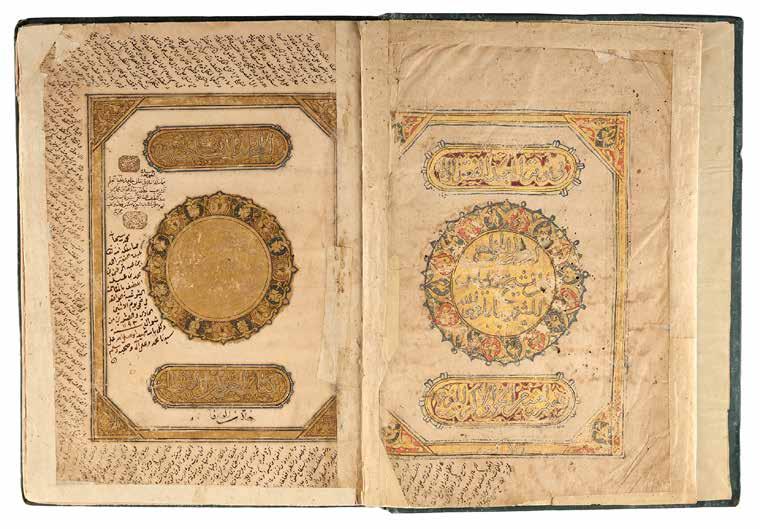
f.1b: ‘In his turn, the poor slave Alvan (Elvan) ibn ‘Ali al-Mukhlis ibn al-Shaykh Ilyas, known as Baba, may God be pleased with them and curses of the great fear and terror …[took possession of it]’
1- The first book : the fourth section in terms of its arrangement with 11 message or articles.
a- The first message : Mental principles according to the Pythagoreans, the reason for people’s different morals, difference in information perception, the differences in the realization of the effective powers, human senses and how to strengthen them, imagined powers and differences between people in them, the advantages of these powers, principles of argumentation, good and evil in human soul, differences of people’s desire etc..
b-The second message: Mental principles according to the authors of the book, ethnological and human sciences in finding the way to Allah, refining the soul and reforming morals.
c-The third message: in the belief of Ikhwan al-Safa and the matter of the soul: explains how they look at the human soul, what controls it, the virtues and the souls according to different prophets.
d-The fourth message: Passive Intellect, They urge the learners to look closely at all kinds go knowlegde, research all the sciences, and not to neglect one of the chapters of knowledge, they explain also the reference they used, opinions and and the ideas they called for.
e-The fifth message: The nature essence of faith and the characteristics of the faithful believer, the types of people in terms of faith, namely: a scholar who is not a believer, a believer who is not a scholar, and he who has lost his lot from the two, and he who is a scholar and a believer.
f-The sixth message: Divine law and terms of prophecy.
g-The seventh message: Divine and legal sciences in how to call to Allah.
h-The eighth message: Actions of the spirituals, they explain the connection between the spheres and the types of souls and the influencing and affected forces between the spheres and spirits.
i-The ninth message: Types of policies, reforming the soul and its morals to complete its happiness in this world and the hereafter.
j-The tenth message: Physical principles and the purpose of the world: Pythagoras was a wise man of Harran, was very careful to look at the science of numbers and the oneness of Allah.
k-The eleventh message: Magic and talismans.
f.2a, in the roundel:
‘For the treasury of … of earthly beings, the greatest Shah of all creatures, Khwajah Ghiyath al-Dunya (?) …. wa’l-Din, calling upon the aid of The Defender, the Creator’. The second book is the third section in terms of arrangement for the entire letters/articles, starting with the fifth letter until the tenth letter.
a-The fifth message: The universes, the meaning of what the philosophers said about spirituality and the planets, races of the angels, and how their powers flow in the world.
b-The sixth message: nature, quantity, and types of love, what the philosophers said about the nature of love, the quantity of its types, how it arises and its principle, and what causes it to exist, and the reasons calling for it, and what is its ultimate purpose.
c-The seventh message: The nature of the resurrection, the method of the ascension, the reality of the resurrection, and the abode of the Hereafter.
e-The eighth message: The nature of movements, the quantity of their types, and the directions, movement is a spiritual image that the soul makes it in the bodies, makes its shapes, images and colors and in it the bodies are pictorial and engraved.
f-The ninth message: Causes and Effects, the knowledge of how is before knowledge of quantity.
g-The tenth message: borders and compositions, the knowledge of the realities of things is knowledge of their elements and borders, and that all things are of two types, compounds and substances. 24 by 32 cm.
This manuscript is a rare and early dated copy of an extremely important and interesting work known as the Rasa’il Ikhwan al-Safa, a medieval Islamic encyclopaedia that represents the landmark legacy of a mystical group of Iraqi scholars and thinkers who aimed to save Islamic teaching from the perceived threat of liberal sciences by means of philosophy. To the best of our knowledge, it is the third earliest copy in existence, dated 683 AH/1284 AD.
Of equal interest are the previous owners of the manuscript. It was initially dedicated to Khwajah Jahan (Hace-i Cihan, also known as Hoca Cihan), a Sufi saint, scholar and statesman in the Seljuk Sultanate of Rum. Later, in the fourteenth century, the manuscript entered the possession of Elvan (Alvan) Çelebi (d. after 135859 AD), a descendent of Baba Ilyas Khurasani, whose tomb in the dervish lodge he founded remains one of the most visited shrines in Anatolia.
The Ikhwan al-Safa was a secret brotherhood thought to have been affiliated to the Ismai’li movement. Their true identity was so thoroughly hidden that scholars can only speculate as to their real associations. The Rasa’il however are considered to be central to Isma’ili doctrine, and have been attributed to the authorship of various different Shi’a imams, and scholars from the eleventh century. Given the esoteric nature of Shi’a Isma’ilism, one can understand why they even referred to themselves (in the fourth Rasa’il) as “sleepers in the cave”. Although the Ikhwan remained an anonymous group of scholars, the literary scholar Abu Hayyan al-Tawhidi (d.1023 AD) is thought to have identified three members, all of whom were from Basra: Abu’lHasan ‘Ali Ibn Harun al-Zanjani and three of his companions, Abu Sulayman Muhammad Ibn Ma‘shar al-Busti, (called al-Maqdisi), Abu Ahmad al-Nahrajuri and al-‘Awfi.
The manuscript to hand represents half of book three and the whole of book four. The four books of the Rasa’il Ikhwan al-Safa are as follows:
1. The mathematical sciences
2. The natural sciences
3. The rational sciences
4. The theological sciences
Among dated copies of the Rasa’il, the present manuscript only appears to be antedated by the famous copy in the ‘Atif Pasha Library, Istanbul (1681), dated 587 AH/1182 AD, and the copy formerly in the British Museum, now in the British Library (Or 6692), dated 646 AH/1248-49 AD. A further copy is in the Majlis-i Shura-yi Milli, Tehran 4707, dated 686 AH/1287 AD.
Manuscripts of the Rasa’il al-Safa appear very rarely on the market. A lavishly-illuminated copy comprising only book one of the full work was sold at Sothebys , 20 April 2016, lot 35, and another dated 711 AH/1311 AD on 9 April 2008, lot 28.
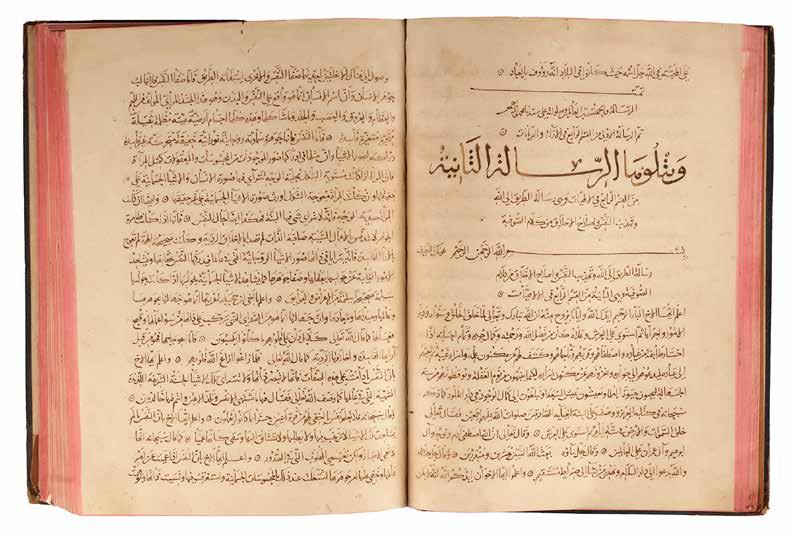


Cylindrical pot supported by a ring foot, small shoulder and low neck with rim round. The decoration reproduces an inscription in Kufic, which repeats the word several times ‘Allah’ on the body; while on the shoulder, the inscription, with a thinner and faster line, seems correspond to pseudo-Arabic (the painter probably did not speak or write this language). The texts are rendered in negative, since they come out in white (the color of the glaze) between the golden brown outlines of the paint. The function of these pots was, originally, that of containing spices (in Iran from the 9th century and in Syria a little later, from the12th century), but also drugs and ointments used in pharmacy. Called al-biram in Arabic (earthen pots), they will experience great fervor also in Europe under their Italian name of albarelli. The execution technique, called the metallic luster technique, is one of the most important contributions of Islamic craftsmen to the development of ceramics. Earth fired (light beige in this case) is first covered with a glaze (here creamy white) and then baked for the first time in an oxidizing atmosphere up to about 900o -1000o.
After cooling, the decoration is executed with a mixture based on silver oxides and/or of copper mixed with ocher and diluted with vinegar: the vase is then annealed, this time in a furnace without oxygen supply (reducing atmosphere), at a lower temperature (600o -700o). The glaze, softened by the heat, can thus incorporate the paint into a very thin and very shiny. Probably invented in Iraq, the center of power of the Abbasids, between the 8th and 9th centuries, this technique was widely used by the potters of Cairo under the Fatimid dynasty, in the 10th and 11th centuries, before being transmitted to the Iranian and Syrian worlds.
Conditions: Complete, in excellent condition. Minor chipping or chipping (foot); paint very shiny, in places a little faded, especially on the inside.
Height: 12 cm
PROVENANCE
Private collection, Switzerland
Terres d’Islam, The Middle Eastern ceramic collections of the Ariana Museum in Geneva, Geneva, 2014, no. 63, p. 73-74; no. 68, p. 83. WATSON O., Ceramics from the Islamic Lands, Kuwait National Museum: The Al-Sabah Collection, London, 2004, pp. 289ff; p.p. 346ff.
Estimate € 20.000 - € 30.000
Lot 45
A KASHAN LUSTRE SPRINKLER FOR ROSEWATER, PERSIA, CIRCA 1200
A Kashan lustre pottery rosewater sprinkler with squat circular body and tapering neck with everted rim, painted in dark and yellowish brown on a cream ground, with bands of cursive calligraphy and birds amidst foliage, kufic inscriptions and foliate motifs in bands encircling the neck.

Inscriptions: verses in Persian. Lustre rosewater sprinklers are unusual, stylistically this piece belongs to Watson’s third Kashan type.
Height: 18.5 cm.
PROVENANCE
Ex. Sotheby’s London , 25th April 1996, lot 46
Estimate € 14.000 - € 18.000
Lot 46
A LUSTRE PAINTED TURQUOISE GLAZED OCTAGONAL TILE
SYRIA, 11TH-12TH CENTURY
The octagonal tile painted with a central square panel issuing scrolling floral designs from each corner, the central square panel filled with four renderings of the name of the Prophet Muhammad, surrounded by the first four caliphs, glaze completely and evenly iridised.

Diameter: 11.2 cm.
The style of script seen here, coupled with the form of the scrolls, clearly both point to an origin that is not in line with pottery from 13th century Kashan or Syria. The form of the waw in Abu Bakr however indicates a date of the 11th or 12th century, probably no earlier.
PROVENANCE
Ex-Swiss private collection
Christie’s Lnd, Art of the Islamic and Indian Worlds, 7 oct. 2008, lot 1412
Siliceous paste,
The thin-walled, fragile vase is supported by a small annular foot; its spherical but squashed body ends in a vertical rim. The two handles are modelled in the shape of panthers arranged vertically, the hind legs resting on the body of the vase and the front ones higher up, near the lip. The potter added two cylindrical false necks, shaped like the neck of a swan, at the rim and between the handles. Their purpose was probably decorative, as they are not pierced towards the inside of the vase.
The painted scene and its rich polychromy, based here on the use of blue, reddish-brown and sky-blue, brown and black, on the greyish-white surface of the vessel, are typical elements of the Islamic ceramic style known as minâ’i. The frieze, which runs the full length of the available space, features four horsemen on their mounts, riding towards the viewer’s left: they are separated by polychrome geometric motifs. An inscription imitating Arabic characters adorns the inside of the border. The riders are dressed in a sleeved tunic and wear trousers; their feet are slipped into the stirrups.
The ceramics, known as minâ’i (a Persian term in modern usage meaning glazed) or haft-rang (Persian for “seven colours”), use the technique known as petit feu decoration, a highly elaborate process that sometimes involves up to three different firings: one for the paste and glaze, another for the metallic lustre, when present, and the last to fix the colours.
In vogue for only a few decades between the end of the 12th and the beginning of the 13th century AD, minâ’i ceramics represent one of the most important developments in Islamic ceramics: its centre of production was in Kâshân, in central Iran.
The technical difficulties involved in making these vessels and the fragility of the finished product meant that they were highly luxurious objects intended exclusively for the wealthier classes. Complete and in good condition, but glued back together from a large number of fragments; frequent re-filling and paint retouching.
Height: 17.5 cm
Private collection, Switzerland
Formerly Japanese collection, collected in the 1980-90s.
Terres d’Islam, Les collections de céramique moyen-orientale du Musée Ariana à Genève, Geneva, 2014, nos. 70-72, pp. 84-85.
VON FOLSACH K., The David Collection, Islamic Art, Copenhagen, 1990, pp.76, 99, no. 115.
WATSON O., Ceramics from the Islamic Lands, Kuwait National Museum: The Al-Sabah Collection, London, 2004, pp.364ff.
Estimate € 10.000 - € 15.000


Of deep conical form, painted in lustre heightened in cobalt blue and turquoise on a cream ground, with a central medallion of swimming fish against a ground of cursive scrolls encircled by a border of sgraffiato calligraphy, the sides with six panels alternately depicting seated princely figures and speckled leopards, divided by vertical bands of calligraphy, the exterior with a band of four cartouches below a now obscured border of calligraphy.
Inscriptions: verses in Persian and dated on the outer rim 602 AH / 1206 AD.
Height: 11.8 cm.
Diameter: 28 cm.
Estimate € 40.000 - € 60.000
PROVENANCE
Ex. Kelekian Collection, Label “lent by Kelekian”, n°53, Ex. Sotheby’s London 1996, lot14.
Exhibited: Formely on loan to the Victora & Albert Museum. With three labels inside the footring, two inscribed with numbers, the third ‘LENT BY Kelekian No. 53’.
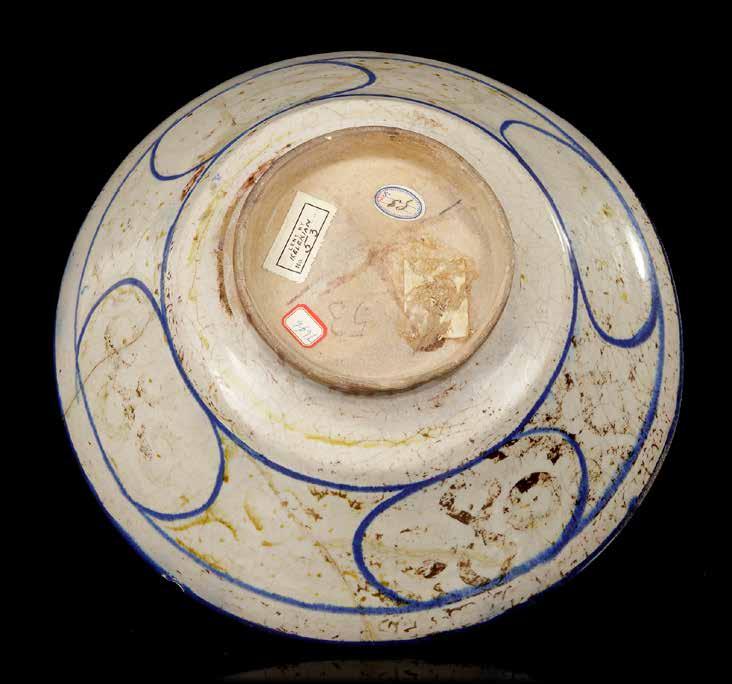
Literature
Pope: Survey of Persian Art, vol II, pp. 1634-35, vol V, pl. 719 A
Lot 49
MUNAJAT OF IMAM ‘ALI BIN ABI TALIB, PERSIA SAFAVID, DATED 1028 AH/1628 AD
Ode to God, the forty sayings of the Imam ‘Ali, Arabic and Persian manuscript on paper, 18 leaves, each folio with 7 lines of large black Arabic nastaliq script alternated with panels of diagonally written smaller black Persian nastaliq script, text panels ruled in gold and polychrome borders, with pink paper margins decorated with gilt birds perched amongst floral motifs.
Opening folio with fine gold and polychrome illuminated headpiece, colophon signed Abdul-Jabar and dated 1038 AH, with ownership statements and seals.
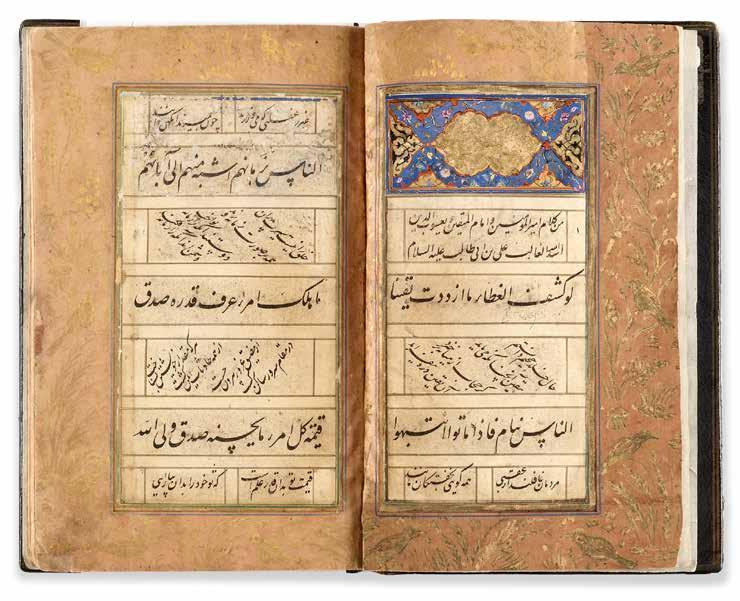
In fine later Qajar lacquer binding decorated with central medallion filled with elegant scrolling vine.
12.5 by 19.5 cm.
Estimate € 10.000 - € 20.000

CENTRAL ASIA, 16TH CENTURY
Black and red ink on paper heightened with gold, 16 leaves each folio with 4 linesof elegant black nastaliq script written diagonally, smaller lines above and below, with gold and polychrome medallions and roundels around, each panel laid down on colored gold-speckled borders, final folio signed in lower left corner. In the 19th century stamped brown morocco binding, with marbled paper doublures.
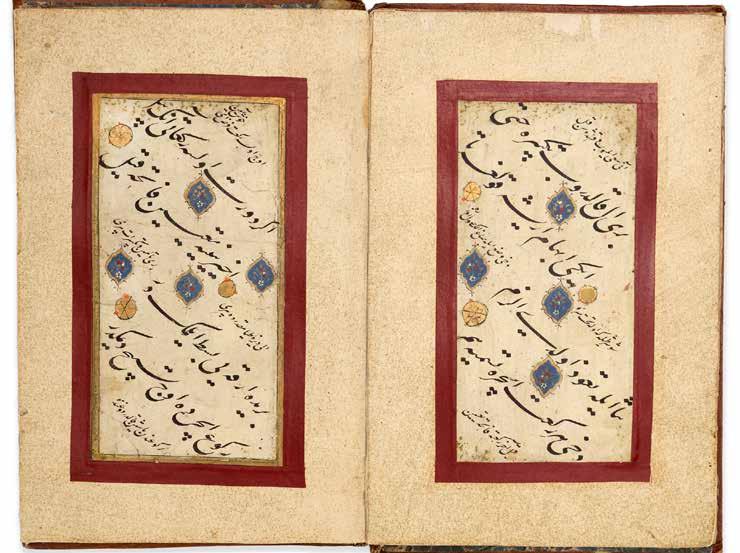
Text panel: 12.8 by 6.4 cm.
Folio: 19.2 by 12.6 cm.
Estimate € 15.000 - € 20.000

This medicine jar is cylindrical in shape, but with a slightly flared wall; it has a small shoulder and a straight rim, and is supported by a small annular foot. The decoration follows a precise pattern, running from the base of the body to the rim. It is made up of alternating vertical stripes in different colours (turquoise, black, cobalt blue) or decorated with pseudo-inscriptions. The cobalt-blue bands feature an arabesque of wavy lines and dots painted in black, visible beneath the blue colour. The original function of these jars was to contain spices (in Iran as early as the 9th century and in Syria a little later, from the 12th century onwards), as well as drugs and ointments used in pharmacy. Called al-birâm (earthenware pots) in Arabic, they were also very popular in Europe under their Italian name albarelli, and this albarello belongs to a group of vases consisting mainly of bowls decorated with panels radiating out from the central point, sometimes referred to as “panel style” in English. In this example, the motifs (arabesques, pseudo-calligraphy, dotted lines), colours (cream slip, black paint, cobalt blue and turquoise) and rays visible above the foot have their counterparts on the bowls, in the internal and external decoration. Despite the clear difference in appearance with the so-called Sultanabad vases, these two styles are often compared, because of the similarities in the subsidiary decorations. Panel-style vases, however, are generally finer and of higher quality.
Condition: complete, in excellent condition despite a few cracks. The paint is partially iridescent or faded, but the main lines of the decoration are nevertheless clear.
Height: 22 cm.
Private collection, Switzerland
Formerly Japanese collection, collected in the 1980-90s
Lands of Islam, The Middle Eastern ceramic collections of the Ariana Museum in Geneva, Geneva, 2014, nos. 73-77, p. 86-89.
WATSON O, Ceramics from the Islamic Lands, Kuwait National Museum: The Al-Sabah Collection, London, 2004, pp. 388-389.
Estimate € 20.000 - € 30.000
Persian manuscript on cream paper, 26 leaves with 11 lines of black nastaliq, headings in gold, copious gold and polychrome floral illumination throughout, final folio with colophon signed by Hasan for his father Nawab Sayyid Muhammad Reza Khan Mubariz al Mulk in the year 1194 (abjad). Gold lacquer binding.

Folio: 22.3 by 15.7 cm.
Estimate € 20.000 - € 30.000
Lot 53
NASAIH HKIMA OR WISE ADVICES BY IBN AL-TUFA’LI
PERSIA, QAJAR DATED 1241 AH/1825 AD
ALI MUHAMMADPersian manuscript on paper, 12 leaves with 3 fly-leaves , each page with 7 lines written in black nastaliq script in clouds reserved against a sprinkled gold ground, catchwords and titles in red and gilt ink, ruled in blue and double gold borders. Opening biofolio with royal blue and gilt decoration framing 4 lines, the broad margin embellished with elegant birds perched amongst flower branches, with ownership statements and seals. The final page signed in red ink with Ibn al-Tufa’li Ali Muhammad 1241 AH/1825 AD. In Qajar lacquer binding, each board decorated with a central medallion enclosing a nightingale perching on branches with a border of floral motifs.

This book contains 40 advices on morality and etiquette, thinking about the consequences of your actions, returning to Allah and his messenger, honoring the parents, choosing the righteous friends, the four reasons for happiness and the principles of pure heart and pure hands.
Text panel: 10.5 by 17 cm.
Folio: 15.5 by 25 cm.
Estimate € 10.000 - € 20.000
Lot 54
NIZAMI (d.1209), KHAMSA, COPIED BY MAHMOUD IBN ISHAQ (ISAAC)

AL-SHIHABI, PERSIA TIMURID, DATED 920 AH/1514 AD
Poetry. Persian manuscript on paper, 45 leaves plus two fly-leaves of different colors, each folio with 10 lines of black nastaliq script arranged in two columns between black-ruled gold intercolumnar divisions, text within black-ruled gold frame, eight finely illuminated headings in gold and polychrome, opening bifolio with extensive illumination in gold and polychrome, the margins sprinkled with gold, the final folio signed by Mahmoud Ibn Ishaq Al-Shihabi and dated 920 AH. In gilt black leather binding decorated with a central panel enclosing floral motifs.
Text panel: 7.5 by 14 cm.
Folio: 14 by 24 cm.
Estimate € 20.000 - € 30.000
Lot 55
Arabic manuscript on paper, comprising 14 panels of calligraphy on album pages laid down on card, each panel with a large line of text in nastaliq script in black ink, surrounded by gilt floral motifs, margins ruled in gold and polychrome borders, the outer borders of colored paper sprinkled with gold, the last panel signed Abdulhalik. In deep brown leather morocco binding. 15 by 26 cm.

Estimate € 10.000 - € 20.000
TWO LARGE MAMLUK QURAN PAGES, EGYPT OR SYRIA


14TH CENTURY
Arabic manuscript on paper, 2ff. with 5 lines to each page, written in elegant black naskh script, gold verse markers enclosing the word “Ayat” outlined in black and gilt borders, marginal gilt and polychrome note roundel indicating “ the Hizb”.
Inscriptions: Surah An-Nisaa v.131-v.136 32 by 40 cm.
Estimate € 800 - € 1200
KHIZANAT AL-FIQH BY NASR IBN
MUHAMMAD ABU AL-LAYTH AL-SAMARQANDI
COPIED 1076 AH/1665 AD
Arabic manuscript on paper, 110 leaves each page with 17 lines written in black naskh script, titles and catchwords in red ink, ruled in green en red, marginal occasional notes in black and red, opening page with gilt and blue decoration. Copied in 1076 AH/1665 AD, with ownership statements and seals, in morocco brown binding with tooled floral decoration.
A book on Islamic jurisprudence (fiqh), deals with topics, such as: Marriage, Dower, divorce, Rights and Obligations of Spouses, Talqah, Wakf, Gift, Will and Inheritance. 12.5 by 19 cm.
Estimate € 2000 - € 4000
A PURPLE BLACK AND GOLD FOLIO, INDIA, DECCAN, BIJAPUR OR GOLCONDA, CIRCA 1600
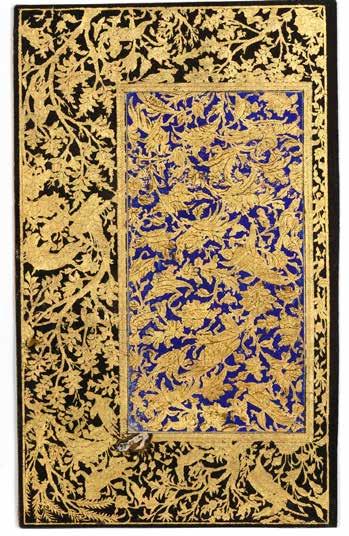
Richly decorated in purple, black and gold, the central panel of the page with an elaborate tree and the second with foliage and birds, surrounded by identical borders filled with wild animals frolicking in the forest. 17.5 by 10.5 cm.
Estimate € 2000 - € 3000
Arabic manuscript on paper, interlinear Persian translation, with 7 lines to each page, written in large elegant black muhaqqaq script, with gold rosette verse markers outlined in blue, illuminated marginal medallion indicating the Juz and written in large thuluth gilt script.

Inscriptions: surah Adh-Dhariyat v.28-v.43, surah Al-Najm v.35- v.62 32 by 40 cm.
Estimate € 2000 - € 3000
Lot 60
A RARE YEMENI SWORD, MADE FOR THE SULTAN BADR BIN ABDULLAH AL

KATHERI, SOUTH ARABIA, EARLY 16TH CENTURY
A sword (saif) with flat slightly tapering double-edged blade, on one side with inscriptions in naskh script, the green mina enameled silver hilt with ribbed pommel, the guard and the grip carved with floral decorations. The leather covered scabbard body with two belt attachment rings, the locket and chape with a similar green mina enamlled and silver carved decoration with traces of gilding.
Length: 106 cm.
PROVENANCE
Private collection, France
Estimate € 30.000 - € 50.000
Early swords from the Arab cultures use to employ straight heavy blades. Curved shamshir style swords were adopted by many Arab communities and cultures around the 10th century, but in two places – Oman and Yemen straight blade swords continued to be used. The well known Omani Kattara sword was in use well into the 20th century. Its Yemeni “sister” is much less common.
The Yemeni sword with straight blade follows the style of earlier Islamic swords. Quite similar to Mamluk swords from the 13th century, not only with its straight blade but also the handle style with a ball shaped or similar rounded pommel. Use of early European blade is also common to these swords.

Badr Abu Tuwaireq, Badr bin Abdullah bin Ali bin Omar Al Kathiri, one of the greatest sultans of the Kathiri Sultanate.
He is considered the first Hadhrami sultan who persevered in unifying the regions of Hadramout and Mukalla. During his reign he reached the farthest limits of the Kathiri Sultanate. He knew that every tribe could declare its disobedience and rebellion and isolate its small areas of rule, harming the great unity of Hadramout and the region.
He was born in 1494, one year after his grandfather Jaafar occupied al-Shihr. He assumed the sultanate after his father in 1520, but the ambition of his brother Badr left him no room for action.
As soon as the year 1520 passed, Abu Tuwaireq was the de facto ruler of Hadramout, and his brother Muhammad remained the ruler of Dhofar. However, Abu Tuwaireq wrested Dhofar from his brother in the year 1540.
He became the ruler with the entire Kathiri state after he made his brother Muhammad ruler of the city of Al-Shihr, worked to form an army from other forces made up of the Turks of the Ottoman army, during the period of Caliph Suleiman the Magnificent, as well as from Jabal Yafea and their loyalists, and from some northern Yemeni regions, in order to be assured of their obedience and non-rebellion, and to fight the rebellious tribes against him in Nahd and Hamum.
During his reign of nearly 50 years (died in1569) had many wars with the Doan tribes, headed by the sheikhdom of the Amoudi family and Siban under the leadership of Sheikh Othman bin Ahmed Al-Amoudi Governor of the Doan Valley. Many of the tribes of Yafaa migrated during his reign to Hadhramaut and remained there to this day.
An outstanding hemispherical bowl, decorated with a black and white pattern painted under a beautiful turquoise glaze. The interlaced motifs intertwine harmoniously with each other, so as to form a large rosette at the center of the vessel. Several other patterns (6) frame the central decoration, representing a double flower, which is also composed of black and white elements. Two friezes of Arabic calligraphic inscriptions adorn the cup, like decorative ornaments. On the inside, Kufic characters, characterized by their angular shape, can still be deciphered; on the outside, the surface is decorated with the much more rounded, cursive naskhi script. Typologically, this cup can be classified in the group of Islamic lusterwares, whose successful process involved two firing sessions: the vessel was first fired to harden the clay, and was then given a second firing to produce the lustrous shine. This technique was probably invented in Iraq, the power center of the Abbasids, between the 8th and the 9th century. Widely used by the potters of Cairo under the Fatimid dynasty (10th and 11th century), it spread to the Syrian world in the 12th century. In Iran, the production of lusterware started in the late 12th century. The city of Kashan quickly became the major center of production.
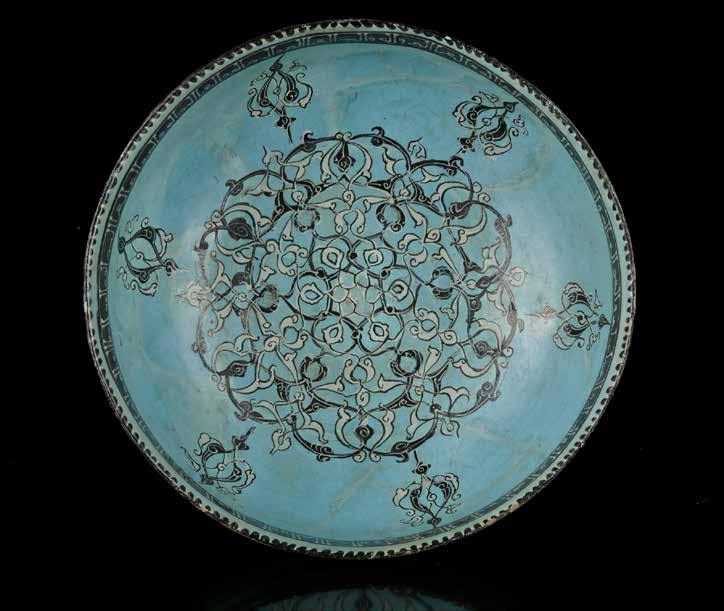
Good overall condition, several restorations, repainting and minor losses.
Height: 8.7 cm.
Diameter: 20 cm.
Estimate € 15.000 - € 20..000
PROVENANCE
Private collection, Sitzerland, acquired 06.2009 on the French art market. Ex-collection Engel Gros. With a label that reads ‘Engel Gros’.
PANCAROGLU O., Perpetual Glory, Medieval Islamic Ceramics from the Harvey B. Plotnik . Collection, Chicago, 2007, pp. 105-106, nos. 63-64. Terres d’Islam, Les collections de céramiques moyen-orientale du Musée Ariana à Genève, Geneva, 2014, nos. 50-55, pp. 70-73. WATSON O., Ceramics from the Islamic Lands, Kuwait National Museum: The Al-Sabah Collection, London, 2004, pp. 332-337.

AL-ISFAHANI, LATE SAFAVID OR AFSHARID DYNASTY, DATED 1156 AH/1743 AD
A complete Quran, Arabic manuscript on cream paper, each page with 22 lines written in black naskh script, tajwid in red, reserved in clouds against a gilt ground and ruled in double gilt borders, gold roundel verse markers. Surah headings in blue thuluth script on gilt ground, gold and blue marginal floral motifs indicating ‘the Juz’. Two opening pages heavily with gilt and light-blue decoration framing 6 lines of black naskh script in clouds reserved against a pricked gold ground. The margins on each page finely decorated with gilt foliage scrolls.
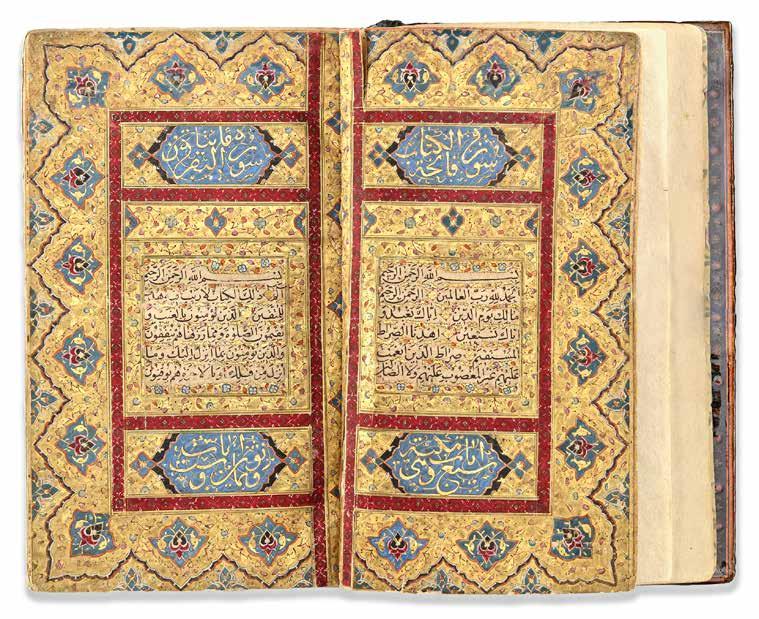
The last page with a prayer for completion of the recitation of the Quran (Due-al-Khatm) signed Muhammed Muhsen al-Isfahani dated in 1156 AH/1743 AD.
In later Qajar lacquer binding decorated central with floral motifs surrounded by gilt double border. 9 by 14 cm.
Estimate € 50.000 - € 80.000
Farhad Mirza Motamad al-Dawla (b. 1233/1818, Tabriz, d. 1305/1888, Tehran), Qajar prince-governor, author, and bibliophile. He was the fifteenth son of Abbas Mirza, a younger brother of Mohammad Shah, uncle of Naser-al-Din Shah, and a learned and influential Qajar prince known for his firm governorship over several provinces of Persia. He spent some of his adolescence in Tabriz, where he was instructed not only in traditional Persian and Islamic subjects but also in the English language, geography, and astronomy, some of which were taught by British subjects in the service of Abbas Mirza at the time. In 1250/1835, at the age of only seventeen, he was assigned to attend to the affairs of Lorestan and Kuzestan by his brother Bahram Mirza, who himself had recently been put in charge of that area by the newly crowned Moḥammad Shah. Farhad Mirza’s stay in the south of Persia lasted about two years but was successful enough to make Mohammad Shah summon him to Tehran to be in charge of the capital during his absence on two critical occasions: in Rabi II 1253/July-August 1837, when he was setting off to capture Herat, and in 1255/December 1839-January 1840, when he marched to Isfahan to settle with the powerful cleric, Sayyed Mohammad-Baqer Safti, who had renewed his perennial opposition to the state, promoting unrest and rebellion against the local government. Mohammad Shah and his grand vizier, Hajj Mirza Aqasi ,ultimately returned to the capital sixteen months later and observed, to the former’s delight, that Farhad Mirza had ably managed to maintain peace and order in the capital.
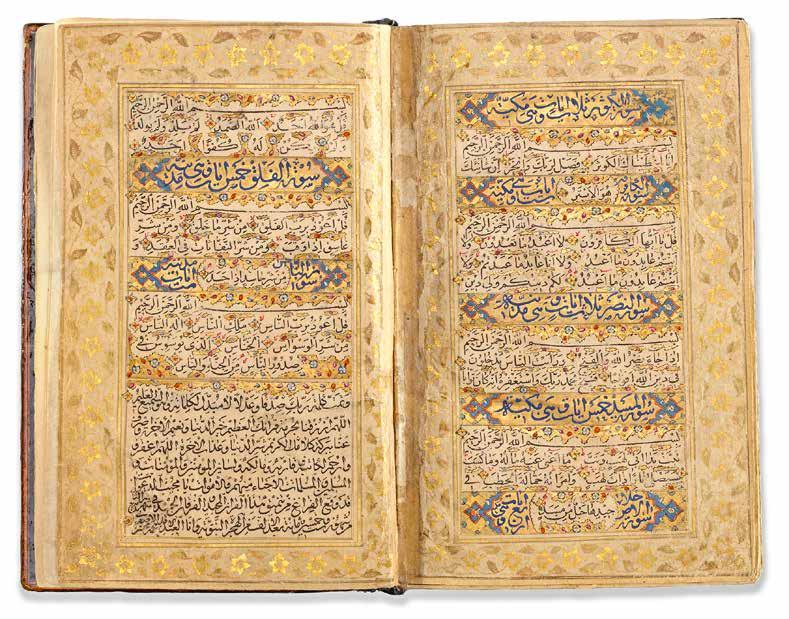
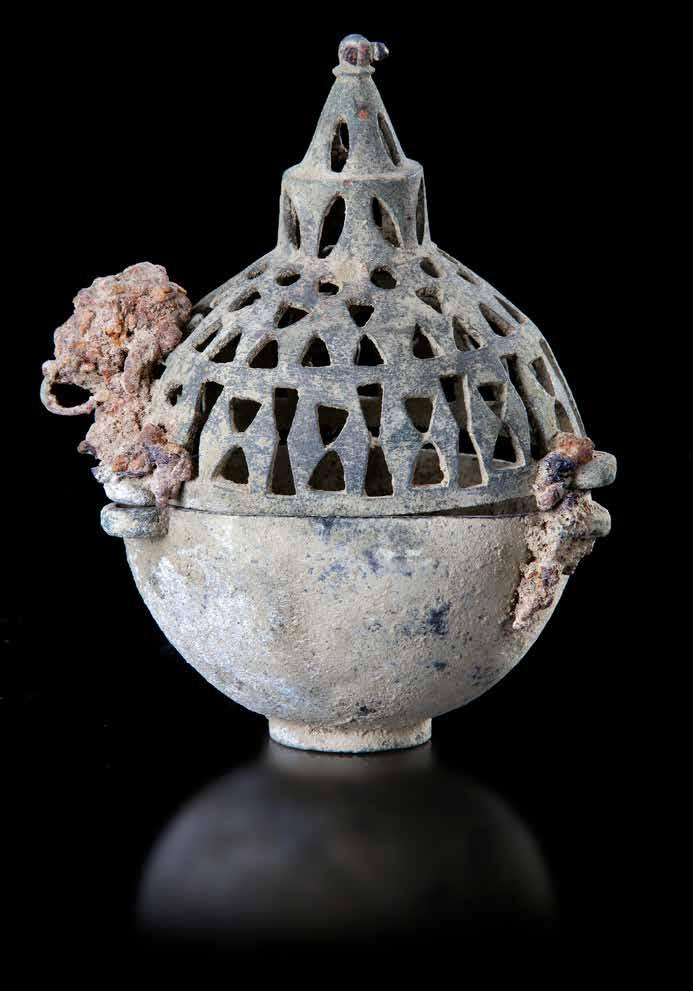
This bronze censer, or incense burner, is composed of two parts that were molded separately. First, a circular base in relief supports a lower hemisphere provided, on the outside, with three rings for the fixing of the rivets intended to attach it to the upper part. This upper part, also hemispherical and provided with rings for the rivets, is decorated with geometric patterns pierced in openwork and topped by what appears to be the summit of a minaret, with its circular gallery and its conical roof surmounted by a feature now damaged, perhaps a crescent moon. On the side, elements of the chain that allowed the piece to be suspended are still visible. Given the oxidation, they are preserved in the form of a highly contorted mass. The shape of this censer is very rare. In fact, most Muslim utensils of this type, attested mainly in the Near and Middle East, were designed to be placed on a support. They usually have three or four feet in the form of feline paws and a long shaft for their carrying. Among these, an Iranian example dated to the 12th century A.D., now housed in Berlin, can be related to our censer, especially as regards the rivet rings and the pierced patterns, on the handle in this case (Kühnel 1920, fi g. 93; Aga-Oglu 1945, fi g. 4).
It is, however, in Spanish Muslim art that our artifact has its closest parallel, namely the famous Almoravid bronze censer housed in the Museum of the Alhambra in Granada (inv. 3805; Fernández Puertas 1976; Zozaya and Von Gladiss 1995), similar in shape and differing only in the upper part topped with a bird on a ball. It is also worth noting the overall quality of the piece, as well as the delicate incisions, superior to our example. Study of the Granada specimen, confidently dated to the first quarter of the 12th century A.D., allows us to understand the rather unusual nature of our example. Like the masterpiece in the Almoravid Alhambra, it is likely an object commissioned by Muslim rulers and manufactured by Christian artisans located in Andalusia, who were inspired by incense burners suspended in the Late Byzantine churches, in which such liturgical objects were commonplace.
Condition: Complete, but slightly deformed in the middle, probably because of an impact. Traces of the iron suspension chain.
Height: 14.5 cm.
Private collection, Switzerland, acquired in 2000.
AGA-OGLU M., About a Type of Islamic Incense Burner, in The Art Bulletin, vol. 27, no. 1 (March 1945), pp. 28-45.
FERNANDEZ PUERTAS A., Incensario de época almorávide, in Miscelánea de Estudios Árabes y Hebraicos, no. 25, 1976, pp. 115-122. KÜHNEL E., Islamische Kunstabteilung: Islamisches Rauchergerät, in Berliner Museen, 41:6, Aug. - Sep. 1920), pp. 4-8. ZOZAYA J. and VON GLADISS A., Weihrauchgefäss, in VON GLADISS A. and SCHEFFOLD M. (eds.), Schätze der Alhambra: Islamische Kunst aus Andalusien, Berlin, 1995, p. 166.
Estimate € 5000 - € 8000
A Persian pottery jug with drop-shaped body and high shoulder rising to a ribbed neck, vertical mouth with small spout and a simple handle. Decorated with gold carved lattice designs interspersed with stylised leaf-motifs on a cobalt-blue ground, beneath a band of angular Kufic inscriptions, shoulder with a band enclosing elegant gilt carved perched bird, a cow and mythical beasts under a band of gilt carved interwined chain. The neck similarly decorated with a band of angular Kufic inscriptions.
Inscriptions
al-’izz wa al-iqbal wa al-dawam wa al-s’ada / al-s’ada wa al-salam li-sahibihi. ‘Perpetual Glory and increasing Prosperity, constant Elegance and happiness/ happiness and peace for its owner.
Height: 56.5 cm.
Ex. collection Soleiman Morad Pour, Geneva. Collected between the two world wars.
Lajvardina wares are named after the Persian word lajvard meaning “blue”, characterised by their distinctive lapis blue colour. Originally stemming from the Sanskrit word “rajavarta”, a portion of the King, the word lajvard is Persian for lapis lazuli.
It is applied principally to a group of vessels and tiles covered with a very intense cobalt-blue as is seen here, and then decorated in overglaze enamels, often in red, white and gold. As a term is has also been applied to the turquoise glazed enamel decorated vessels and tiles from the same group, as well as the rare examples worked on a white ground. Tiles in this technique are found in buildings dating from the later thirteenth century, notably from Takht-i Sulayman. It continued in use into the Timurid period in Central Asia, although with different designs. The only dated example is a tile formerly in Richard Ettinghausen’s collection with the date 1315. For a similar decorated tile we refer to Metropolitan museum accession number: 20.120.73.
Estimate € 150.000 - € 200.000


A fine steel turban helmet, of cylindrical form rising to a swollen band of vertical flutes narrowing to a central pointed apex housing a fixing for a finial, indents for the eyes and nose-guard to front, with applied rings for the nasal guard and plume holders, 17 rings around the lower edge and the rim for the suspension of an aventail, a wide band around base containing cartouches enclosing gilt engraved inscriptions, the helmet is gilded with the mark of the Ottoman arsenal (Kayi tribe), a similar band of gilt inscriptions around the top under a band of interlocked leafy palmettes. Height: 26 cm.
Inscriptions
two cartouches above the indents for the eyes contains the Basmallah, with Quran verses “ Allah Akbar, Allah Jalla Jalaluhu’ around the rim
PROVENANCE Private collction, United Kingdom
CATALOGUE NOTE
This helmet, which is characterised by its large yet elegant domical shape with a band of flutes and gently rising finial, is also referred to as a ‘turban helmet’ due to the resemblance of these flutes to the folds on a turban. Turbans could be representative of one’s rank or religious order, and the way that these were wound and the numbers of folds created were particularly important indicators of rank or religious status, some mystical dervish groups would wear turbans folded several times to reflect some important mystical number. The fluted design of the turban helmet might replicate this practice. The religious nature of the turban helmet was underlined by the presence of Arabic inscriptions taken from the Quran. These Quranic inscriptions supposedly provided God’s protective power to the wearer.
Estimate € 40.000 - € 60.000
Lot 66
A Persian pottery bottle vase, rising from a short foot to a compressed body tapering to thin cylindrical neck, with a garlic-head mouth and short upright mouth-rim. The white exterior painted in a variety of overglaze enamels with a series of crouching and kneeling figures, above a series of harpies, interspersed with polychrome cintamani roundels.
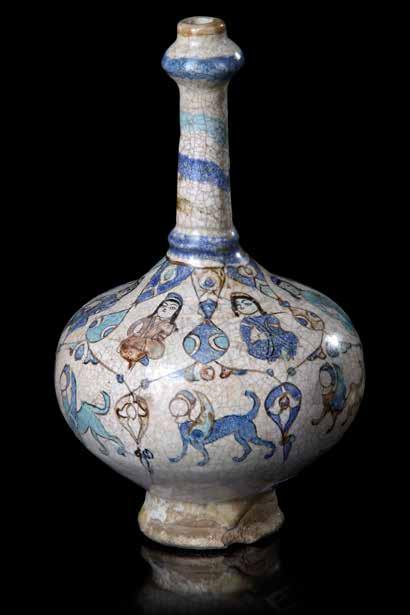
Height: 20 cm.
Formerly Japanese collection, collected in the 1980-90s. Exhibited at: “Exhibition of Persian Art, London, 1931, n° 44(?)
Mina’i ware is a type of Persian pottery developed in Kashan Persia, in the decades leading up to the Mongol invasion of Persia in 1219, after which production ceased. It is significant as the first pottery to use overglaze enamels, painted over the ceramic glaze fixed by a main glost firing, after painting the wares were given a second firing at a lower temperature. “Mina’i”: a term only used for these wares much later, means “enamelled” in the Persian language.The technique is also known as haft-rang, “seven colours” in Persian. This was the term used by the near-contemporary writer Abu al-Qasim Kasani, who had a pottery background.
Estimate € 14.000 - € 18.000
Lot 67
AN ILLUMINATED QAJAR QURAN WRITTEN FOR ABDULLAH KHAN AMIR NIZAM QARAGOZLU, PERSIA, 1319 AH/1901 AD
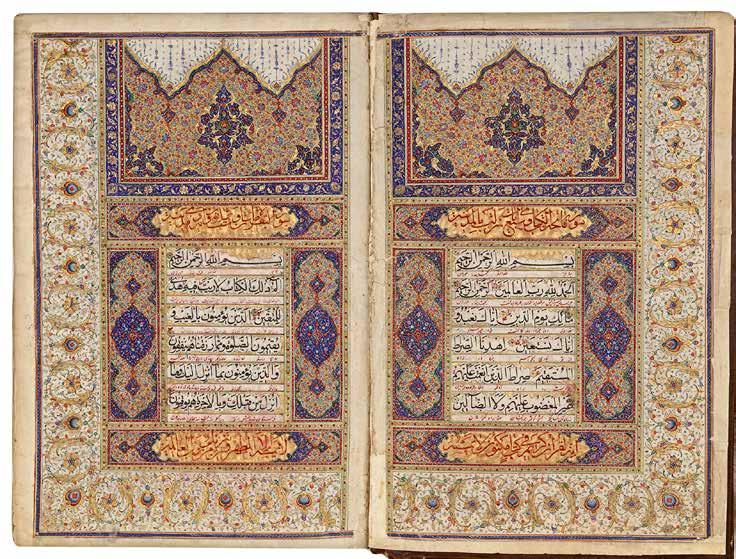
Lot 93
Arabic manuscript on paper, each folio with 14 lines of elegant black naskh script, interlinear Persian translation in red, gold and polychrome rosette verse markers outlined in black with blue dots, large gilt and polychrome floral marginal “juz’ and hizb” medallions, text within gold and polychrome rules, surah headings in large red thuluth script on a polychrome floral illuminated ground, occasional marginal commentary notes in black nasta’liq script, opening two bifolia fully illuminated in gold and polychrome framing 6ll. in clouds reserved against a gold sprinkled ground, at the top of each page the name of the corresponding surah in large thuluth script within a gilt floral leafy panel, end of the text with prayers and dedication.
A Persian pottery bowl with conical sides resting on a spreading foot, decorated with two figures on horseback on a leafy scrolls decorated ground, under the rim with a diaper band enclosing inscriptions in naskh script.
Diameter: 16 cm
Height: 8 cm
The final page signed ‘written by Muhammed Hasan Al-Hamadani in 13191H/1901AD. In gilt lacquer binding embellished with large flower heads amongst foliage. 22 by 33 cm.
Estimate € 12.000 - € 15.000
Estimate € 60.000 - € 80.000
Lot 68


Arabic manuscript on paper in scroll form, written in black ghubar reserved in clouds on a gilt ground decorated with polychrome floral leafy sprays, gold and polychrome headpiece surah decoration, with leather headpiece. Large inscriptions in naskh script: surah Al-Imraan v. 07. Inscriptions in ghubar script: surah Al-Hajj.
15 by 115 cm.
Estimate € 2000 - € 3000
Lot 69
NORTH AFRICA, DATED 1120 AH/1708 AD
Arabic manuscript on vellum, 35 lines written in black Maghribi script, catchwords in gilt ink outlined in black, gold verse rosette markers outlined in black and pointed in red, interlinear borders decorated with gilt floral leafy sprays on a blue ground, the margins decorated to the sides with red floral motifs and with a gilt and striking blue decoration at the top.
49 by 95 cm.
This manuscript outlined the genealogy of a certain Said ibn Abdul-Rahman ibn Jafar Omar. His line is traced through Hasan ibn Ali ibn Abi Talib and Fatimah, daughter of the Prophet Muhammad. Dated on Jumadah I 1120 AH (Juli 1708 AD).
Estimate € 3000 - € 5000
Lot 70
 BY MEHMED ARIF EFENDI, 1266 AH/1849 AD
BY MEHMED ARIF EFENDI, 1266 AH/1849 AD
Arabic and Turkish manuscript on paper, 9 lines to the page, written in naskh script in black ink, text separation represented by gold roundels pointed by polychrome dots, illuminated frontispiece with rococo-style decoration, surah headings in red ink on gold ground, ruled in gold and red. This finely-illuminated manuscript is a collection of Arabic and Turkish prayers. It opens with surah Yasin and different verses such as Al-Dhuha, Ikhlas and Al-Asr, Al-Inshirah, Al-Zalzalah, Al-Takathur and many different small verses followed by different prayers with commentaries and the Beautiful Names (Asma’ al-husna). The last folio signed by al-fakir Mehmed Arif on 29 Jumada al-akher in 1266 AH/1849 AD, with ownership statement.
In brown gilt morocco binding with flap. 10 by 12.5 cm.
Student of Hafiz Osman’s School in the six scripts, born in Istanbul-Eyüp, died 1270-1280 AH/1853-1864 AD and buried in Istanbul-Eyüp
He is one of the Anatolian pedestals. The grandson of Firar Mustafa Pashazade İbrahim Bey, who died in 1803. He was born in Eyüp and completed his education there. In the meantime, he received ijazet from Kebecizâde Mehmed Vasfî Efendi for practicing thuluth and naskh, and later gained skill in calligraphy with the help of other calligraphers. After completing his education, he became one of the lithographic calligraphers of Mühendishane-i Berrî-i Hümâyûn. He wrote the texts of the maps printed in the printing house of the school. He retired after serving for a long time, performed Hajj, and died a short time after he returned. Although it is known that he was buried in Eyüp, where he resided throughout his life, his history is not known.
Estimate € 2000 - € 3000

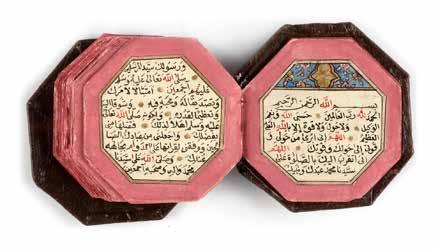
DATED 1231 AH/1815 AD
Arabic manuscript on paper depicting prayers in honor of the Prophet Muhammad, each folio with 10 lines, written in elegant black naskh script, with gold verse markers, some words picked out in red, text within gold and black rules. Two opening pages with gilt and polychrome decoration enclosing the title ‘Dala’il Al-Khayrat’, with numerous illuminated headpieces in gold and polychrome, including two original diagrams of the Holy Sites of Mecca and Medina.
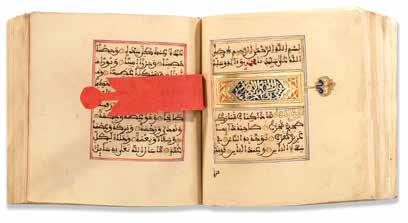
This finely-illuminated manuscript is a collection of prayers, it opens with two detailed illustrations Mecca and Medina with Al-Masjid AL-Haram and Al-Masjid AL-Nabawi, followed by diagrams of the Names of the Lord of the Worlds (Rab al-’alamin), Names of the Prophet, two detailed views of Kabaa and al-Rawda al-Sharifa, Alam or flag of the prophet, Mihraab of the Prophet Muhammad, Tuba tree, different items used by the prophet, names of the companions. The last with signed “written by Mustafa al-Hafez Rusdi, dated 1231 AH”. 5 by 5 cm.
Estimate € 3000 - € 5000
Lot 72
MUHAMMAD BIN SULAYMAN
AL-JAZULI (D.1465 AD) DALA’IL
AL-KHAYRAT, 18TH CENTURY
Al-Jazuli’s renowned work in praise of the Prophet Muhammad, Arabic manuscript on paper, each folio with 10 lines written in bold sepia Maghribi, titles in bold gold and polychrome Maghribi within illuminated cartouches, important words such as Allah and Muhammad in blue or red, text within blue and red rules, catchwords, two contemporaneous illustrations of the minbar of the Prophet and the tombs of the first Caliphs, copious added notes, in red morocco binding with gilt highlights.
12 by 12 cm.
Estimate € 4000 - € 6000
Lot 74
DATED 1301 AH/1883 AD
Arabic manuscript on paper, 20 leaves with 9 lines to each page. First, four and last line written in strong large thuluth script on light yellow ground. The other 6 lines arranged in two blocks of 3 lines, each of elegant smaller black naskh script, gold roundel verse markers outlined in blue and pointed in blue and orange dots, text ruled in gold and polychrome borders. The first page with floral polychrome decoration enclosing the name of the surah “ surah al-Kahf” in large thuluth script. The second and the third page with polychrome decoration enclosing 3 lines reserved in clouds. The last page signed “written by Muhammed Dur al-Shiri IN 1301AH”. Surah Al-Kahf, surah Al-Ikhlas, surah Al-Falaq and surah Al-Nas. 22 by 35 cm.
Estimate € 3000 - € 5000

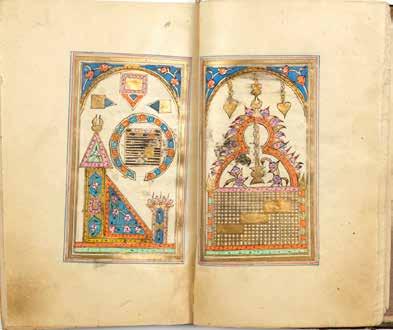
Arabic manuscript on paper depicting prayers in honour of the Prophet Muhammad, each folio with 11 lines written in elegant black naskh script, with gold verse markers pointed out in polychrome dots, some words picked out in red, text within double gold and polychrome rules, two opening biofolio with royal gold and rococo-style decoration enclosing text in clouds reserved against a gilt ground. Further two detailed illustrations of Kabaa, al-Mihraab al-Nabawi and al-Rawda al-Sharifa, different attributed names to the Prophet, occasional marginal floral motifs, colophon signed ‘written by Mustafa hafiz”. The first page with ownership statement and stamps, dated 1269 AH/1852 AD. In original tooled and stamped gilt brown morocco binding with flap. 10 by 15.5 cm.
Estimate € 800- € 1200

Arabic manuscript on paper, each page with 14 lines written in bold black naskh script in clouds reserved against a gold sprinkled ground, gold roundel verse markers outlined in black, diacritics and vowels in red, occasional marginal commentary notes indicating ‘juz’ and hizb’in red ink, surah headings in large white thuluth script on cartouches with a gilt blue floral illuminated ground, all ruled in gilt and blue borders, two opening bifolia fully illuminated in gold and polychrome framing 6 lines in clouds reserved against a gold sprinkled ground, end of the text with prayers and dedication.
The final page signed “written by Muhammad Aref al-Harawi”. In later gilt Qajar lacquer binding with central cartouche enclosing spandrels containing scrolling floral vines.
12 by 18 cm.
Estimate € 10.000 - € 15.000
Lot 76
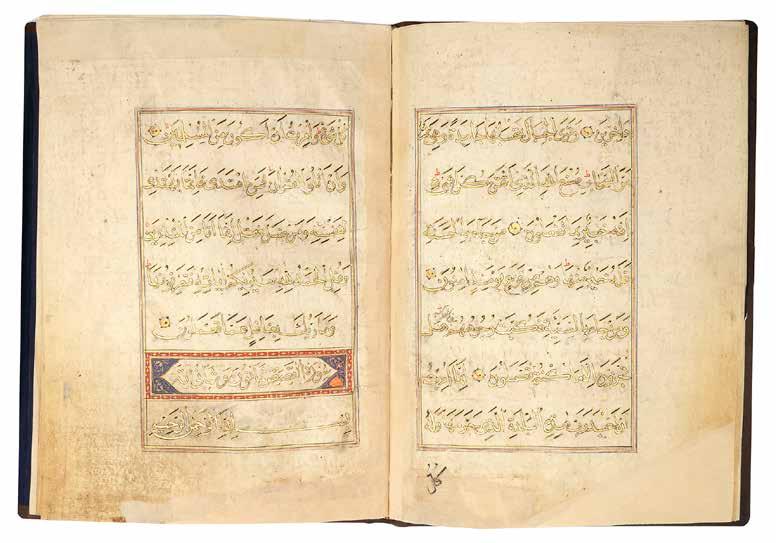
An Ottoman Quran section in gold, Juz 20, beginning with Surah Al-Naml, The Ants, verse 56. Arabic manuscript on paper, 27 ff. with 2 fly-leaves, 7 lines to each page page written in mansub script in gold ink outlined in black, with diacritics and vowel pointes in black, illuminated gold verse markers outlined in black and pointed in polychrome dots, inner margins ruled in red and gold, one illuminated headpiece in colours and gold, two surah headings in gold thuluth script within a rectangular panel illuminated in gold, blue and red, the basmallah in elegant gold muhaqqaq script outlined in black, re-backed original brown leather binding decorated with a stamped central medallion decorated with floral motifs, with flap. Folio: 27.5 by 19 cm.
Private collection, United Kingdom, formed in the 1960s and 1970s. For a similar Quran section, see Bonhams, Islamic and Indian Art, 8 April 2014, Lot 10; Bonhams, Islamic and Indian Art, 10 April 2008, Lot 30. Juz 2, 12 and 22 from the same Quran were sold at Bonhams: 14th October 1998 lot 115, 13th October 1999 lot 536, and 12th April 2000 lot 502.
Estimate € 3000 - € 5000
Lot 77
Persian manuscript on paper, each page with a central panel enclosing 15 lines in nastaliq black script, surrounded by diagonally written scripts, ruled in gilt and blue borders, each chapter with an opening biofolio with a gilt and polychrome decoration. In Qajar lacquer binding decoration with a bird perched amongst flowering branches. 13.5 by 22 cm.

Abu-Muhammad Muslih al-Din bin Abdallah Shirazi, better known by his pen name Saadi, was a major Persian poet and prose writer of the medieval period. He is recognized for the quality of his writings and for the depth of his social and moral thoughts. Saadi is widely recognized as one of the greatest poets of the classical literary tradition, earning him the nickname “Master of Speech” among Persian scholars.
Estimate € 5000 - € 8000


The base of truncated conical form encircled by two pointed ridges, the projecting shoulder leading to a concave driptray, the cylindrical neck surmounted by a broad socket tapering to the mouth, decorated with bands of Arabic calligraphy in elegant thuluth script around the body, the shoulder and the neck, small roundels containing birds, vestiges of gold and silver-inlay.
Around the mouth: bi rasm al-Jinan al-alami al-mawlawi al-amir al-kabir algazi al-mujahidi al-murabiti ( made for High Authority, the Lordly, the Great Emir, the Conqueror, the Learned, the holy warrior, the Diligent, the Possessor”.
Around the shoulder: al-maqarr al-kabir al-murabiti al-ali al-mawlawi al-maliki al-amir al-alami al-mujahid al-muaid
(“High Authority, the Lordly, the Great Emir, the Conqueror, the Learned, the Diligent, the Possessor, [the officer of] al-Malik al-Nasir”)
Around the body: al-maqarr al-Karim al-’ali al-mawlawi al-maliki al-amiri al-kabiri al-ghazi al-mujahidi al-murabiti al-muthagiri al-muaid (“High Authority, the Lordly, the Great Emir, the Conqueror, the Learned, the Diligent, the Possessor, [the officer of] al-Malik al-Nasir”)
Height: 38 cm.
PROVENANCE
Private collection, France
Estimate € 50.000 - € 80.000

A pottery jug standing on a splayed unglazed foot-ring and base, globular body with tall and wide cylindrical neck with handle and small thumb-piece on top, painted in brownish lustre. Chain and scroll motifs on the lower part of the body, on the upper part ten lobed medallions reserved in white and decorated with leaf and scroll patterns painted in lustre, chain and scroll motives on the neck and cursive inscription (unread) in white round the rim. Inside the rim Kufic characters of kalimaat al-Tawhid in lustre.
Inscriptions around the rim: Repetition of Persian verses (mostly undeciphered).
Height: 18.5 cm.
CATALOGUE NOTE
Lustre – a metallic glaze – was first used on pottery during the ninth century A.D. in Iraq, but gained more popularity from the tenth century onwards. The town of Kashan became the centre of the Persian lustre industry, and produced some of the most beautiful examples. It was in the thirteenth century that fritware, similar to the ancient Egyptian faience, was developed; composed of quartz and clay, it produced ceramics with a pleasing sheen.

PROVENANCE
Private collection, Switzerland
Estimate € 120.000 - € 150.000
Lot 80
AN ILLUMINATED MINIATURE OCTAGONAL QURAN WRITTEN BY MUHAMMED AL-KHALAWI, TURKEY DATED 1213 AH/1798 AD

A complete Quran, Arabic manuscript on paper, 217ff. with 3 fly-leaves, 19 lines to the page written in minute naskhi script in black ink with a black and gilt border, one illuminated double-page frontispiece in colors and gold containing two miniature of Al-Masjid al-Haram and Al-Masjid Al-Nabawi , a second double-page with striking blu nd gilt decoration framing 7 lines, surah headings in red, some waterstaining mostly restricted to outer margins, dark brown binding with covers painted with floral sprays in gold, leather outer case.
Manuscript: 5.5 by 5.5 cm.
Case: 7.8 by 7.8 cm.
Estimate € 3000 - € 5000
Lot 81
AN OTTOMAN MAJMA’ AL-ANSAB, A GENEALOGY OF THE PROPHET TURKEY, CIRCA 1715

Manuscript on paper, 59 leaves, with names written in black and red naskh script within blue, orange and green circles linked by red lines, comments in black naskh, in brown morocco binding, with flap, tooled medallion. This manuscript of genealogical tables starts with Adam, and traces the Prophet Muhammad and his descendants, the rulers of Persia, the Ottoman sultans (ending with Ahmed III, r.1703-30), and the Qadirite Sufis. The final date given is 1127 AH/1715 AD, although the later roundel giving the name of Sultan Mahmud I and the date 1135 AH/1722 AD, may have been added by a later owner. Folio: 24.5 by 17cm.
Christie’s, London, 28 April 1998, lot 68
Estimate € 2000 - € 3000
Lot 82
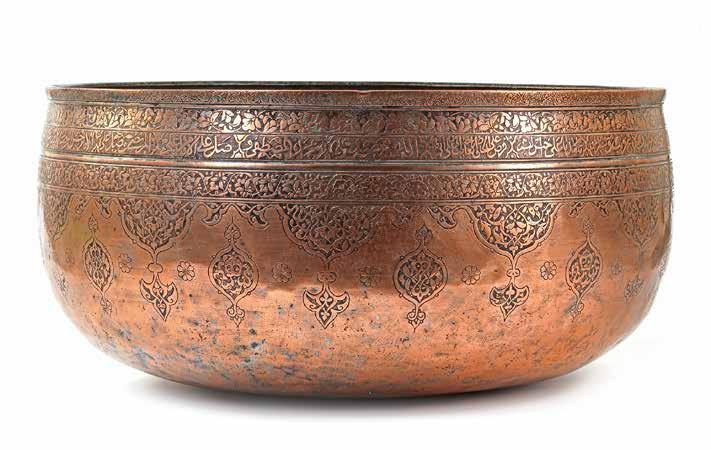
Of typical form, the rounded body engraved with elegant floral sprays on hatched ground within hanging medallions with palmettes finials, interspersed with rising medallions with loose quatrefoils and floral sprays, a register of elongated calligraphic cartouches in thuluth script with religious prayer. With the name of its owner, Muhammad Nur al-Din bin Karim.
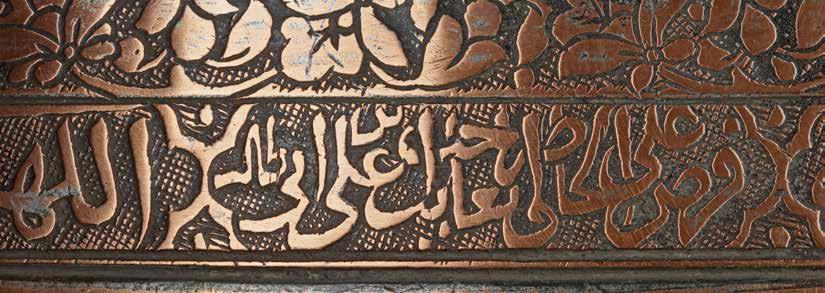
Diameter: 47.5 cm.
Height: 24 cm.
Estimate € 6000 - € 8000
Lot 83
A BOWL DECORATED WITH THREE BIRDS IN FLIGHT, SULTANABAD, 13TH-14TH

CENTURY
Estimate € 8000 - € 12.000
The bowl, worked on a potter’s wheel, is truncated cone-shaped and ends with a small vertical rim and a flat lip.
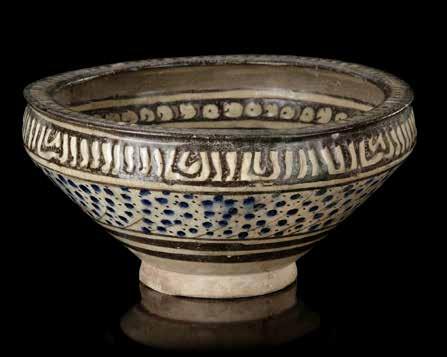
The decoration is dominated by the grey, black and cream tones of the background; on the outside, the polychromy is enriched by the presence of a wide frieze of cobalt blue dots alternating with diagonal lines and black dots. On the inside, the large tondo features a classic motif for ceramics in this style: three virtually identical birds flying in a landscape covered with flowers and leaves. Drawn in a slightly stylised way, they give the impression of moving quickly, with their wings spread and tails extended in the wind. The vase belongs to the group known as “Sultanabad”, of which the large semi-circular bowl is one of the classic forms (Sultanabad is the name of a town in Iran where a large number of vases of this type have been found; now called Arak, it is located between Isphahan and Hamadan). Sultanabad ceramics were fashionable between the end of the 13th and 14th centuries, during Mongol rule in Iran (reign of the Ilkhanids), but the actual centre of production of these vessels remains a subject of open scientific debate (the workshops of Kashan, etc.) The painted motifs on these vessels are sometimes innovative compared with the styles of contemporary Islamic ceramics. This diversity is explained by the influence of the Mongol dynasty, which is said to have recovered some subjects from the Chinese tradition, such as the phoenix or the lotus flower. Typical of ceramics from the Mongol period is also the technique used for decoration, executed using the so-called colourless underglaze process. The motifs are painted in black, blue or grey on a white slip and then covered with a layer of transparent glaze before firing.
Complete and in excellent condition, but reglued, with a few fillings, small chips and cracks in the glaze. Beige-grey paste with cream slip. Grey, black, grey and blue paint.
Diameter: 29.5 cm.
Private collection, Switzerland. Formerly Japanese collection, collected in the 1980-90s.
J., Islamic ceramics, Paris, 1985, pp. 198ff, p. 216, nos. 239-241. WATSON O. Ceramics from Islamic Lands, Kuwait National Museum, The al-Sabah Collection, London, 2004, pp. 373 ff, Q.11-Q14. A bowl preserved in the Louvre
Lot 84
AN OTTOMAN GILT BRONZE CANDLESTICK, LATE 15TH CENTURY
An Ottoman gilt bronze candlestick of bell form with two raised bands, the drip tray surrounded by an openwork foliate arcade, emerging from a tulip shaped mouth a shaft with two raised bands.

Height: 29 cm.
Diameter: 17 cm.
Estimate € 15.000 - € 20.000
Lot 85
A LARGE OTTOMAN GENEALOGICAL SCROLL (SILSILENAME)

TURKEY, 18TH CENTURY
Arabic and Ottoman manuscript on paper, written in naskh, thuluth and nastaliq script in red and black ink, with the names within gold roundels outlined in black , illuminated headpiece with blue, red and royal gold decoration enclosing Al-Basmallah in black naskh script.
21 m by 27 cm.
Genealogical manuscripts (silsilename) in the form of a scroll or a book were popular in the Ottoman period. Although generally classed as genealogies they in fact do not function strictly as such. Silsilename were very popular in Ottoman Turkey, listing rulers and religious leaders and their line of descent. This particular example is a silsilename of the Prophets commences with Adam through Noah, Abraham, Solomon etc.., tracing the lineage through the Prophet of Islam, the well-know figures of Quraysh tribe, the lineage of the prophet and his wives, the four Rashidun caliphs and their children like Hasan and Hussain.
Estimate € 4000 - € 6000
Lot 86

The steep sides rising from a short spreading chrysanthemum-shaped foot to a slightly flared rim, carved in low relief to the exterior with three rows of stylised floral foliates, the stone of a pale celadon tone.
Diameter: 13.6 cm.
PROVENANCE
Collection of Edward George Robey (1869-1954).
Estimate € 30.000 - € 40.000
A slightly curved gilt silver belt, with a central aperture and hidden sliding hinge, four thin stays on underside to fasten belt, the front worked in repoussé with foliate scrolls, set with encrusted jade plaques inlaid with gold and colorful stones, bordered by further stones set into shallow bud-shaped settings. 25 by 11 cm.

This magnificent belt buckle belongs to a very small group of Ottoman buckles decorated in such an extravagant manner which are known to exist. One is in the Topkapi Saray Collection and another in the Benaki Museum (Ballian 1992, p.96-97, no.53). Another similar example, dated to the sixteenth century, now in the Museum für Kunsthandwerk, Frankfurt, inv. no. 14320, displays a similar pattern of arrangement, with inset jade plaques and colourful gemstones on a repoussé ground. The colorful stones bordering each plaque of the buckle were each set into bud-shaped clasps using a technique known as mihlama (R. Hasson, Later Islamic Jewellery, L.A. Mayer Memorial Institute for Islamic Art, Jerusalem 1987, p.11, no. 3). The Ottoman tradition of setting jade and gemstones into metal objects intended for everyday use to embellish them can be seen on a number of different objects including small boxes, book covers, weapons (see following lot).
Estimate € 30.000 - € 50.000
Of drop shape, the jade surface carved with 7 lines of extremely elegant nastaliq script with occasional floral flourishes, the final line dated, pinned through the centre to a 19th century gold mount decorated in repoussé with a floral spray issuing flower heads and fleshy leaves. 10 by 7.5 cm.

CATALOGUE NOTE
Dated 1013 AD and insipid with its owner Khan-i-Khanan. Abdul Rahim Khan-i-Khanan: Khanzada Mirza Khan Abdul Rahim (17 December 1556 – 1 October 1627), popularly known as simply Rahim and titled Khan-i-Khanan, was a poet who lived in India during the rule of Mughal emperor Akbar, who was his mentor. He was one of the nine important ministers (dewan) in his court, known as the Navaratnas. Rahim was known for his Hindi dohe (couplets) and his books on astrology. Apart from writing various dohas, Rahim translated Babar’s memoirs, Baburnama, from the Chagatai language to the Persian language, which was completed in 1589–90 AD. He had an excellent command over the Sanskrit language.
Estimate € 30.000 - € 50.000




A very elaborate gold roundel with river pearls and stone and glass inlays. The roundel is an exceptional product of a master jeweler from the period of the hight of Fatimid craftsmanship during the hight of their empire. The disc shows the virtuoso technique of the Fatimid jewelers in creating elaborate surfaces by using filigreed wires and globules alone without the need for a foil base to work on. The surface is then applied with six hemispherical appliqués and the central decorative motif of a raised Star of David, decorated with granulation, with garnet and glass inlays. Around the edge six tubular hoops guide a wire with river pearls threaded onto it. On the back we see the star off David design repeated, this time covered in granulation and a fleur-du-lys motif spaced within the recesses.
Diameter: 5.7 cm.
Weight: 55.6 gr.
A similar roundel in the Metropolitan Museum is reckoned to have been an adornment for a headdress as seen on contemporary illustrations. The present piece has many motifs which point to it being Fatimid, notably the use of lines of filigreed globules used to frame the twisted wire spiraled elements at the front. The fact that this roundel is decorated at the back would not change the likely purpose of this specimen.
PROVENANCE
Private collection, Belgium
Estimate € 20.000 - € 30.000


A very large and elaborate gold ring from the 10th-11th century. This exceptional ring shows off the extraordinary skill and virtuosity of the jewelers of the Fatimid period, something hardly seen before or since the period of the Fatimid Empire. The ring is built up of ‘8’ shaped elements made of flattened wire which are then filigreed to each other to form a sheet which is then fashioned into the required shape. The shank is lined from the inside by a plain gold sheet while all the other edges are formed by a beaded wire running along the joins.The bezel is in the form of a lozenge, and a cabochon garnet is set into the centre, held on a mount surrounded by a plain wire. The technique produced what in effect is a ‘cage’ of strength yet great lightness, a truly remarkable achievement. It is for this factor that the technique was never used again in later times. This ring stands as a testament to the opulence and level of craftsmanship reached during the Fatimid period in the urban centers of the manufacture of such items.
4.4 by 2.8 by 1.5 cm.
Weight: 12.6 gr
PROVENANCE
Private collection, Belgium
Estimate € 8000 - € 12.000

A pair of later Fatimid earrings from the end of the 12th century. The earrings are formed of a thick, circular wire with a device for closing the loop and three large globular beads which are threaded onto the wire and fixed by attachment with beaded spaces which are in turn soldered to the wire. The beads are made from thin sheet moulded into hemispheres which are then soldered at the edges to for a sphere. These were then in turned embellished with twisted wires and beads. The type originally derives from Byzantine prototypes and the interaction between the two cultures is well known in terms of borrowing from each other in the field of jewelry. They are exceptionally well preserved . 4.4 by 4.2 by 1.7 cm.
Weight: 28.1 gr.
PROVENANCE
Private collection, Belgium
Estimate € 5000 - € 8000
Lot 93
A GOLD AND SILVER RING, AYYUBID DYNASTY, 12TH CENTURY
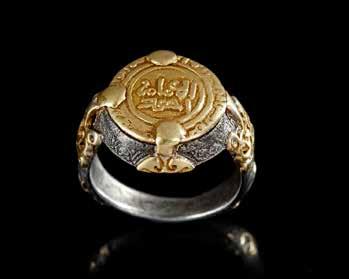
A gold dinar with a cursive inscription within a gold border with arabesque design and shank with applied palmettes.
The inscription Al’amam ‘Ahmad
Height: 2.1 cm.
Weight: 7 gr.
Estimate € 1500 - € 2000
Lot 92
A GOLD ISLAMIC BRACELET

11TH-12TH CENTURY
A gold bracelet decorated with engraved birds (eagles?) alternating with stylized crosses with quartered with fleur de lys motifs. The motifs are engraved in roundels which alternate between the designs. There are traces of niello in the engraved recesses and this technique was widely used in the eastern Mediterranean at this time, the origins of which go back to the Romans. The clasp or closing mechanism is a commonly used triple lug mechanism which then closes with an inserted pin. The objects using this style are divided between Seljuks, Byzantines, Armenians within the area of Anatolia from where the most of these objects originate. Diameter: 6 cm 16 gr. weight.
PROVENANCE
Private collection, Belgium
Estimate € 1500 - € 2000
A MUGHAL GEM-SET ENAMELED GOLD NECKLACE
LATE 18TH CENTURY
Each square element set with nine ruby gem-stones with pendant pearls, the reverse decorated in red, green, white and turquoise enamels with floral motifs.
Width: 15 cm.
Weight: 69.07 gr.
Estimate € 3000 - € 5000
A MUGHAL GEM-SET ENAMELED GOLD NECKLACE


LATE 18TH CENTURY
Each floral shaped element set with ruby, emerald, turquoise and agate gem-stones.
Weight: 57.3 gr.
Length: 24 cm
Diameter: 10 cm.
PROVENANCE Private collection, France
Estimate € 2000 - € 3000
Lot 96
Comprising a central inverted T-shape element of box construction, the face with figure-of-eight wire decoration, flanked on each side with confronted birds formed of scrolling wirework with applied similar wings and conical tails, one with a pronounced crest, three pendant beads of similar workmanship below with seed-pearls, a similar larger seed-pearl and suspension loop above. 6 by 4.5 cm.
Weight: 8 gr.
CATALOGUE NOTE
The motif of two confronted peacocks, found on Byzantine jewelry (Hasson, Rachel: Early Islamic Jewelry, Jerusalem, 1987, no.3, p. 13)
Estimate € 1000 - € 1200
Lot 97

Of pear-shape, both sides wheel-cut with two bilaterally symmetrical palmettes and leaf scrolls, the top with drill hole for suspension 4.6 cm.
CATALOGUE NOTE
This pendant would have been worn as a talisman to protect the owner from harm. The aquamarine is traditionally believed to alleviate tension and reduce fear and anxiety, as well as mollifying aches and pains. In medieval times people widely believed in the physical as well as metaphysical properties of different minerals and scholars wrote extensively about them. One such was the Persian polymath, Abu al-Rayhan Muhammad ibn Ahmad al-Biruni (973-1048), whose list of notable publications includes a celebrated treatise on gemology, Kitab al-Jawahir, or “Book of Precious Stones”.
Estimate € 2000 - € 3000

Lot 98
The rock crystal of domed cylindrical form, carved with deep bevel-cut foliate designs and incised dash details.
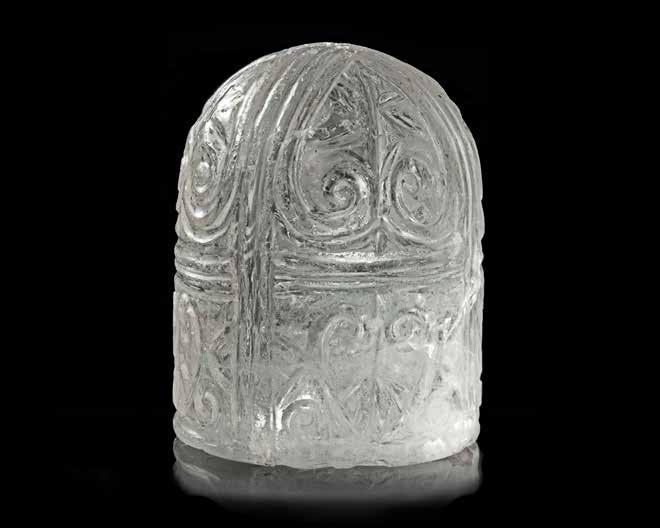
7 by 5 cm.
PROVENANCE
Private collection, Belgium
CATALOGUE NOTE
The Fatimids mastered the carving of rock crystal in the tenth century, owing to their Caliphs’ abundant wealth which provided the means to commission such refined works. An impressive, although limited, corpus of remaining works which include ewers, flasks and chess pieces exhibits the exemplary skill of Fatimid craftsmen. This king or queen demonstrates both their affluence and the superior position they granted to the game of chess at this time.
The present lot is a rare example of Fatimid rock crystal carving and an interesting addition to the existing corpus of rock crystal gaming pieces of the period. The game of chess, which can be traced back through archaeological evidence to the second or third century, spread from the Indian subcontinent through Persia to centres such as Baghdad and Cairo, from where the present chess piece most probably originates. It can be attributed either to the Abbasid or Fatimid Caliphates as it shares a number of stylistic and technical features with examples of similar gaming pieces now in various museum collections.
Estimate € 8000 - € 12.000
Lot 99
A FATIMID IVORY CARVED BOX, EGYPT OR SYRIA 10TH-11TH CENTURY
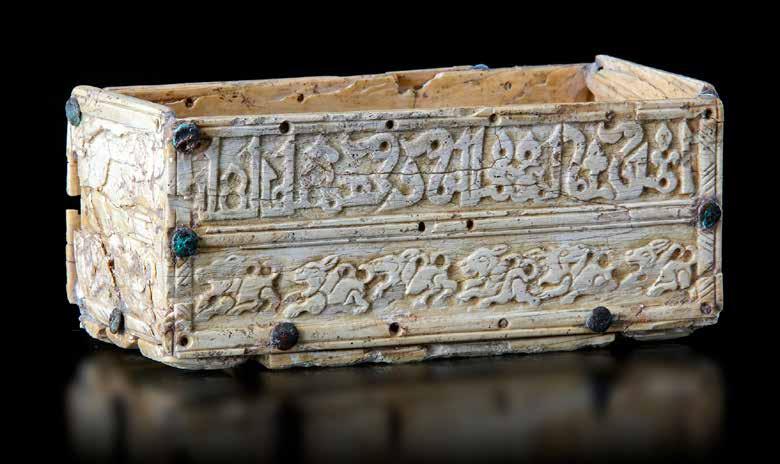
Of rectangular form resting on three thicker carved bases, each side carved elegantly with two bands of angular Kufic inscription ( Fatimid Kufic script) above a band of rabbits.
8 by 16.5 cm
Estimate € 6000 - € 8000
Lot 100
TWELVE GLASS MOULDED FRAGMENTS, PERSIA OR CENTRAL ASIA

10TH-12TH CENTURY
Twelve rectangular shaped fragments, moulded each with the word “Allah”. Mounted and several sizes, approx. 1 by 1.2 cm / 0.8 by 1 cm.
Estimate € 1200 - € 1500
Lot 101
The rock crystal of domed cylindrical form, carved with deep bevel-cut foliate designs and incised dash details.


7 by 5 cm.
PROVENANCE
Private collection, Belgium
Estimate € 6000 - € 8000
Lot 102
A KING (SHAH) ROCK CRYSTAL CHESS PIECE, IRAQ OR KHORASAN, LATE 9TH-EARLY 10TH CENTURY
This piece of rock crystal is carved as a chess piece, probably a king. In the Middle East the king originally showed the monarch riding on an elephant in full state. However, the shape soon became highly stylised, and its main distinguishing feature is its lack of symmetry front and back. This piece has a low, plain, recessed oval base. The main body has a rounded top and has been carved as three separate elements. A high band with a decorated upper surface separates two faces that curve outwards. The front shows a pair of birds confronting one another. They make a pattern that looks a little like an elephant’s face. The back is much lower and is decorated with a pattern of leafy scrolls.

Height: 6 cm.
Diameter: 4.5 cm.
PROVENANCE
Private collection, Belgium
Estimate € 8000 - € 12.000

A cobalt-blue and white piece, formed of colorless or pale green glass but in this case covered with a layer of cobalt-blue glass with white and blue canes. A green and yellow piece, formed of colorless or pale green glass but in this case covered with a layer of emerald green glass with yellow and green canes.
There are slight variations in the tone of the colors and more substantial differences in the shapes and sizes of the pieces, varying from cone shapes to simple flattish dome shapes. These pieces are undoubtedly from different sets of games, but it seems likely that they were originally used for one side of a game, while another color combination was used for the opposing side. 2 by 1 cm. and 2 by 2 cm.
PROVENANCE
Private collection, Switzerland
Estimate € 2000 - € 3000
Lot 104
A MAMLUK SILVER INLAID BRASS BOWL, EGYPT OR SYRIA
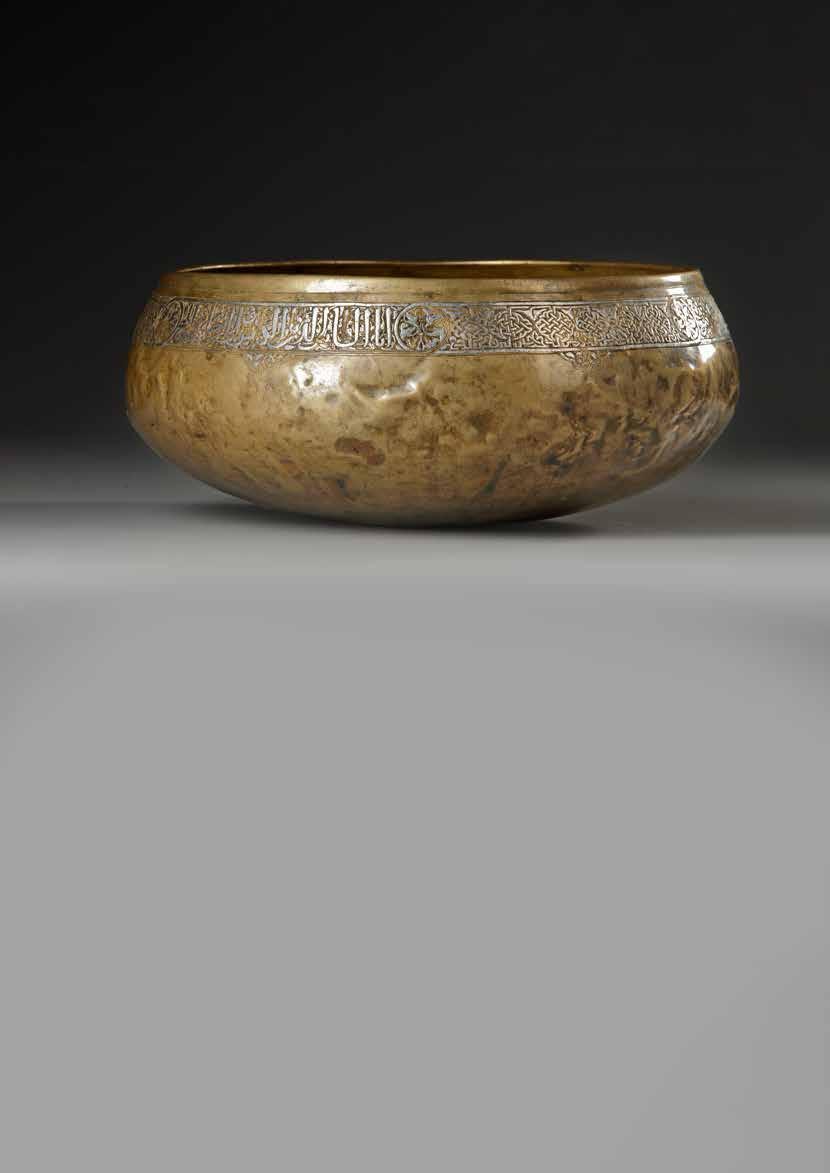
EARLY 14TH CENTURY
A bowl of deep rounded form and lipped rim, decorated around the rim with an elegant silver inlaid benedictory inscription separated by roundels each containing a whirling rosette, foliate scrolls with downward pointing slender palmettes.
Diameter: 28 cm.
Height: 11 cm.
Inscriptions
Around the shoulder in a cursive hand: alternating bands carved in elegant thuluth script and naskh script within floral leafy decoration of three lines of poetry attributed to the famous islamic schaolar Ibn Hanbal. This poetry was mentioned in ‘Sifat al-Safwah’ by Ibn al-Jawzi and ‘ Al Dail Ala Tabaqat al Hanabila or The Tail Of The Hanbalite Classes’ by Ibn Rajab.
The use of inlaid brass became extremely popular during the thirteenth and fourteenth centuries, being considered an effective alternative to gold and silver, and was patronised widely by the elite classes. This was particularly so in relation to the Mamluk pieces which, as this example’s inscription testifies, appear to “...trumpet the social position of their owner so loudly that the vessels seem intended more as vehicles of propaganda than for pleasure and appreciation.” (Ward 1993, p.95).
Private collection, France
Estimate € 30.000 - € 50.000
A pottery arch shaped panel consisting of 6 tiles, painted in cobalt blue, turquoise and opaque white with manganese purple with large cartouches enclosing inscriptions in reverse-decoration and naskh script, flanked by two roundels enclosing the words “ Allah, Muhammad”, under a band of vegetative motifs.
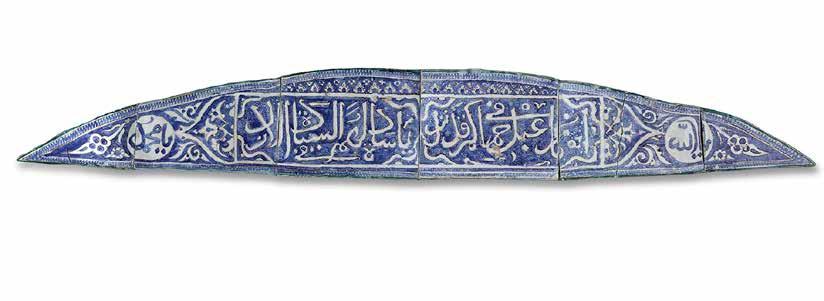
Inscriptions: A poem in praise of the prophet “
Length: 122 cm
Estimate € 3000 - € 5000

Of circular form, one pierced with inscription, the rest with floral and geometric designs. The largest 7.3 cm. diam. ( 9)
Filters of this type were originally from the tops of water jugs. For other groups of water filters, see Tresors Fatimides du Caire, Exhibition Catalogue, Institut du Monde Arabe, 28th April-30th August 1998, no. 140; and also two similar groups were sold at Bonhams, Islamic Works of Art, 13th-14th October 1999, lots 126 and 127.
Estimate € 1200 - € 1500
Lot 107
A MONUMENTAL LATE MAMLUK, EARLY OTTOMAN, TINNED COPPER BRASS BASIN, EGYPT OR SYRIA, LATE 15TH-EARLY 16TH CENTURY AND LATER
Of beaten sheet metal, deep rounded form, the body engraved with overlapping circular medallions containing stellar motifs alternating with oblong cartouches filled with strapwork, foliate details and naskh inscriptions, with later everted rim and foot with two drill holes and inscription.
Height: 31.7 cm.
Diameter: 55.4 cm.
Previously in the collection at Athelhampton House, Dorset, since the 1950s.
Another deep rounded bowl from the late fifteenth century and attributed to the Master Muhammad, the cook from Aleppo, is in the Royal Ontario Museum, Toronto (inv. no. DSC04621), and features similar inscribed tinned-copper designs and form.
Estimate € 4000 - € 6000
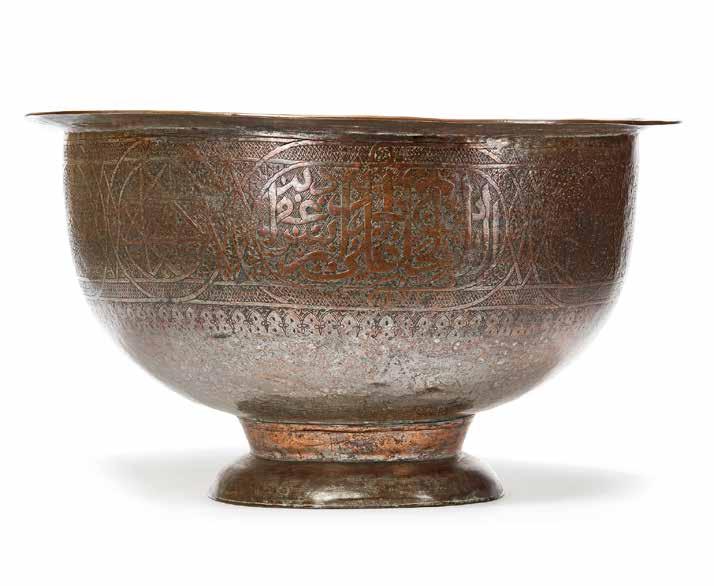
Lot 108
A KASHAN LUSTRE POTTERY BOWL PERSIA, LATE 12TH EARLY 13TH CENTURY
A Persian pottery bowl with conical sides resting on a spreading foot, decorated with two figures on horseback on a leafy scrolls decorated ground, under the rim with a diaper band enclosing inscriptions in naskh script.
Diameter: 16 cm.
Height: 8 cm.
Estimate € 4000 - € 6000
Lot 109
A KASHAN POTTERY BOWL, CENTRAL PERSIA, 12TH-13TH CENTURY
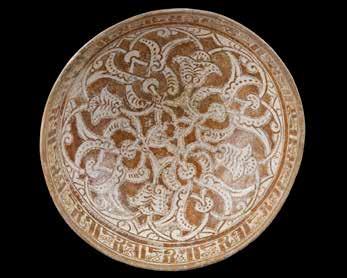

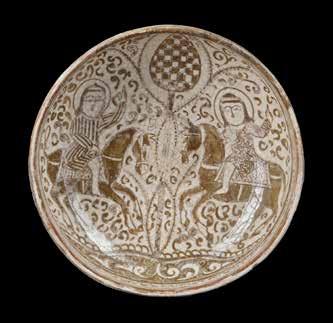
A Persian pottery bowl standing on a short straight foot with slightly flaring sides, decorated in a brownish-gold lustre, with a central roundel depicting a seated human figures, the sides with a similar band containing roundels enclosing seated figures, under the rim with a broad band of Kufic reserved against a lustre scrolling ground. the exterior with a band of bold palmette-motifs reserved against the lustre ground.
Diameter: 19.8 cm.
Height: 9 cm.
Estimate € 3000 - € 5000
Lot 110
A KASHAN LUSTRE POTTERY BOWL PERSIA, LATE 12TH CENTURY
A Persian pottery bowl standing on a small foot with conical sides, decorated in reversed- brown on a white ground with a roundel enclosing a lattice of lotus scrolls amongst foliage, the rim with Arabic band in Kufic script.
Diameter: 16 cm.
Height: 6.5 cm.
Estimate € 4000 - € 6000
Lot 111
A GROUP OF TIMURID CUERDA SECA POTTERY STAR TILES

PERSIA, LATE 15TH CENTURY
Comprising four eight-pointed tiles, decorated in blue, outlined in cuerda seca on a white ground with split-palmette interlace. 9.4 cm. diam. max.(10)
CATALOGUE NOTE
Similar star tiles were offered for sale at Christie’s, Art of the Islamic and Indian Worlds, 26th April 2005, lot 99 and Sotheby’s, Arts of the Islamic World, 28th April 2004, lot 120.
PROVENANCE
Private collection, Germany
Estimate € 2000 - € 3000

Bowl in light grey-beige clay covered with a white slip, decoration painted in black under a magnificent turquoise glaze, thicker on the bottom where it has partially flowed. The rounded body ends in a high vertical edge; it is supported by a circular and hollow foot with the edge cut in bevel. Technique, shape and decoration are typical of ceramics with a very shiny appearance produced in the workshops of the city of Kashan, which is in the center of Iran.
Estimate € 8000 - € 12.000
The technique of execution (known as metallic luster) is one of the most important contributions of the Islamic craftsmen to the development of ceramics and provides for two different firing phases, the first to fire the paste and the second to make the glaze shiny. Even if its origin and history are not yet unanimous, it is thought that this technique was probably invented in Iraq, the center of power of the Abbasids, between the 8th and 9th centuries; widely used by the potters of Cairo under the Fatimid dynasty (10th and 11th centuries), it appeared in the 12th century in the Syrian world. In Iran, it was not until the last decades of the 12th century that the production of luster ceramics began: very quickly the city of Kâshân imposed itself as the main production center where, as the legible signatures on many recipients prove, worked from real dynasties of potters. The turquoise and black colors used are certainly elements that still make the success of this type of ceramic today. The patterns are drawn by hand: inside, after a series of vertical lines alternating with dots that adorn the edge, we find in the center of the cup the main subject, made up of flowers and other spaced lines of plant inspiration. by semicircles. On the outside, four motifs reminiscent of stylized lilies are separated by vertical lines.
Complete and practically intact, small fillings on the foot. Glaze still very shiny despite some cracks. In places slight patina covering the glaze.
Diameter: 13.3 cm.
Private collection, Switzerland. Formerly Japanese collection, collected in the 1980-90s

Terres d’Islam, The collections of Middle Eastern ceramics from the Ariana Museum in Geneva, Geneva, 2014, nos. 50-55, p. 70-73.
WATSON O., Ceramics from the Islamic Lands, Kuwait National Museum: The Al-Sabah Collection, London, 2004, pp. 332-337.
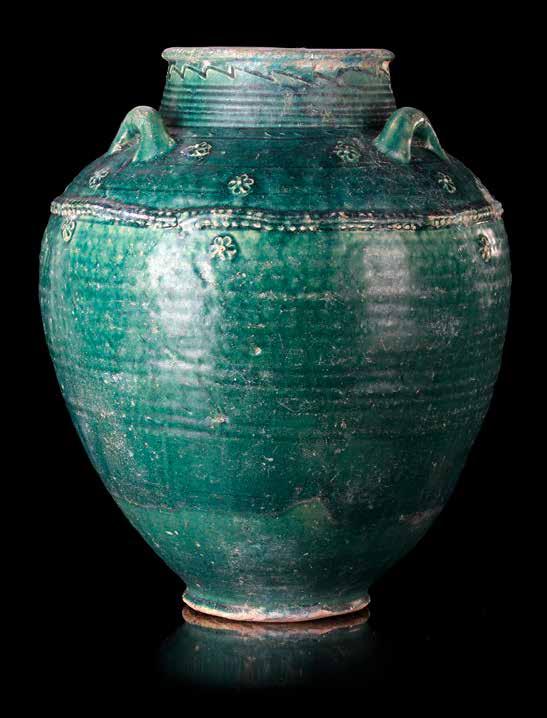
Of shouldered rounded form rising from the short foot to the tapering cylindrical mouth with everted rim, four handles to the shoulder, the lower shoulder with a band of decoration, similar applied small roundels above and below.
CATALOGUE NOTE This type of alkaline-glazed pottery, intended for storage of food stuffs or drinking water, had been produced in kilns along the Upper Euphrates since at least the Parthian period continuing through the Umayyad and early Abbasid periods, with subtle changes in shape and design. The distinctive silvery iridescence offset by the turquoise glaze only adds to their decorative appeal. Their story is also fascinating, for examples have been found as far afield as Fujian province in China. A tomb at Lotus Peak on the outskirts of Fuzhou, dedicated to one Liu Hua, who died in A.D. 930, wife of King Wang Yangjun of the Min Kingdom (A.D. 909-945), yielded three similar turquoise-glazed jars, testament to the trading activities of Persian and Arab merchants along the southern coast of China at this time.
Lot 114
A RAQQA TURQUOISE GLAZED POTTERY DISH, SYRIA, EARLY 13TH CENTURY

A pottery dish rising from short vertical foot through rounded body to everted rim, the interior painted in black under the glaze with a central roundel enclosing two elegant birds perched on a blossoming branch, surrounded by a diaper band of triangles.
Similar underglaze painted objects are usually attributed to Raqqa, a town on the Euphrates in northeast Syria, from which a large number appeared on the market since the end of the 19th century. While some of the workshops were located there, as the unearthing of a large number of wasters confirms, others were located elsewhere along the Euphrates valley, in southern Anatolia, central Syria, Damascus and as far as Egypt.
Estimate € 2000 - € 3000
A NISHAPUR POTTERY BOWL PERSIA, 10TH CENTURY
Of rounded form, the rim curving inward on short foot, the decoration with a large bird and palmettes.
Diameter: 19.5 cm.
Height: 7 cm.
Estimate € 1500 - € 2000
A NISHAPUR POTTERY BOWL EASTERN PERSIA


10TH CENTURY
Of hemispherical form on short foot, the interior painted in yellow, brown and black with three birds.
Diameter: 29 cm.
Height: 9 cm.
Estimate € 1200 - € 1500
Lot 117

Of deep rounded form with inverted rim and standing on a small foot, decorated in a turqouise band of a calligraphy on black ground.
Estimate € 1200 - € 1500
Lot 118
A KASHAN POTTERY BOWL PERSIA 13TH CENTURY
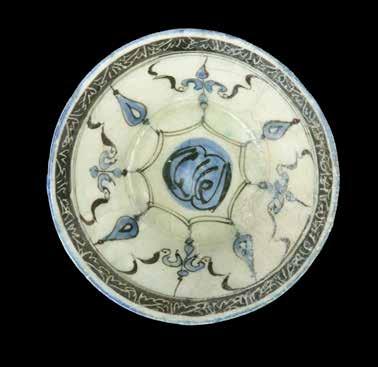
A Persian pottery bowl of truncated conical form with flaring walls and straight vertical foot, the fritware body painted in blue with black outlines and dots under a transparent glaze, decorated with a central star-shaped panel connecting with leaves and leafy sprays, the rim with a band containing pseudo-Arabic inscriptions in cursive script on a black ground. The exterior divided with stripes featuring stylised vegetal motifs.
Diameter: 20.5 cm.
Height: 10 cm.
Estimate € 2000 - € 3000
A NISHAPUR CONICAL POTTERY BOWL, PERSIA, 10TH CENTURY
Painted under the glaze in ochre, yellow and white against a brown ground, the interior with roundels and geometric designs enclosing leafy scrolls, the exterior painted with a red slip and clear glaze.
Estimate € 1200 - € 1500
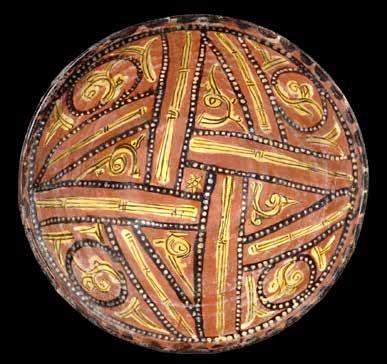
Lot 120
A LARGE MAMLUK BRASS BOWL WITH INSCRIPTIONS, EGYPT OR SYRIA

14TH CENTURY
A large bowl of deep rounded form decorated around the rim with an elegant benedictory inscription separated by six roundels each containing a whirling rosette, the interior with a geometric roundel. 17 by 39 cm.
Inscriptions
Around the shoulder in a cursive hand: al-‘izz wa al-iqbal wa / al-dawlah wa al-sala/mah wa al-sa’adah / wa al-‘afiyah li-sahibih ‘Glory and prosperity and wealth and well-being and happiness and health to its owner.
The finely executed decoration combined with language used would suggest it was intended for a high-ranking patron. The benedictory inscriptions here are not just typical of similar metalwork but can be found on many other forms of Mamluk art and architecture of the late 13th and early 14th centuries.The bowl is engraved on the exterior with “Bi-Rasm Bilban al-Bitahi”, made for the price of Aleppo in 699/1299 born in Mecca, Said al-Dain Bilban al-Bitahi al-Mansuri.
Estimate € 8000 - € 12.000
Lot 121
A MUGHAL BRASS INCENSE BURNER IN THE FORM OF A LION, INDIA 17TH CENTURY

Standing taut on all four with large hoof-shaped paws, hinged head, detailed facial features, open eyes and pointed ears, upward pointing stylised foliate tail. 23 by 16.5 cm.
Estimate € 10.000 - € 15.000
Lot 122
Of hexagonal shape with two floral buds emerging from the sides, the central white jade plaque enhanced with a carved red hardstone rosette medallion surrounded by fleshy leaves, the outer border and flowers on the sides encrusted in a pseudo-kundan technique with spinels and green glass set on foil in the shape of floral stems and young leaves, the back of the plaque carved with a large rosette, attached to a later-added red-dyed cotton string, 8 by 6 cm.

Estimate € 600 - € 800
Lot 123
The gold-inlaid decoration with a floral spray inlaid with polki diamonds, rubies and Emeralds in good condition.

6.5 cm.
Estimate € 1500 - € 2000
Lot 124

Inlaid with gold with a floral pattern. Studded with polki diamonds and rubies.
Height: 9 cm.
Estimate € 1200 - € 1500
Lot 125
A MUGHAL GEM-SET CARVED JADE FLY WHISK INDIA, 19TH CENTURY
The slender octagonal shaft with an upper cup shaped terminal worked around the exterior with a frieze of upright stylized lotus leaves and set ruby stones, the lower terminal in the form of a flower bud, of pale green.
Lenght: 13 cm.
Estimate € 1000- € 1200
Lot 126
A MUGHAL CELADON JADE HANDLED DAGGER

18TH EARLY 19TH CENTURY
The handle is well carved as the head of a horse, with its mouth slightly open and its nostrils flaring, the finely combed mane incised for detail.
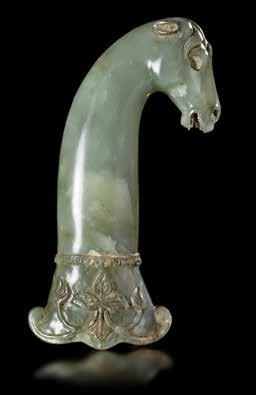
Length: 12 cm.
Estimate € 800 - € 1200
Lot 127
TWO MUGHAL PALE OLIVE GREEN MUGHAL JADE MOUTHPIECES, 18TH-19TH CENTURY

Mouthpieces for a hookah pipe. 11.5 cm. 7.5 cm.
Estimate € 800 - € 1200
Lot 128
A FINE MUGHAL GEM-SET
JAHANGIR PERIOD
17TH CENTURY
A double-edged watered-steel blade with a central ridge, the jade hilt with swelling grip inlaid overall with engraved gold flowers heads and small buds set with ruby.
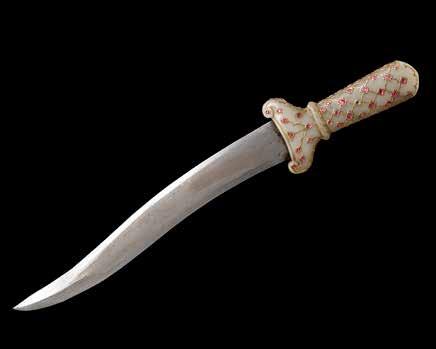
Lenght: 35.5 cm.
PROVENANCE
Private collection, Germany
Estimate € 2000 - € 3000
Lot 129
A MUGHAL GEM-SET DAGGER (KHANJAR), INDIA
18TH CENTURY
The double-edged steel blade with central ridge and swollen tip, the green-enameled hilt with a rounded pommel, inlaid with gold and gem-stones with scrolling stems issuing buds and lotus blossoms.

Length: 32 cm.
Estimate € 8000 - € 12.000
Lot 130
A GEM SET ROCK CRYSTAL HILTED DAGGER, MUGHAL INDIA, 18TH CENTURY
A double-edged watered-steel blade, the rock-crystal hilt with scroll quillons and rounded pommel, inlaid with gold and gem-stones with leaves, the cloth-covered scabbard.
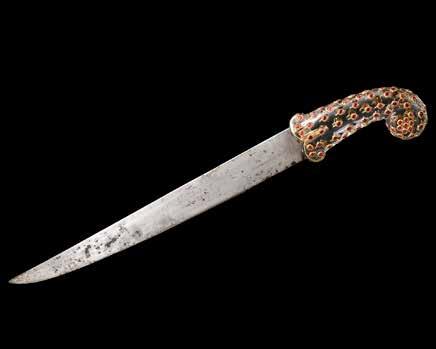
Length: 47 cm.
PROVENANCE
Private collection, Germany
Estimate € 5000 - € 8000
Lot 131
A MOTHER-OF-PEARL HILTED DAGGER (PESHKABZ), INDIA GUJARAT, 18TH CENTURY
The single-edged watered steel blade of tapering form, the hilt clad entirely with mother-of-pearl plaques secured with pins, the spine with a palmette to the forte.
Length: 44.5 cm.
PROVENANCE Private collection,Germany
Estimate € 1200 - € 1500
Lot 132
A MUGHAL ROCK-CRYSTAL HILTED WATERED-STEEL DAGGER, INDIA


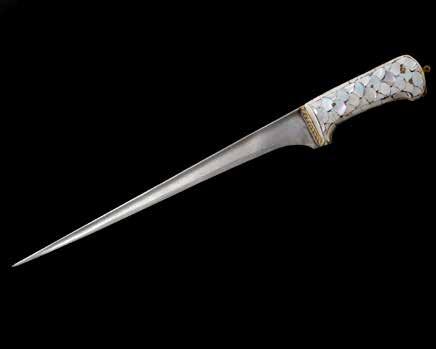
17TH-18TH CENTURY
The curved double-edged blade with central ridge and decorated with cartouches enclosing a flower, the hilt carved with palmettes and rosettes with silver guard engraved with floral arabesques.
Length 43.5 cm.
Estimate € 2000 - € 3000
Lot 133
AN INDIAN STEEL DAGGER (CHILANUM), INDIA
18TH CENTURY
Of typical form with curved and tapering double-edged blade with six converging fullers to each side, the hilt with baluster grip, hand guard and bifurcated foliate pommel with bud finial, the hilt decorated with foliate motifs.
Length: 35 cm.
Estimate € 1000 - € 1500
Lot 135
AN OTTOMAN DAGGER WITH TOMBAK HILT AND SCABBARD

TURKEY, 19TH CENTURY
The slightly edged double-edged watered steel blade with a raised central spine, the tombak waisted hilt of typical form engraved with leafy sprays and inscriptions ‘
Amal Ammar, work of Ammar’.
The scabbard with tomabk chape and locket.
Length: 47 cm.
Width: 7 cm.
Estimate € 1500 - € 2000
Lot 134
A CEREMONIAL GOLD DAMASCENED STEEL AXE, DATED 1120 AH/1708 AD

A Mughal axe or tabar in the form of an ibex and tiger, the steel crescent shaped blade emanating from a tiger and terminating in an ibex head with fine damascened decoration of floral leafy sprays, with incised handle.
Length: 70.5 cm.
PROVENANCE Private collection, Germany
Estimate € 3000 - € 5000
Lot 136
AN OTTOMAN SILVER DAGGER (HANCER) TURKEY, 19TH CENTURY
Plain silver hilt with scalloped shoulder, with openwork to the blade, decorated in gold overlay. The plain silver scabbard marked with the tughra of Mahmud II 1223-55 AH/1808-39 AD.
Length: 51 cm.
Estimate € 6000 - € 8000
Lot 137
AN OTTOMAN SILVER DAGGER (HANCER) TURKEY, 19TH CENTURY
Plain silver hilt with scalloped shoulder, the slightly curved blade with gold damascening decoration at forte.


The plain silver scabbard with a grape-bearing vine frieze mount, marked with the tughra of Mahmud II 1223-55 AH/1808-39 AD.
Lenght: 50 cm.
Estimate € 3.000 - € 5000
Lot 138
AN IVORY MUGHAL DAGGER HILT, 19TH CENTURY
The ivory hilt carved in the form of a ram head, the quillons in the form of leaves, the hand grip carved elegantly with a band of flower heads amongst scrolling foliage.
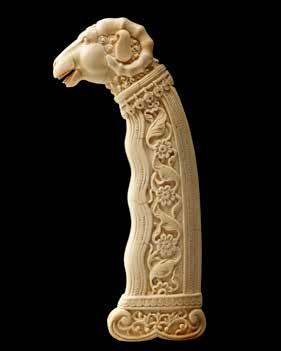
Length: 10.5 cm.
Estimate € 1500 - € 2000
Lot 139

The tapering, double-edged watered steel blade with central ridge and raised inscription in shaped cartouches chiselled on both faces at the forte, the bone hilt with waisted facted grip.
Length: 50 cm.
Inscriptions
on the blade: On one side: the Basmallah with a cartouches enclosing ‘ya fattah’, ‘O The Opener [of all doors]!’
On the second side part of v.13 from surah Al-Saff “ ya fattah”. On the grip: surah Al-Ikhals repeated two times.
Attributed to Faizallah Shushtari Isfahani, the Persian metalsmith who forged this weapon. Some information is known about Faizallah Shushtari Isfahani, who lived and worked in the late 17th to early 18th centuries in Iran, and whose nisba (place-name) associates him with the city of Isfahan. In 1707–8, he was commissioned by the Safavid Shah Sultan Husayn (r. 1694–1722) to make sets of steel door plaques for the Shrine of Imam Reza in Mashhad.
Estimate € 8000 - € 12.000
Lot 140
AN EARLY SAFAVID PIERCED BRONZE PROCESSIONAL STANDARD (‘ALAM) PERSIA, DATED 924 AH/1518 AD
Of drop form, surmounted by a small jar, the cut-steel body around two central drop shapes formed of solid steel engraved with scrolling vine, a broad outer border with surah Al-Ikhlas in elegant thuluth on a ground of scrolling vine, surrounded on the outside by a solid band issuing alternating pendants. Length: 52.5 cm.

PROVENANCE Private collection, Germany
CATALOGUE NOTE
A very similar example can be seen in Al-Sabah collection, ‘Islamic Art and Patronage: Treasure from Kuwait’ exhibition at Auckland Museum 2003 from April 17th to June 22nd. Standards, military, religious and royal, can be traced back through the history of Persia, and examples have been noted in Luristan, Achaemenid and Sasanian art. The use of steel or brass standards in Islam can be traced back to at least the 14th Century and their current form, with almond-shaped centre, ornamental point and dragons’ heads turning outwards, dates back to the mid-15th Century, as documented in miniature paintings. A miniature from the 1475-81 Khamseh of Nizami, produced in Tabriz and now in the Topkapi Saray Museum shows thirteen examples of this type of standard (Basil Gray, The Arts of the Book in Central Asia, Unesco, 1979, pl. 134).
Estimate € 10.000 - € 12.000
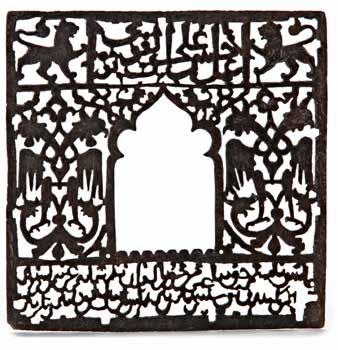
A grave panel pierced at the top with Arabic calligraphy flanked by two lions, the central register with a mihrab shaped panel flanked by Seljuk double headed eagle, the lower register with Arabic calligraphy.
Inscriptions: at the top reads “This work is of Ali Hasan al-Qonoui”.
At the bottom reads” Abu al-hussain Salim Abdulkarim ibn Said ibn Salim lived till Muharem 409 AH/1018 AD. 16.5 by 16.5 cm.
Estimate € 4000 - € 6000
Lot 142

Engraved decoration on one sides of cursive calligraphy.
Height: 52 cm.
Width: 17.5 cm.
Estimate € 3000 - € 5000
Lot 143

The elongated blades terminating in handles of calligraphic form, the gold damascened decoration comprising panels of dense stylised floral and foliate motifs. One handle worked in the form of the word: al Fatah “Oh Opener”. Length: 25.5 cm. and 26.5 cm.
Estimate € 2000 - € 3000
Lot 144
A standard, of circular form, decorated with three lines of elongated Thuluth script below a lamp emblem, remnants of gilding, heavy corrosion.
Diameter: 30 cm.
The partially legible inscriptions include the following:
Upper band: Allah … Muhammad
Central band: rasul Allah, Abu-Bakr…..
Lower band: ‘Umar al-faruq, ‘Uthman dhi’l nurayn.
This finial bears the names of the rightful Calips below the name of God and his Prophet Muhammad. Its form suggests it was a finial within a religious context. The script is clearly Mamluk in feel, as is the use of gilt-copper, even though the execution is relatively provincial. The tripartite division of the roundel also immediately suggests the Mamluk blazon concept, particularly from the later period, while the upper lamp also echoes the saqi or cup-bearer’s blazon. This echo Is enhanced by the upper band above the motif, similar to the upper part of a tripartite blazon.But the ‘blazon’ is a mosque lamp, not a cup, and the inscription is clearly completely religious, even if not all is easily decipherable. The form suggests a processional standard, but it has to be Sunni rather than Shiite, and in any case the support would need reinforcement were it to have been used on top of something that moved. It seems much more probable that it was made for use in a static context, potentially on top of an architectural element of possibly a furnishing such as a minbar.One further clue is given by the arrangement of the script. The larger bolder lettering runs the full height of each register, while through the centre runs a secondary series of words which are more angular and at times have elements, particularly the long horizontals that are more akin to kufic than to cursive scripts. This overlaying of a minor band of kufic through a band of larger cursive script was not a feature of Mamluk architecture, but is found throughout the Timurid world, possible indicating an origin near the borders with the Timurid realm.
Estimate € 8000 - € 12.000

Lot 145
A IVORY HILTED WATERED-STEEL SWORD (SHAMSHIR), PERSIA

DATED 1244 AH/ 1828 AD
The hilt with cusped ivory grips with a curved, single-edged, tapering watered-steel blade, decorated with two gold-inlaid cartouches, a small cartouche enclosing “ his owner Ibrahim and dated 1244AH’, in its leather-covered wooden scabbard with russet iron mounts decorated with further gold cartouches.
Length: 96 cm.
PROVENANCE
Private collection, France
Estimate € 15.000 - € 20.000
ROVENANCE
Lot 146
A QAJAR GOLD-DAMASCENED STEEL SHIELD, PERSIA, 19TH CENTURY
The shield with four applied gilt decorated bronze bosses, the finely carved decoration with a central roundel with cartouches and roundels filled with floral leafy sprays, surrounded by three diaper bands containing cartouches enclosing floral sprigs, hunting scenes, different kinds of animals and Persian inscriptions in large nastaliq script.

Diameter: 43.5 cm.
PROVENANCE
Private collection, France
Estimate € 2500 - € 3500
Estimate Lot 147
A QAJAR GOLD-DAMASCENED STEEL VAMBRACE (BAZUBAND)
PERSIA 19TH CENTURY
The bazuband engraved and gold-damascened with three octograms enclosing figure heads, flanked bo both sides floral sprays filled with a dense designs of flower heads, buds and foliage, the borders with stylised floral garland within cartouches.
Length: 35 cm.
Estimate € 1200 - € 1500
Lot 149

The body of truncated conical form with flanged base, perforated bands and everted drip-pan, the shaft with globed perforated bulb, the socket of spool form with ridges, engraved with a central band of cartouches containing incised inscriptions and thinner bands of chain pattern and foliate motifs. Height: 21.6 cm.
Inscription
li-sahibihi al-sa’ada / wa al-salama / wa tu [l] / al’umr sahat (sic.) [ma nahat] hamama a / ‘To its owner Happiness and Well-being and Long-life as long as the dove coos’ This inscription can be found on Persian metalwork as early as the third quarter of the thirteenth century and continued to be engraved on later Persian and Ottoman works (see Melikian Chirvani 1982, p. 143).
PROVENANCE Private collection, Germany
Estimate € 12.000 - € 15.000
Lot 148
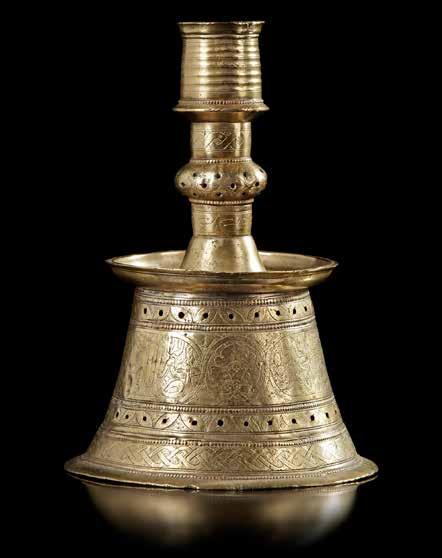
The ovoid body with a domed hinged cover surmounted by a baluster-form finial, decorated with palmettes containing an openwork foliate design separated by engraved floral motifs on a tall, gently splayed foot attached to a circular tray also engraved and punched with foliate palmettes and leafy vines.
Height: 18 cm. .
Diameter: 20 cm. max.
PROVENANCE Private collection, Germany
Estimate € 5000 - € 8000
Lot 150
An Ottoman tombak door knocker pierced with interlacing openwork of floral leafy sprays.

Diameter: 13 cm
Estimate € 3000 - € 5000
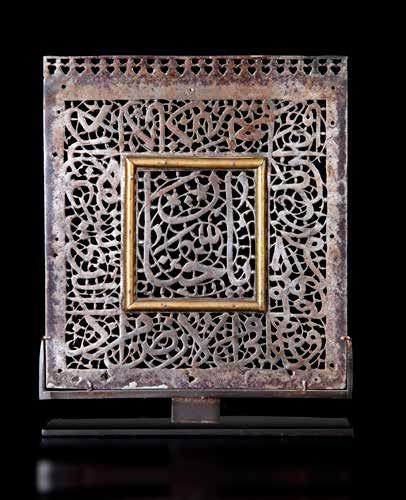
of rectangular openwork form, the field divided into two zones: a central rectangular zone filled with inscription on a ground of scrolling flowers and split palmette leaves, framed by a rounded surround; and a border filled with inscription on a similar ground, the plain steel outer borders pierced with holes, the upper border with a frieze of trefoils 17.1 by 15.5 cm.
The inscriptions in the centre “Ya Hannan’ (Oh, the Most-Compassionate)”, in the borders part of Ayat Al-Kursi v.255 from surah Al-Baqraa
Estimate € 1500 - € 2000
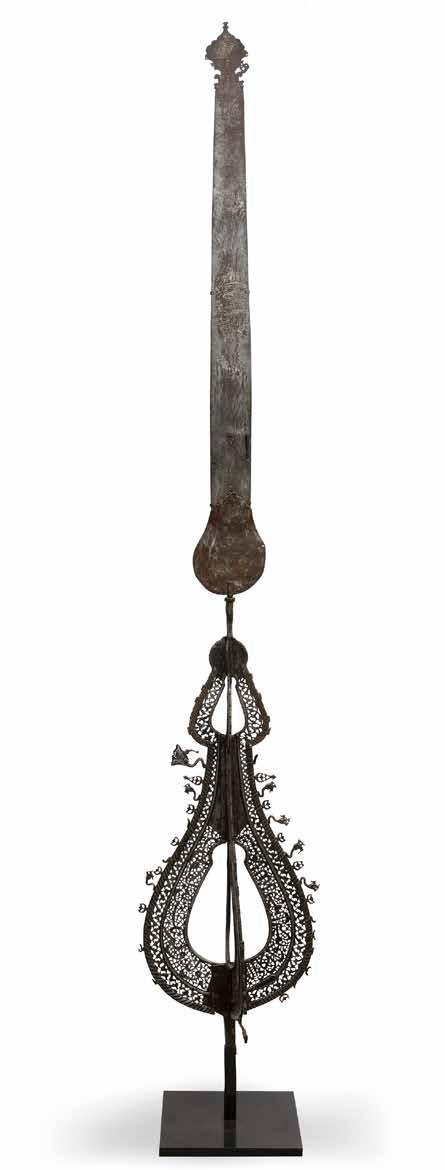
Comprising two drop-form sections fitted together with a quarter-lobed finial, featuring a tall fitted terminal above, the openwork design comprising elegant cursive calligraphy against a ground of foliated scrollwork bordered by a band of palmettes, within a ridged frame featuring stylized dragon-head terminals in between palmettes, mounted on customised metal stand.
Height: 265 cm.
Inscriptions
surah Al-Ikhlas and v. 51 from surah Al-Qalam
Estimate € 30.000 - € 40.000
Lot 153
Each of square form made of stone-paste, painted in yellow, turquoise, cobalt blue, black and opaque white with manganese purple in the cuerda seca (dry-cord) technique. Three tiles decorated with a figure of an archer seated on a horseback aiming at a deer in hunting scene amongst blossoming trees. Two tiles decorated with a seated youth drinking wine in a landscape. 20.5 by 20.5 cm.
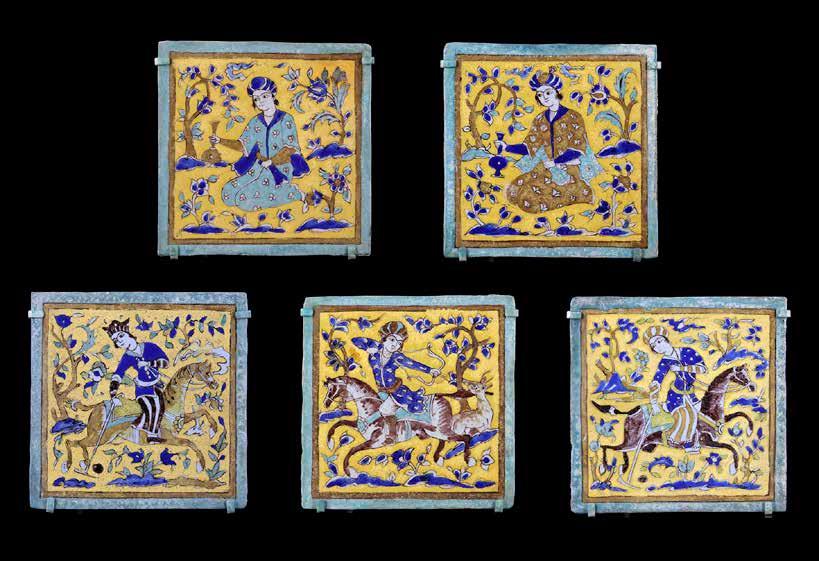
Cuerda seca (Spanish for ‘dry cord’) developed as a technique alongside tile mosaics in the latter part of the fourteenth century in Central Asia and consisted of complete tiles painted with colored pigments which were separated from each other to prevent running by an oily substance mixed with manganese, which left a dark lining after firing.The technique continued to be utiles throughout Persia into the seventeenth and early into the eighteenth century.
Estimate € 4000 - € 6000
Lot 154
AN IMPORTANT KHURASAN SILVER INLAID BRONZE BOX

PERSIA 12TH-13TH CENTURY
A Khurasan twelve-sided box with lid applied with three hinged handles, decorated with silver-inlaid figures, zodiac signs, horsemen and animals within silver-inlaid interlacing geometrical frames. The lid decorated with a central geometrical designs surrounded by a band of Arabic inscriptions in Kufic script with traces of silver.
Height: 8 cm.
Diameter: 10 cm.
Estimate € 8000 - € 12.000
Lot 155

On short splayed foot with a stylised kufic inscription and a lobbed drum-shaped body, each lob engraved decorated with two roundels enclosing floral leafy sprays and flanked by three bands of Kufic inscriptions, the shoulder decorated with a band of elegant thuluth inscriptions, the narrow neck on each side with a pronounced tiger boss and one further to the spout, a simple handle connecting the neck with the body.
Height: 37 cm.
Inscriptions
perpetual glory, safe life, clear vision, approaching the best and best luck to its owner.
Lot 157
AN AYYUBID GILT BRONZE MAGIC BOWL, EGYPT OR SYRIA
13TH-14TH CENTURY
Of shallow rounded form engraved to the interior with talismanic diagrams and inscriptions, stars and images of a dog, snake, scorpion and two-headed dragon, the exterior with a band of inscriptions to the rim.
Diameter: 10.5 cm.
Inscriptions
the outer band contains the names of various ailments that would be cured if drunk from this bowl, to the inner bowl quotes from the Quran, talismanic, magic texts and numbers.
PROVENANCE Private collection, Germany
Estimate € 3000 - € 5000
Lot 156
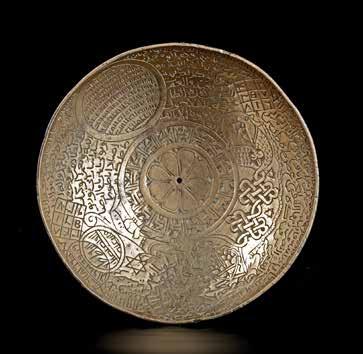
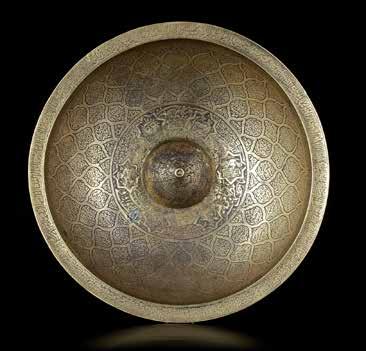
17TH CENTURY
Of rounded form with raised central boss and everted rim, finely incised and decorated with black lac, the interior with a band of roundels containing figures and a sun interspersed by inscription, surrounded by a band containing a repeat design of interlocking inscription-filled cartouches in nastaliq and thuluth, the border and rim with further inscriptions, the exterior with a series of cartouches containing the twelve signs of the zodiac, all on a ground of inscription, above and below bands of inscription, two bands of inscription-filled cartouches to foot.
Diameter: 22 cm.
Inscriptions including the Call to God to bless the Twelve Imams or the Fourteen Innocents and Quran, including alNasr and al-Saff.
Estimate € 2500 - € 3500
Lot 158
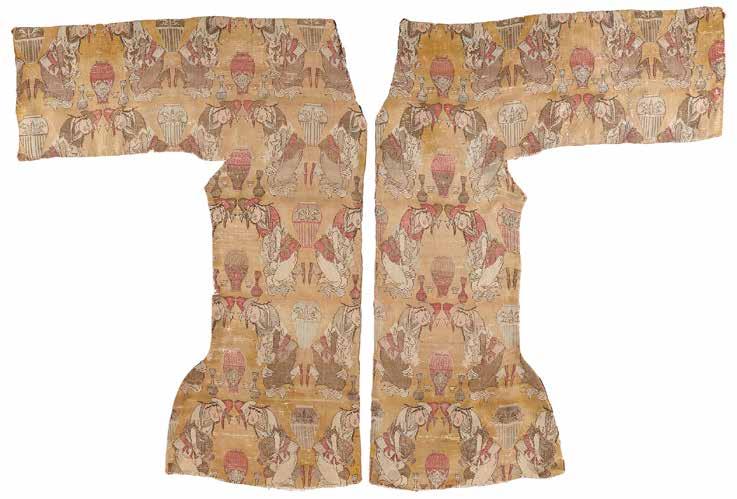
The pattern depicts a courtier holding a wine jar pouring into a smaller bottle, a popular theme in Iranian decorative arts. The design features a seamless repeat pattern, elegantly alternating red, white and ochre yellow for the courtier’s cloak as well as the back ground, a design used by weavers to add variation. This pictorial composition is similar to manuscript paintings produced during the reign of Shah Tahmasp, and may be inspired by mystical poetry referencing wine and gardens. 84 by 56 cm.
Private collection, Germany
Estimate € 6000 - € 8000
Lot 159
A MAGNIFICENT GERMAN IVORY TANKARD WITH PARCEL GILT MOUNTS DEPICTING AN OTTOMAN BATTLE, MADE FOR THE TURKISH MARKET
19TH CENTURY
The large and impressive tankard surmounted by a carved ivory figure of an Ottoman warrior holding a shield, on the domed brass, hinged cover decorated with pierced gilt scrolling Arabesques, the body of the tankard intricately carved with a battle scene from the Russo - Turkish war, with numerous figures on horseback and camels, the scrolling handle carved as the bust of a Russian soldier, raised on a domed base with pierced decoration, Height: 38 cm.
Estimate € 20.000 - € 30.000
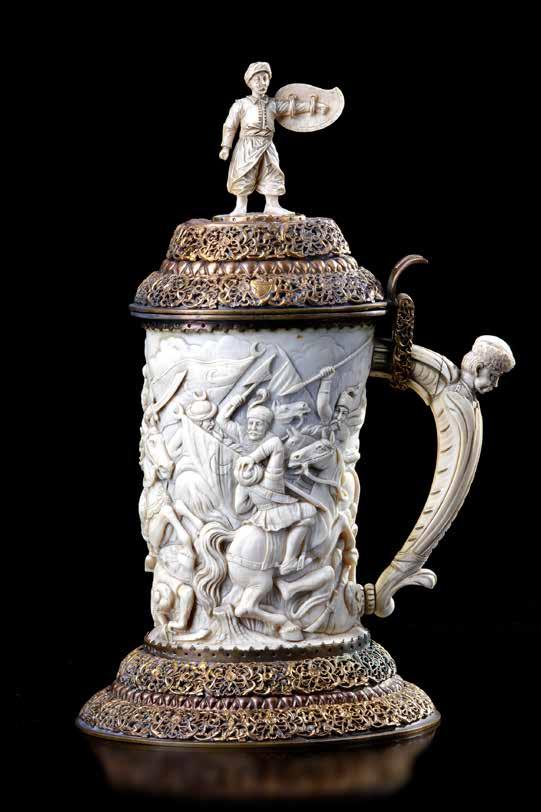
Lot
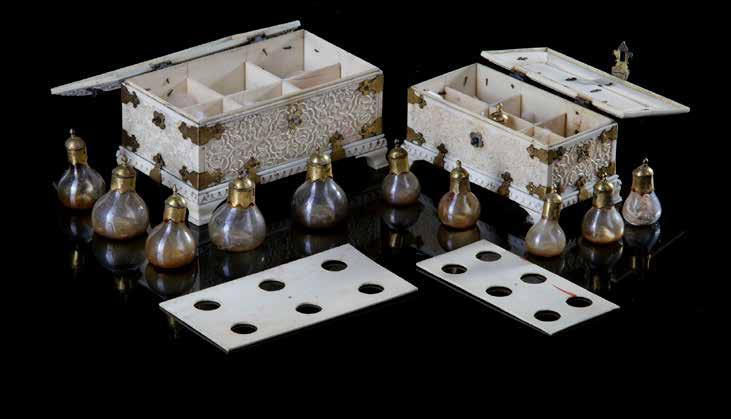
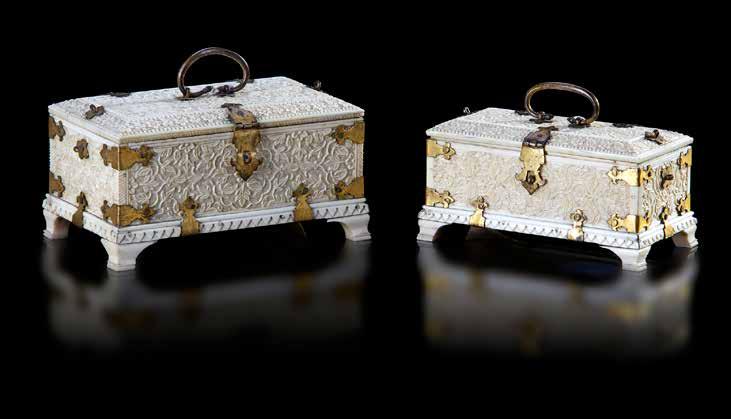
Both of rectangular shape, each resting on bracket feet with gilt mounts, the low relief-carved decoration with dense repeat reticulated floral designs. The inside is divided into six compartments filled with small perfume bottles.
5.2 by 10.8 cm.
6.8 by 12.2 cm.
Lot 161
A KHOLMOGORY SCHOOL CARVED BONE BOX WITH MUGHAL INFLUENCE

18TH CENTURY
The whole is richly carved with openwork plaques, which are heavily- inspired by Mughal decoration. The decorative plaques represent love, birds, dogs, squirrels and hunters, along with foliate-silhouetted rocks. The bottom part with interlaced quatrefoils; fleurs-de-lys, branches, foliage.
Kholmogory School, Arkhangelsk region
Height: 28.2 cm.
Length: 38 cm.
Estimate € 3000 - € 5000
Lot 162
A TIMURID CUERDA SECA POTTERY TILE, CENTRAL ASIA, 14TH-15TH CENTURY
Square, painted in green, yellow, red, turquoise and black outlines in reserve on a blue ground with a knotted Kufic inscription (al-mulk li-llah ‘Dominion is God’s’.)
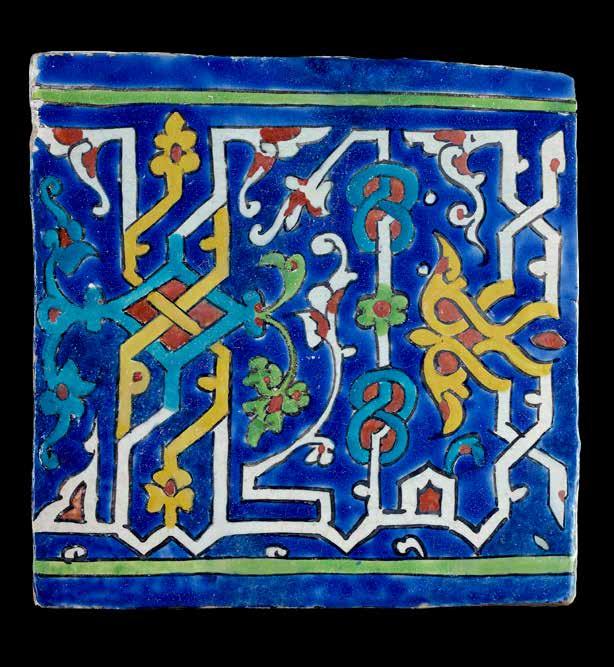
Approx 28 by 27.5 cm.
PROVENANCE
Private collection, Germany
CATALOGUE NOTE
The Kufic inscription on this superb tile can be compared with the frontispiece from a manuscript copied for Bayjunghu ibn Shahruk in Herat around the year 1430 (Thomas W. Lents and Glenn D. Lowry, Timur and Princely Vision, Exhibition catalogue, Los Angeles County Museum of Art, 13th August - 5th November 1989, fig. 43.
Estimate € 8000 - € 12.000
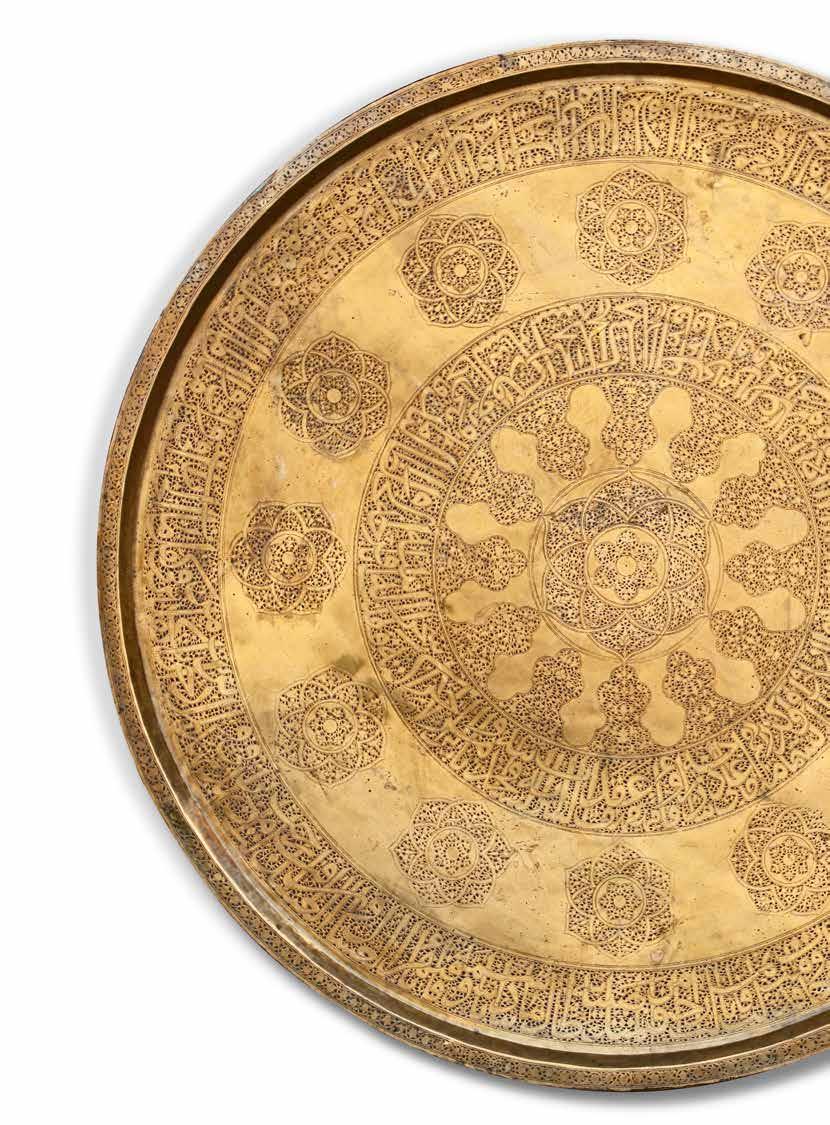

Of flat circular form with everted rim, the base with central radiating roundel containing strap-work rosette, further encircled by a broad band of bold thuluth followed by twelve ogival medallions containing arabesques and outer broad band in thuluth uninterrupted. The rim wit a simple plaited band.
Diameter: 112 cm.
Inscriptions in the tray
A poem from the famous poet Abu Al-Wafa Bin Omar Bin Abdul-Wahhab, the Shafi Mufti in Aleppo, 973 AH/1565 AD.
One of the most eminent scholars in knowledge, mastery, memorization and control in Aleppo in that time.
Estimate € 8000 - € 12.000
Lot 164
A SULTANATE COTTON TALISMANIC JAMA, MADE FOR AKBAR SHAH II INDIA, DATED 1255 AH/1810 AD
A shirt (jama) covered with text written in thuluth, naskh and ghubari scripts, in assorted colors, roundels and cartouches. The inscriptions include quotations from the Quran and the 99 Beautiful names of Allah. The cotton shirt inscribed with the entire text of the Quran written in black and red ghubari within a lattice of rectangles linked with red, blue roundels, surah headings written in naskh gold script outlined in black, each shoulder with a cluster of similar roundels with the words ya Allah, ya Hafiz and ya Fatih in gold, each rectangle with a single verse roundel in gold and polychrome at its centre, the lattice on either side interrupted by two large roundels containing kalifaat al-Tawhid in elongated gold bihari in mirrored style on a red and blue ground, each section of the lattice bordered with a wide band with the 99 names of Allah written in large thuluth gold script outlined in black in clouds reserved against a band of pink, red and blue dots on hatched ground. 103 by 72 cm.
This talismanic shirt was believed to be imbued with protective powers and may have been meant to be worn under armor in battle.
Estimate € 10.000- € 15.000

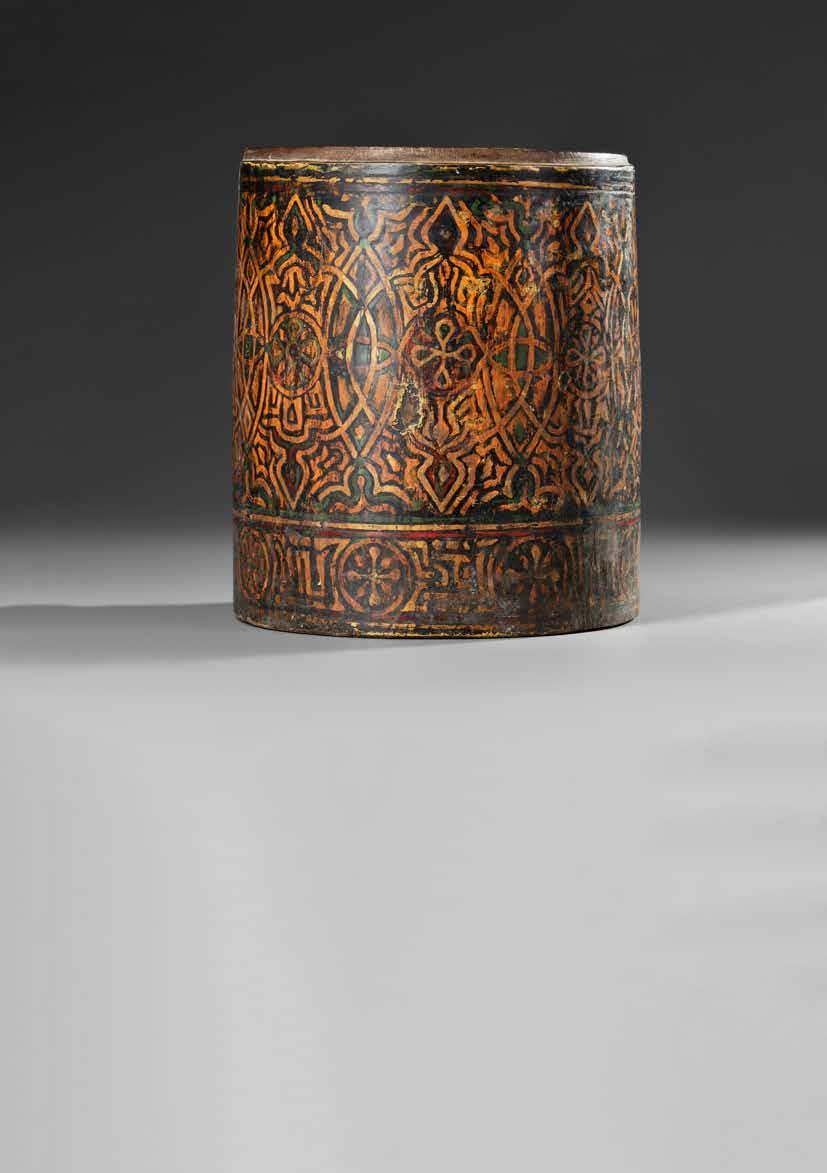
With flat base and slightly sloping sides, the upper edge with slight recess to fit a lid, the exterior wooden surface overlaid in a succession of black, red, yellow and green and orange lacquers, then carved through to reveal a polychrome design, the broad central band with lobed roundels containing scrolling arabesques, the borders of the panels entwining and continuing into lobed concentric quatrefoils dividing each panel, a band below of stylized thuluth calligraphy interrupted by roundels containing quatrefoil panels.
Height: 31 cm.
Diameter: 26 cm.
Estimate € 5000- € 7000

Brass Qibla.
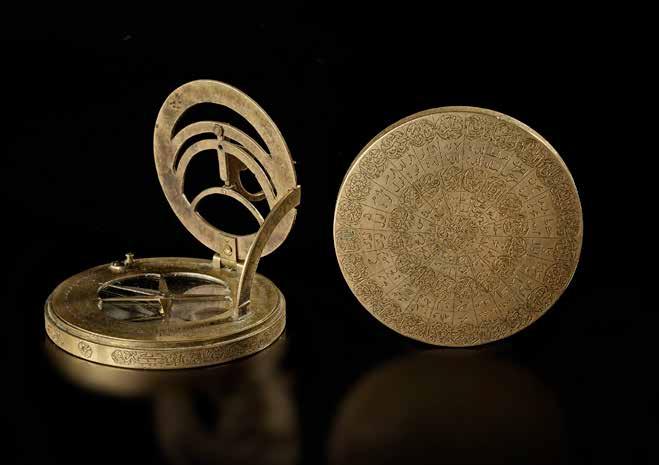
Diameter: 8.2 cm.
Height: 8 cm.
This portable qibla finder is of the rare kind that is fitted with a “European style” sundial. The sundial on the instrument is generally known as the “universal inclining sundial” and was very common in Europe in the eighteenth and nineteenth centuries. According to David King, some of these sundials might be imported from Europe but engraved in Persia. It is universal since the hour-dial can be elevated to match any terrestrial latitude.
The numbers on the hour-dial are highly stylized forms of Arabic numerals and are often found on clocks and watches made by Europeans for Persian and Turkish markets in the eighteenth and nineteenth centuries.
Similar Instruments:
There are three other instruments known, which have a similar European sundial. The first is in the collection of the Museum for the History of Science in Oxford, while the second one is found in the collection of the National Maritime Museum. A third instrument can be seen on p.27 of the 1931 exhibition catalogue “An Illustrated Souvenir of the Exhibition of Persian Art”, however only one image of the instrument (from above) is given.
Besides the above mentioned three instruments which are qibla finders of the regular type using gazetteers for indicating Qibla information, two 17th century Safavid “universal qibla finders” containing a world map grid were also fitted with a similar sundial. At least one of the surviving instruments is still fitted with a European style universal inclining sundial, similar to our instrument.
Literature:
David A. King, Two Iranian World-Maps for Finding the Direction and Distance to Mecca. Imago Mundi, Vol. 49 (1997), pp. 62-82 (22 pages)
David A. King, World Maps for Finding the Direction and Distance to Mecca, Brill, Leiden, 1999 ( See p. 284, section 8.2.1 for information on the type of numerals and p. 292, section 8.2.3, for information on the inclining sundial)
Estimate € 20.000 - € 30.000

In cast brass, hammered and engraved, entirely inscribed in Maghribi Kufic Arabic, unsigned.
Diameter: 10 cm.
Height (including ring): 16.5 cm.
The limb of the instrument, fused in one piece with the kursi (throne), is riveted at four points on the back to form the mother. A 360° scale is engraved on the limb, divided by groups of two degrees and numbered by groups of ten degrees. The kursi is composed of three lobes decorated with four circles. The spandrels are three in number, they are engraved on both sides, there must have been a fourth. It is a representation of the globe, they are circular and provided with a small appendix of square form which allows their maintenance in the mother.
They serve the following precise latitudes: 31°30 Marrakech, 33°30 Fez, 35° Tangier, 30° Cairo, 34° For all cities of such latitude, 36° For all the cities of such latitude
Each tympanum has arrowed lines indicating the prayers and the horizon. The back is engraved with six concentric scales, including a zodiacal calendar and a Christian calendar. In the center, a shadow square is used to determine the meridian height of the sun, knowing the latitude of the place. The alidade, screw and nut are original.
Estimate € 80.000 - € 120.000
Private collection, Germany
The astrolabe is a scientific instrument intended to read the solar or stellar time in a given point, to make astronomical or astrological observations.It was used by the “Time Calculators” to calculate the time of prayers, lunations (for Ramadan), the orientation of Mecca and the establishment of horoscopes. For navigation, it has a set of disks called tympanums, allowing to adjust the representation of the sky according to the latitude of the place. The spider representing the ecliptic circle, and pointing the position of the main stars of the sky turns around the axis. A ruler allows to measure the height of a star or to point a mark on the limb of the astrolabe.
The spider marks the position of 24 stars with their names (twelve northern stars inside the ecliptic and twelve southern stars outside), by indexes in the form of hooks. There are three brass mudir (small nail to turn the spider)

Lot 168
AN OTTOMAN DAIRAT AL-MUADDIL (COMBINED SUNDIAL AND QIBLA FINDER), 17TH CENTURY
Diameter: approx. 24 cm.
The dairat al-mu’addil (Eng. equatorial circle) is an instrument with combines a sundial with a qibla indicator. It was invented by the 15th century astronomer and timekeeper at the al-Mu’ayyad mosque in Cairo, ‘Abd al-Aziz ibn Muhammad al-Wafa’i al-Miqati. It was later also described by other scholars, including the Turkish admiral Seydi Ali Reis, making the instrument very popular in Ottoman circles. [Maddison & Savage-Smith, p. 277].
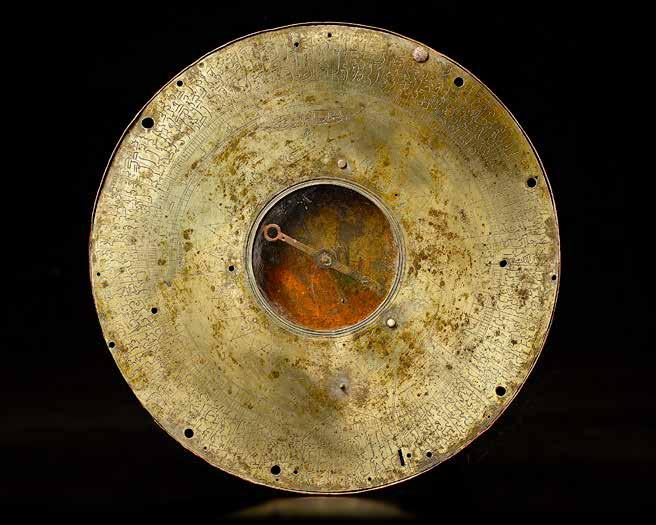
Al-Wafa’i’s instrument seems to be inspired by another instrument, namely the “Sanduq al-Yawakit” or the “Jewel Box”, invented by an earlier, well-known, fourteenth century Syrian astronomer and timekeeper Ibn al-Shatir. [King, p.53]
Estimate € 10.000 - € 14.000
The main disk of the instrument consists of a circular brass plate. The center of a disk features a magnetic compass. Around the magnetic compass is a wind-rose with the typical four quarters of the compass: shimal (north), junub (south), sharq (west), garb (east)], and in between alternatingly in Ottoman Turkish “orta” (intermediary winds) and “kerte” (rhumb lines).

Around the circumference are marked the names and Qiblas of various localities. When the compass is used to align the instrument along the cardinal points, the Qibla can be read off simply by locating the name of the locality and reading of the direction of the Qibla.
The instrument also features a small sundial below the south point of the instrument equipped with a small gnomon.
The various holes on the instrument are due to the missing parts such as four leveling screws and a graduated semi-circular arc which is hinged along the east-west line of the instrument. This arc can be inclined at any desired angle to the horizontal plane by means of the graduated scale in the plane of the meridian.
In this case this semi-circular arc and the graduated scale are missing along with other smaller parts.
DATE AND MAKER
The instrument is signed by the maker above the north point of the instrument in a cartouche as “ ’Amal Hasan Baba al-Duyuwi 1171” [1757/1758 AD], who seems to be unknown to literature.
W. Brice, C. Imber and R. Lorch, The Dāi’re-yī Mu’addel of Seydī ‘Alī Re’īs. Seminar of Early Islamic Science, Monograph no. 1, University of Manchester, July 1976
David A. King, “An Islamic Astronomical Instrument”, Journal for the History of Astronomy, Vol. 10 (1979), Issue 1, p 51-53
Francis Maddison & Emilie Savage-Smith, Science, Tools and Magic. Part One. Body and Spirit, Mapping the Universe. Nour Foundation, Oxford, 1997, p. 277-279
Lot 169
AN ILLUSTRATED
TREATISE BY AL-JAGHMINI, COPIED
 BY MIRZA MUHAMMED TAHER BIN MIRZA MUHAMMED IBRAHIM
BY MIRZA MUHAMMED TAHER BIN MIRZA MUHAMMED IBRAHIM
AND DATED 826AH/ 1422AD
This compendium of astronomy, entitled al-Mulakhkhas fi al-Hay’ah, was composed by Mahmud ibn Muhammad ibn Umar al-Jaghmini al-Khwarizmi.
Arabic manuscript on paper, 22 leaves, written in black naskh script, tiltes and catchwords in red ink.The text contains 13 illustrations of the following diagrams: the cosmos and the spheres of the Sun, the stars, Mercury and the Moon.
Al-Mulakhas ( Ptolemaic theoretical astronomy) is an astronomical textbook describing the celestial orbs, the Earth, and their relations. It is simplified compared to other astronomical texts from the same period. The book comprises an introduction on simple and complicated bodies and celestial spheres, followed by two articles, the first on astronomy and the second on geography, trigonometry and astrology. 18.5 by 14 cm.
Estimate € 20.000 - € 30.000
Private collection, Germany
Mahmud al-Jaghmini (died circa 618 AH/1221AD) composed multiple scientific works in Arabic in the late 12th and early 13th centuries under the auspices of the Khwarazmshahs in Central Asia. Two of his compositions became popular textbooks: an introduction to Ptolemaic theoretical astronomy (al-Mulakhkha fī ilm al-hay’ah al-basita) and his medical treatise al-Qanunca, an abridgement of Ibn Sina’s compendium al-Qanun fi al-tibb. The impact and longevity of their influence is evidenced by the plethora of extant copies of the originals and their many commentaries and translations, which continued to be studied extensively for centuries and disseminated widely throughout the Islamic world and South Asia.
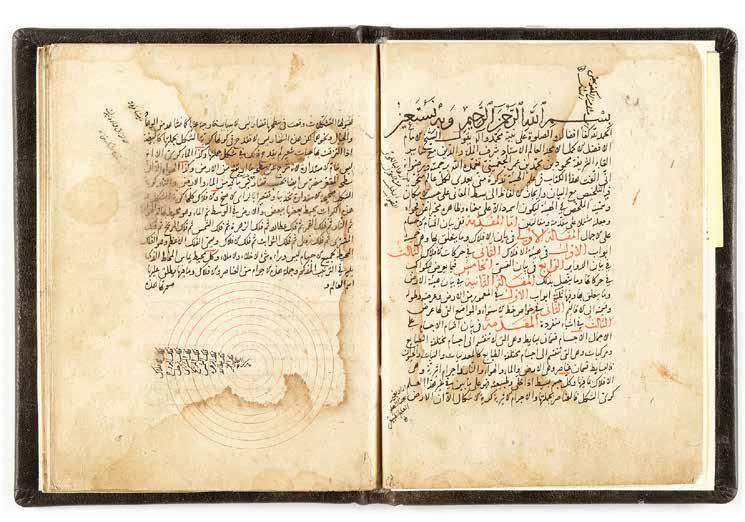
Lot 170
A RARE PERSIAN GUNNER’S CALIPER PRODUCED FOR THE PERSIAN ARMY DATED 1154 AH/1741-42 AD

A very rare 18th century Persian gunner’s caliper (also known as gunner’s compass/ gunner’s sector) modelled after one of the various types of gunner’s calipers developed and produced in 18th century England. Despite the fact that English versions of this instrument are quite common, eastern versions seem to be very rare, since there are very few descriptions or references to similar instruments in literature. The Persian caliper at hand seems to be identical to an English gunners caliper auctioned 30th of October, 2019 at Morphy Auctions, as lot. 1187, made by “Gilkerson Tower Hill London”. A quick comparison shows that the numerical tables and engravings correspond almost identically. The instrument consists of two thin legs or rulers, pivoted with a screw and movable around the screw. Both arms are rounded around the screw. The instrument is engraved on both sides. The arms on the screw side of the instrument are engraved with scales for measuring lengths and diameters in inches and a tables indicating the amount of gunpowder quantity needed for proof and service for various diameters of brass mortars and howitzers for both sea and land. The screw side also has circular scale for measuring the diameter of bores in the round section. The reverse of the instrument contains two tables for artillery: one for brass guns on the upper leg and one for iron guns in the lower leg with two rows of numbers. The Persian captions indicating the tables are textually longer than on the English instrument. For example the caption “proof” on the English instrument becomes “gunpowder weight for testing the cannon” on the Persian instrument. The only inscriptions which are different from the European original are both on the reverse side: (1) the date above the pivot, which reads 1154 (AH) and (2) a vertical inscription indicating “the property of God” left to the pivot.
Length: 17.7 cm.
Estimate € 6000 - € 8000
The gunner’s caliper is a modification of the sector for the use with artillery. The major modification is that the two arms have been hollowed out slightly to allow the user to measure the diameter of canon balls (convex diameter). Most gunner’s calipers also allowed to user to cross the arms over top of each other to measure the diameter inside the mouth (bore) of a cannon. The arms were usually engraved with various scales and tables such as : scales for concave and convex diameters, degrees and tables for weights of iron shot diameters. This caliper is clearly modeled after 18th century European models
J. Robertson, A Treatise of Such Mathematical Instruments as are usually put into a portable case containing their various uses in arithmetic, architecture, geometry, surveying, trigonometry, gunnery etc., London, 1757
M. Williams and E. Tomash, “The Sector: Its History, Scales, and Uses”, IEEE Annals of the History of Computing, vol. 25, no. 01, pp. 34-47, 2003.
David S. Weaver, “The English Gunner’s Caliper”, Arms Collecting, Vol. 33, No. 4, pp. Morphy Auctions Catalogue, 30th October, 219. Lot 1187: FINE SET OF ENGLISH BRASS ARTILLERY CALIPERS.
Lot 171
A PERSIAN SILVER TALISMANIC BAJUBAND CASE, PERSIA QAJAR
19TH CENTURY
A silver circular case engraved with the roundel enclosing Basmallah in large thuluth script, surrounded by two bands of Ayat Al-Kursi in small naskh script, with a band enclosing v. 50-52 from surah Al-Qalam in large Thuluth script. The sides with “Nada Ali” on a floral spray engraved ground.
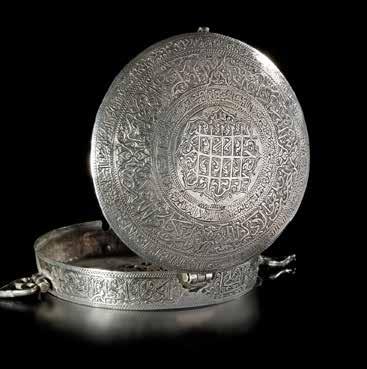
Diameter: 5.9 cm.
Estimate € 800 - € 1200
Of rectangular brass plate on four riveted feet, with inset compass-box, engraved hour lines, place names, cardinal directions, meridian line, with signature in cartouche. 6.8 by 9.8 cm.

Signed as: sana’ahu ‘abd al-aimmah, ‘Made by ‘Abd al- Aimmah’
The upper face carries the hour lines for a horizontal dial counting from sunrise to sunset (Babylonian hours) numbered 1-14 in abjad numerals and with 30-minute divisions ending in trefoil leaves. Time is read from the tip of the shadow of a hinged pin-gnomon set on the meridian line beneath the compass-box. A degree arc in the top right corner is divided by 1° divisions 0-90° with every five degrees numbered in abjad. A narrow leaf-shaped pointer can be set against this scale to mark the inhirâf of a particular place, the value being derived from the table of thirty-eight named places, with their inhirâf, engraved along the edges of the instrument. The four cardinal directions are named, as is the meridian line. The compass retains its original needle in the form of a bird, characteristic of late Safavid and succeeding Persian instruments.
The layout and script of this instrument, although not identical, resemble very closely those on another instrument signed by ‘Abd al-Aimma, fl. 1115 -1132 AH (1703/4-1719/20 AD), see Dominique & Eric Delalande, Cadrans solaires, Paris 2013, p.384, no.21.
Estimate € 6000 - € 8000
Lot 173
Watercolor on vellum, depicting a part of Al-Idrisi’s world map, the names of the places, the rivers and the mountains in yellow, black and red ink. Note that south is at the top of the map.

67 by 50.5 cm.
In the 12th century, scholar Al-Idrisi produced a map showing most of Europe, Asia, and North Africa for the first time. Al-Idrisi ranged widely, drawing on older knowledge and interviewing thousands of travelers to make his map the most accurate of its day. Muhammad ibn Muhammad al-Idrisi (circa 1100–66) was a 12th century geographer from al-Maghrib (North Africa).
As a young man al-Idrisi attended the famous university in Cordoba, and over the course of his life he travelled widely around a Mediterranean divided between several competing Christian and Muslim powers, arriving in around 1138 at the Sicilian court of the Norman king Roger II. The Normans had conquered the Arab Emirate of Sicily in the final decades of the 11th century, and Roger ruled over a linguistically and culturally diverse population: Arab artesans were commissioned to produce art and architecture for the court at Palermo, and many Arab bureaucratic structures remained in place.
Estimate € 6000 - € 8000
Lot 174
AN ASTRONOMY COPIED MANUSCRIPT ‘SHARH AL-MULKHAS FI AL-HAY’A’ OF AL-JAGHMINI (A COMPENDIUM OF THE SCIENCE)
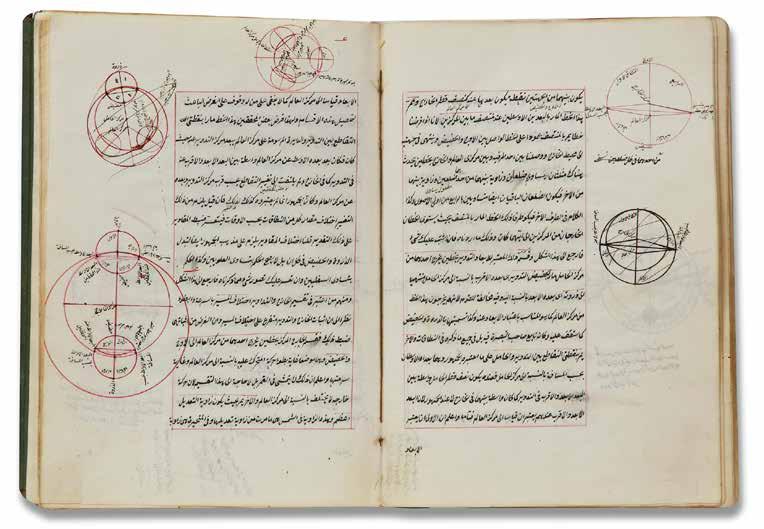 BY SALAH AL-DIN MUSA IBN MUHAMMAD IBN MAHMUD KNOWN AS QADI-ZADE AL-RUMI, COPIED 18TH CENTURY
BY SALAH AL-DIN MUSA IBN MUHAMMAD IBN MAHMUD KNOWN AS QADI-ZADE AL-RUMI, COPIED 18TH CENTURY
This version of the treatise was written by the Turkish mathematician and astronomer Mawlana Salah AlDin Musa Ibn Muhammad Qadi Zada Al-Rumi (765 AH/1364 AD Bursa, Ottoman Empire - 840 AH/1436 AD Samarqand, Timurid Empire), together with another astronomical work, he produced this treatise about Al-Jaghmini ( Mahmud ibn Muhammad ibn Umar al-Jaghmini, an Arabic physician, astronomer and author of ‘Mulakhas’ a work on astronomy completed in 808 AH/1405-6 AD, and seems to have been a commentary on it.The manuscript contains another article written by Abd Ali ibn Muhammad ibn Husayn Birjandi with comments about Al-Jaghmini. So we would consider this book a work of three well-known astronomers, AL-Jaghmini, Birjandi and Qadi-jade Al-Rumi.Arabic manuscript on paper, 76 pages with 17 lines to each folio, written in nastali’q black script with its marks , the topics in red ink, in addition to many illustrations, as well as plenty of comments and margins. The binding with brown leather and cupboard cover. 22 by 16 cm.
Estimate € 1500 - € 2000
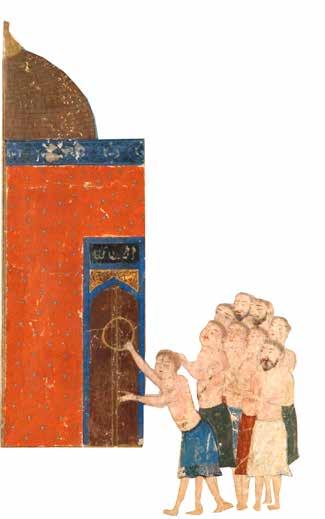
Lot 175
AN OTTOMAN COMPILATION OF PRAYERS AND HOLY PLACES BY ABD
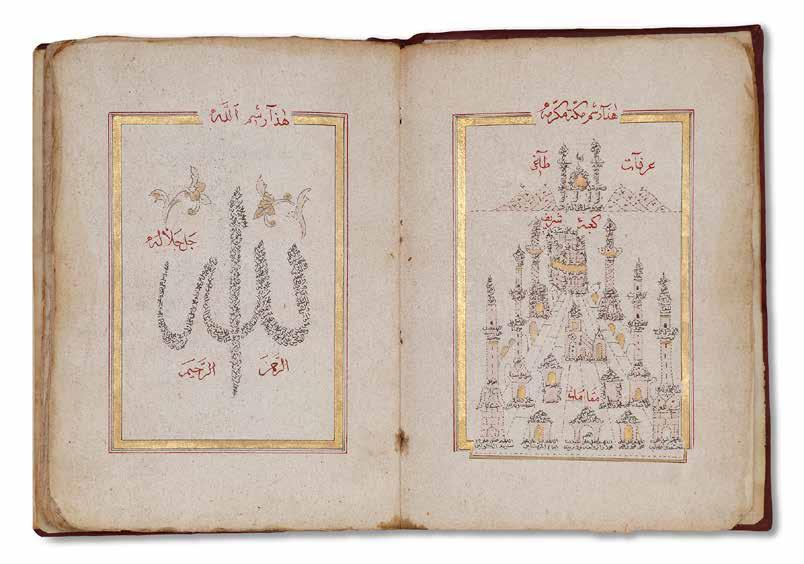 AL-QADIR HUSRI, OTTOMAN TURKEY, DATED
AL-QADIR HUSRI, OTTOMAN TURKEY, DATED
1181 AH/1767 AD
Arabic and Turkish manuscript on paper, 22 leaves plus 2 fly-leaves, elegant black naskh, titles in red naskh ink, within text gilt panel, marginal notes, illuminated headpiece, 19 folios illustrated with depictions of tombs and shrines in Syria, Quds and the Hijaz with different holy items. In later gilt brown leather brown morocco binding with flap. 12.5 by 18 cm.
This extensively and lavishly illuminated compilation includes 43 illustrations depicting numerous subjects. These include: two bifolia with illustrations of Mecca and Medina, venerations of the Prophet Muhammad through depictions of his hand prints, foot prints, and his Seal of Prophecy, further pages pertaining to the other prophets such as the sword of ‘Ali and the seal of the prophet Sulayman and Moses. The manuscript is signed and dated by the calligrapher Abd al-Qadir Hisari, a prominent mid-eighteenth-century master known for his calligrams and pictorial calligraphic compositions, such as the galleon with inscriptions referring to the story of the Seven Sleepers in the Metropolitan’s collection (2003.241)
Estimate € 8000 - € 12.000
Lot 176

18TH CENTURY
Arabic manuscript on paper backed on silk, written in naskh, thuluth, muhaqqaq and angular Kufic scripts in various colors.
17 by 470 cm.
The scroll opens with
1-the Basmallah written in thuluth script against a black background with the letters intersticed in gold within a cartouche in the shape of a cypress tree and surrounded by v.1-v.4 from surah Al-Fath.
2-It is then followed by roundel containing the word ‘Muhammed’ and surrounded by v.5 from surah AlFath in gold and black ink.
3- Followed by a rounded cartouche enclosing the words ‘Ya Rab al-Almin’ on a green ground, a rectangular containing al-Basmallah in mirrored style and angular Kufic script, roundels enclosing the attributed names of the Porphet Muhammad surrounded by Quran verses, all surrounded by al-Basmall prayers in large thuluth script intersticed in gold on a black ground.
4- A rounded cartouche with a square enclosing v.13 from surah Al-Saff in thuluth script and mirrored style, Al-Basmallah in angular script, two square of prayers in large script on a green ground, surrounded by cartouches enclosing Al-Basmallah prayer with different Quran verses.
5- A roundel enclosing the word ‘ Al-Nasir’ in large thluth script surrounded by surah al-Kawthar and other Quran verses.
6- A rounded cartouches with illustration of al-Masjid al-Haram at the top, followed by squares of the 99 beautiful names of Allah, an illustration of al-Msjid al-Nabawi, prayers with Quran verses.
7- A rounded cartouche with a square enclosing, squares of prayers in large script on a green ground, Al-Basmallah in angular script, surrounded by cartouches enclosing Al-Basmallah prayer with different Quran verses.
Signed by ‘ Written by Ibrahim Bin Abdul-Rahman known as al-Maqdisi.
Estimate € 4000 - € 6000

Arabic manuscript on paper, each folio with 12 lines of elegant black naskh, gold and polychrome roundel verse markers, large gilt and polychrome floral marginal ‘juz and hizb’ medallions, text within gold and polychrome rules, surah headings in red on cartouches with gold ground and gold and polychrome floral illumination at either end, occasional marginal commentary in gilt thuluth script on a blue decorated ground, opening six bifolia fully illuminated in gold and polychrome, end of the text with prayers and dedication, written by Ismail in Esterabad in 1244 AH/1828 AD. In gilt Qajar lacquer binding with central cartouche enclosing flower heads and surrounded by spandrels containing scrolling floral. 9 by 14 cm.
Estimate € 12.000 - € 15.000
Gouache heightened with gold on paper, ruled in black and blue, with a thin green border. Depicting the holy Nabawi-Mosque surrounded by houses in Medina. 44 by 61 cm.
In style these paintings relate to others of Mecca and Medina done by Indian artists. The depiction of the buildings in these paintings, recall that found on Pahari paintings, see for instance a painting entitled ‘Krishna Espies Radha and the Gopis’ done in the Guler style in circa 1790-1800 (John Seyller and Jagdish Mittal, Pahari Paintings in the Jagdish and Kamla Mittal Museum of Indian Art, Hyderabad, 2014, fig.20, p.247). When he visited Mecca in 1853, Richard Burton wrote that a number of Indian artists there supported themselves by ‘drawing pictures of the holy shrines in pen and ink’ (Richard Burton, Personal Narrative of a pilgrimage to Al-Madinah & Meccah, London, 1893, p.341 quoted in Stephen Vernoit, Occidentalism, The Nasser D. Khalili Collection of Islamic Art, London, 1997, p.33). These miniatures are probably of the type of work done by these artists.
Estimate € 1000 - € 1200

Lot 179

A silk panel embroidered with gilt and silver metal threads in relief with a central medallion featuring Allah in a large thuluth script encircled by a calligraphic red silk band, radiating rays and four corner roundels each embroidered with al-rahman/ al-rahim/ al-malik / al-quddus (‘The Most Compassionate. The Most Merciful. The King. The Holy One’) on a green silk ground.
116 by 111 cm.
In the centre: “allah jalla jalalahu, ‘God, exalted be His glory”
In the band: Quran, surah Al-Fath, v. 4-5 . with the tughra of Sultan Mahmud II (r.1808-39 AD) including the phrase that it is his hand.
In the four roundels: al-rahman/ al-rahim/ al-malik / al-quddus ‘The Most Compassionate. The Most Merciful. The King. The Holy One’
A silk panel embroidered with gilt and silver metal threads in relief with a medallion featuring the name of the Prophet Muhammad, framed by a band of calligraphy on red silk and emanating rays, the corner roundels each embroidered with the name of one of the first four Caliphs on a green silk ground.
In the centre: “muhammad rasul allah sall allah ‘alayha wa sallam, Muhammad is the Messenger of God bless him and grant him salvation”
In the band: Quran surah Al-Fath, part of v.29, with the tughra of Sultan Mahmud II (r.1808-39 AD) including the phrase that it is his hand.
In the four roundels: Abu bakr al-siddiq radi allah ‘anhu/ ‘umar al-faruq radi allah ‘anhu / ‘uthman radi allah ‘anhu / ‘ali radi allah ‘anhu. “Abu Bakr the righteous, May God be satisfied with him. ‘Umar, the one who distinguishes truth from falsehood, May God be satisfied with him. ‘Uthman, May God be satisfied with him. ‘Ali, May God be satisfied with him”
Estimate € 8000 - € 12.000
Lot 180
19TH CENTURY
Gouache color heightened with gold on paper, depicting al-Masjid al-Haram with the kabaa in the centre surrounded by the four Maqams of the Islamic schools and different doors.
With identification inscriptions in black naskh script. flanked on both sides with cartouches enclosing v.1v.5 from surah Al-Mulk. All ruled in a border with a gilt and polychrome floral sprays on a gilt ground. Framed and glazed 58 by 74 cm.
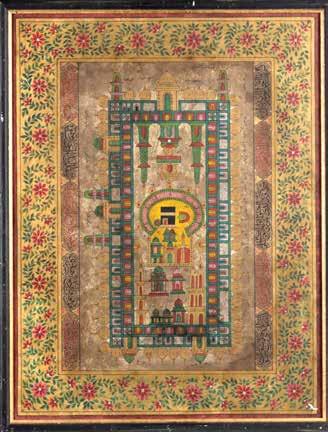
Estimate € 1500 - € 2000
Lot 181
A RARE SWISS CRYSTAL CLOCK
LATE 19TH CENTURY
Crystal Ball desk top clock, circa 1890. Convex cut glass to the front and back each opening. Visible platform escapement movement to the back. Brass fittings.
A rare and unusual piece.
Diameter: 6.5 cm.
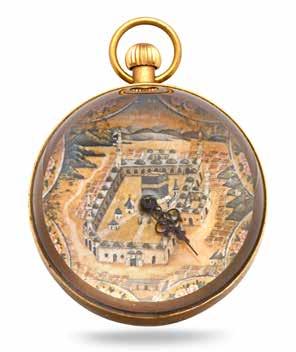
Height: 6 cm.
Estimate € 2000 - € 3000

The lower cubic section surmounted by canopy in the form of a pyramid, one side with opening, of red and green silk profusely embroidered with silver and gilt-silver thread to each side of the lower section with a large cartouche surrounded by vines and floral sprays, above inscription-filled panels, the border with a band of interlocking palmette motifs; the upper section to one side with cartouches containing tughra and inscriptions, above further inscription filled cartouche, surrounded by vines and floral interlace, the borders with interlocking palmette motifs, with four loose panels embroidered with two bands of inscription. This mahmal tent bore a silver sphere atop of each of the four fascades. In the bands around the lower section in gold wires on green, the Quran 2, surah Al-Baqarah, verse 255 in large thuluth script.
Cartouches of the upper section enclosing the tughra of Mamud II with v.56 of surah Al-Ahzab. 280 by 135 by 150 cm.
The most noticeable differences between this Mahmal and these from the the Egyptian ones, are their composition and embroidery. This Mahmal is more embellished and striking. while the preferred color of the earlier Mahmals was black, the later preference was for green. Originally commissioned by Sultan Mahmud II, the 30th Sultan of the Ottoman Empire from 1808 until his death in 1839.
The Mahmal is adorned with fine handcrafted and embroidered decoration made with heavy and elegant silver and gold thread calligraphy backed with red, green, and yellow silk. The Mahmal is a ceremonial palanquin which accompanied the pilgrim caravan on route to Mecca during the Hajj. Produced each year, or sometimes reused like the present lot, it represented the authority of the Sultan over the holy places. It was mounted on the back of a camel, forming a symbolic centrepiece for the pilgrims, and housed a copy of the Quran. The first mahmal was sent by the Mamluk Sultan from Egypt in 1266 AD. A later description by the fifteenth century encyclopaedist al-Qaqashandi describes ‘a tent made of embroidered yellow silk and topped by a spherical finial’, and the earliest surviving example in the Topkapi Palace commissioned by Sultan al-Ghawri (d.1516) is also yellow, the dynastic colour of the Mamluks. Later Ottoman examples, such as one in the Khalili Collection dated to c.1867-76, adopt the same colour scheme of red and green as the present lot. (Venetia Porter (ed.), Hajj, journey to the heart of Islam, British Museum exhibition catalogue, London, 2012, pp. 140-141).
Following the Hajj the mahmal was brought back to Cairo by the returning caravan, and the camel which had carried it to Mecca was rewarded for its hardship by being excused from labour for the rest of its life.

Lot 183

A brass tray of rectangular form, profusely inlaid, the central field depicting the Mahmal procession, the border containing cartouches enclosing inscriptions in thuluth script of Ayat Al-Kursi v. 255 from surah Al-Baqaraa with interspersed roundels containing bands enclosing kalimaat al-awhid.
The tray is decorated with a scene representing the procession of the mahmal, most probably after leaving Damascus as it is clear that the caravan is accompanied by Bedouin tribes for their good knowledge of the desert routes and protection against thugs and other tribes.The mahmal is borne by a richly caparisoned camel. It is preceded by an official holding a flag bearing the Ottoman star-and-crescent motif, and followed by another riding a similarly caparisoned camel and carrying a banner (bayraq). Behind him is a group of religious figures wearing distinctive hats. Around them are groups of soldiers riding camels or on horseback, three musicians and some pilgrims, as well as spectators and well-wishers. In the back ground is Amir al-hajj “commander of the pilgrimage” with other officials. 74 by 54 cm.
The mahmal was the ceremonial palanquin carried on a camel, which was the centre of the pilgrim caravan, and was the symbol of authority of the sultan over the holy places. Its origins are uncertain: it might hark back to the tradition of a palanquin carrying a high-ranking female accompanying military campaigns for encouragement, a role the Prophet’s wife was said to have had. The first sultan known to send the mahmal was Baybars (AD 1260-77). Following the Ottoman conquest of Egypt in 1517, the Ottomans also sent a mahmal from Damascus, as did the Yemenis on occasion. After the pilgrimage, the mahmal did not stay in Mecca, but was taken back to Cairo.
Estimate € 6000 - € 8000
Lot 184
A fragment of the inner curtain of sacred kiswa for the inner wall of the Kabaa with an inscribed weave in cream-colored and gilt silk over a black ground. The crests of the chevrons are embellished with lamp motifs with circular medallions in between. Embellished with a group of three undulating bands which assume the form of a continuous chain made up of number ‘7’s. The bands run from the beginning to the end of the cloth. The central band with prominent Inscription of ‘Kalimaat al-Tawhid, There is no God but Allah and Muhammad is his Prophet’, repeating in the middle of the kiswa between the two zigzag bands. The two expressions, ‘Ya Mannan’ (O, the All-Bounteous) inside the upright lantern, and ‘Ya Hannan’ (O, the Most-Compassionate) inside the reversed lantern are also repeated with ‘Praise be to Allah’ (O, The All-sovereign) inside the circles. On the upper undulating band, there is a verse from the Quran surah Al-Ahzab v-56. The lower undulating band encloses another inscription of ‘prayers for the four righteous caliphs Abu Bakr, ‘Umar, ‘Uthman and ‘Ali as well as for the companions of the Prophet. 94 by 22 cm.
Estimate € 1200 - € 1500
Lot 185
19TH CENTURY
Rectangular in shape, two dark green velvet panels stitched together, each side is heavily decorated with a thread of gold-plated and silver-plated lush decorations surrounding inscription in thuluth script of Quran 4 surah An-Nisa, verse 58 with the name of the Ottoman Sultan Mahmud II (r.1809-1839).
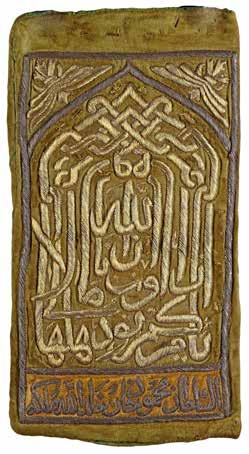

46 by 25.5 cm.
Estimate € 2000 - € 3000
Lot 186
KHARITAT AL-AJAIB WA FARIDAT AL-GHARAIB, ‘THE PEARL OF WONDERS AND UNIQUENESS OF STRANGE THINGS’ BY IBN AL-WARDI, DATED 1212 AH/1797 AD
Arabic manuscript on paper, 160 folios with 4 fly-folios and 19 lines to each page, written in black naskh script, titles and important words in red ink. Four paintings, gouache color heightened with gold, different ownership statements and seals, with a brown morocco leather binding, with ownership statements and seals.
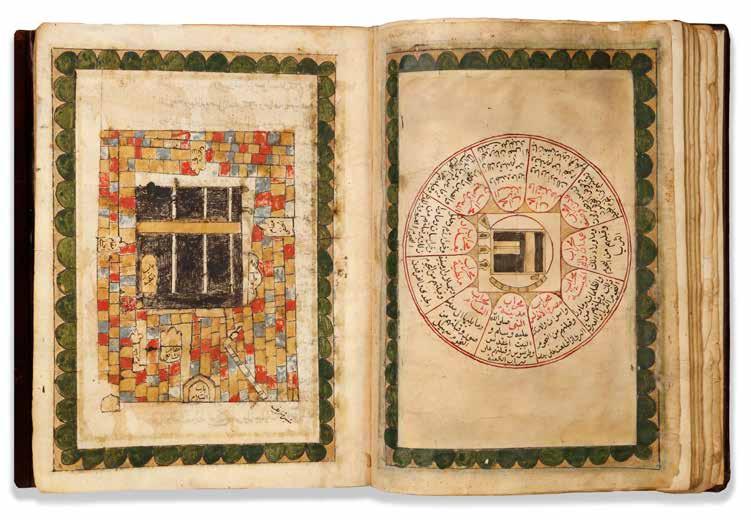
15 by 23 cm.
Estimate € 10.000 - € 15.000
The book contains many chapters about geography and important places.The author summed up the geographical knowledge of the Arabic world of the time, referring to climate, terrain, fauna and flora, population, way of living, existing states and their governments in individual regions of the world. The work was accompanied by a colored world map and three illustrations of the Kaaba, in Al-Masij Al-Ha- ram surrounded by maqams and minaretes, the introduction about the distances, the earth and its divisions. Chapters mentioning countries, regions, seas. A chapter about Algeria and antiquities. A chapter about famous rivers, wells, and mountains. A chapter of the properties of stones and their benefits, minerals and gems and their properties. A chapter about plants ,fruits, grains, seed and their properties. A chapter about animals and birds and their properties. The conclusion of the book menti- ons the epics, the signs of yawm al-qyamah or the day of resurrection.

The author: Siraj al-din Abu Hafs Omar bin al-muzaffar bin al-Wardi who died in (852AH-1447AD). Ibn al-Wardi ,the grandson, was an agricultural scientist and geographer, wrote many books including this book, “Benefits of plants” and “Obligations and Benefits”.This book is mistakenly attributed to his grandfather but it was written in (822AH/1419AD) 71 year after the death of the grandfather.
The author
Siraj al-din Abu Hafs Omar bin al-muzaffar bin al-Wardi who died in 852 AH/1447 AD.
Ibn al-Wardi, the grandson, was an agricultural scientist and geographer, wrote many books including this book, ‘Benefits of plants’ and ‘Obligations and Benefits’. This book is mistakenly attributed to his grandfather but it was written in 822 AH/1419 AD 71 year after the death of the grandfather.
An illustrated folio from a Khamsa of Nizami, opaque pigments heightened with gold on paper, Majnun opens the door of the Kaaba surrounded by a crowd, four columns of text in nastaliq script above an below within gold rules, the text to the reverse laid out in rectangular text panels. 34 by 22 cm.

After being banned from seeing his childhood love Layla, Qays ibn al-Mulawwah’s obsessiveness drives him mad and makes him run away into the wilderness. His tribe gives him the epithet of Majnun (crazy). The scene of our jewel-like illustrated folio depicts Majnun’s father’s attempt to cure him, by taking him on pilgrimage to Mecca, to seek God’s help in freeing him. However, Majnun strikes the Kaaba and cries and demands to be allowed to love. He continues to wander in the wilderness, chanting poems about Layla’s love and beauty.
Estimate € 2000 - € 3000
Lot 188

A case, the frame painted in gold, decorated with a crescent moon and star in the center, opening in two parts. The inside of the cover painted with a central medallion representing aerial view of the al-Masdjid al-Harām mosque in Mecca, surrounded by a polychrome decoration of flowers and foliage on an ocher background. The inside of the box with a compass and compass rose in twelve directions, divided into degrees, with painted medallion view of the Al-Aqsa Mosque. This instrument, with the direction of the qibla positioned directly straight south, was made exclusively for Medina. To use it, orientate it by making the needle coincide with the northern minaret, then turn the box until the needle aligns with the direction of the qibla. The instrument can also be used to determine the true noon indicated when the string matches its own shadow on the meridian. At this time it also indicates true south, and therefore the direction of Mecca.With miniatures representing the sacred sites of Mecca.
Painted wood, brass hinges and closure.
26.3 cm by 17.9 cm.
Estimate € 6000 - € 8000
Lot 189
AN UNUSUAL KUTAHYA POTTERY PANEL DEPICTING A HAJJ MAP OF MECCA AND MEDINA, 19TH-EARLY 20TH CENTURY
The rectangular panel with 24 tiles, depicting the sites of Mecca and Medina, the location names inscribed in Naskh script in black ink, the panels bordered with scrolls throughout. 150 by 100 cm.
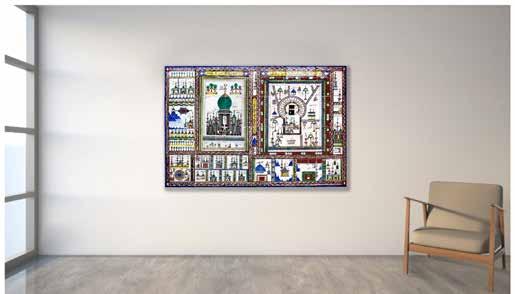
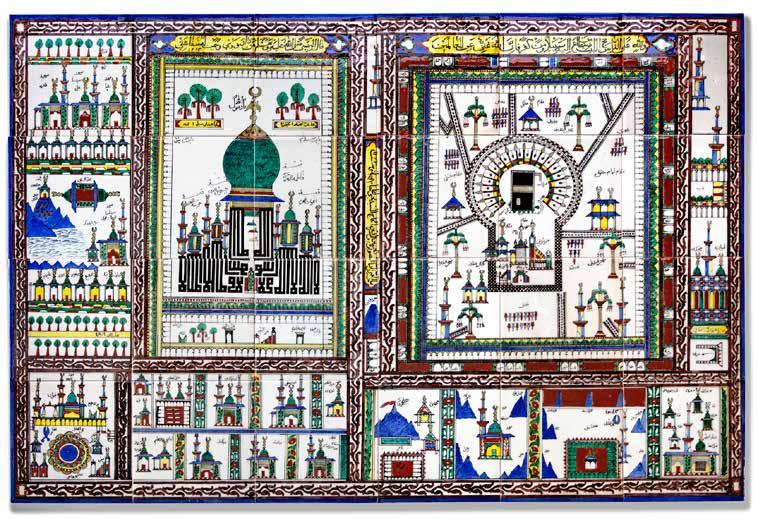
24 tiles
Estimate € 6000 - € 8000
Lot 190
A fragment of the inner curtain of sacred kiswa for the inner wall of the Kaaba with an inscribed weave in cream-colored and gilt silk over a red ground. The crests of the chevrons are embellished with lamp motifs with circular medallions in between. Embellished with a group of three undulating bands which assume the form of a continuous chain made up of number ‘7’s. The bands run from the beginning to the end of the cloth. The central band with prominent Inscription of ‘Kalimaat al-Tawhid, There is no God but Allah and Muhammad is his Prophet’, repeating in the middle of the kiswa between the two zigzag bands. The two expressions, ‘Ya Mannan’ (O, the All-Bounteous) inside the upright lantern, and ‘Ya Hannan’ (O, the Most-Compassionate) inside the reversed lantern are also repeated with ‘Praise be to Allah’ (O, The All-sovereign) inside the circles. On the upper undulating band, there is a verse from the Quran surah Al-Ahzab v-56. The lower undulating band encloses another inscription of ‘prayers for the four righteous caliphs Abu Bakr, ‘Umar, ‘Uthman and ‘Ali as well as for the companions of the Prophet.

Estimate € 1200 - € 1500
Lot 191

An illustrated folio from a Khamsa of Nizami, opaque pigments heightened with gold on paper, Majnun opens the door of a maqam surrounded by a crowd, four columns of text in nastaliq script above and below within gold rules. All ruled in gold and polychrome borders. 23 by 15.5 cm. Text: 16 by 10 cm.
Estimate € 2000 - € 3000
A large Ottoman silk, velvet and metal thread calligraphic band from the holy Kaaba (Hizam), of rectangular form embroidered with silver metal wires. To the centre a large silver cartouche with rounded ends enclosing in silver wires the basmallah and v.125 from surah Al-Baqarah in thuluth script with a band of meandering leafy silver vine above and below. Further flanked to the right side with a circular silver panel enclosing in silver wires surah Al-Ikhlas surrounding four words of ‘Allah’ on a green silk ground. 90 by 665 cm.

The four walls of the Kaaba are covered with a curtain (Kiswa) with the Shahada outlined in the weave. About two thirds of the way up runs a gold embroidered band (hizam) covered with Quranic verses. Each year, when the new Kiswa arrives the guardians of the Kaaba, the Banu Shayban, divide the old Kiswa up and distribute the pieces to honoured pilgrims. Entire surahs were apparently reserved for important dignitaries or rulers
Estimate € 20.000 - € 40.000
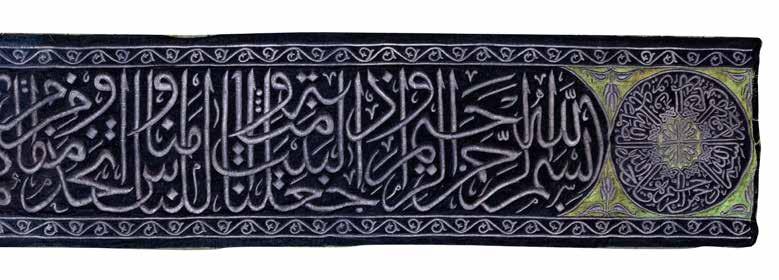
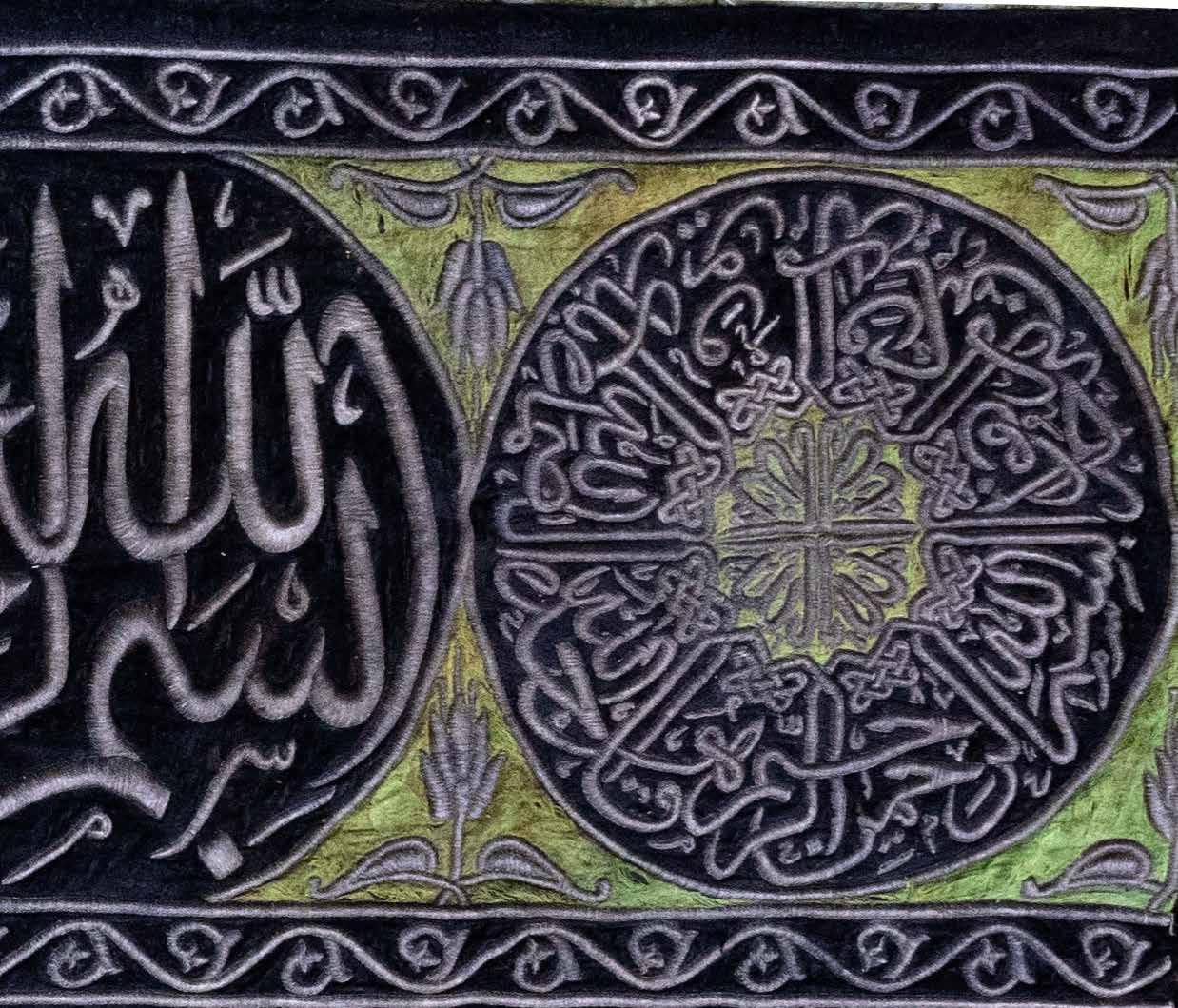

Constantinople, 1178 AH/1765 AD (dated above the frame)
Case overall 84.8 by 40.5 cm.
Qibla finder comprising a rectangular wooden panel with two printed roundels, the upper one with a depiction of the Haram al-Sharif in Mecca and a description by the inventor of the instrument, the lower roundel with a depiction of a map of the world signed in a cartouche by Abdulwahab Siddiki, thereunder a series of tables listing the cities and places of the world. The description mentions al-Bārūn al-Mukhtari as the inventor and is dated 1151 AH/1738-9 AD.
This qibla finder map in a wooden frame, dated 1764/65 AD, is modeled after the original series of Qiblafinders, invented and made by Baronyan (Bārūn al-Mukhtari’) some 30 years earlier.
Baronyan, the original inventor of these instruments created this genre of qibla indicators for the Ottoman Grand Vizier, Yegen Mehmet Pasha in 1738/39 AD. These prints were first mounted in a circular box form and later in a wooden frame, as is the case in our object.
At the center of the upper part of the panel there is an Ottoman inscription, where the date is given as 1178 AH, which corresponds to 1764/65 AD which is the last year that Baronyan was in life. A very similar panel was sold in 2002 in Bonhams with the same date of 1178 AH given on top of the frame.
“Māšā Allāh (God has willed it)!
I am such a treasure of a Qibla-numa
I am the beginning of the thing/picture which decorates the world”
In the year 1178 [1764/1765]
Estimate € 12.000 - € 15.000
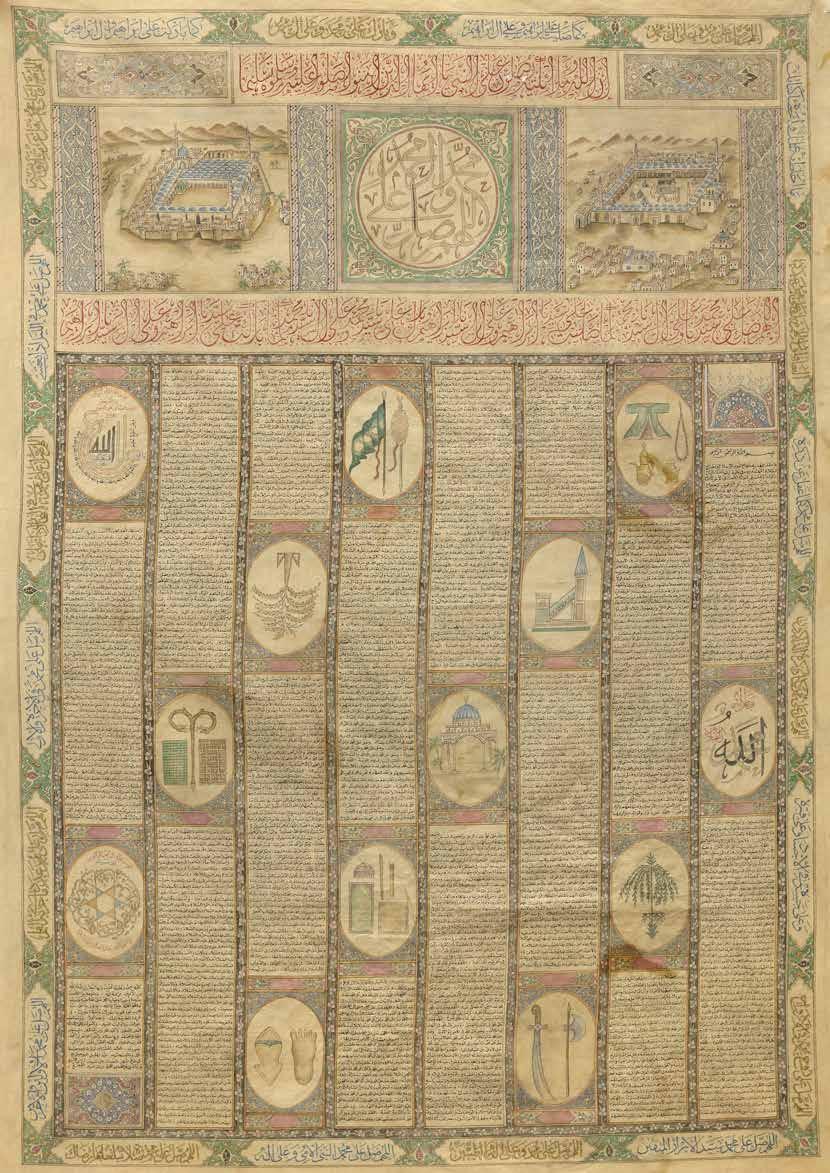
Cotton covered with text written in a variety of scripts and floral design, including thuluth, naskh scripts, in assorted colors, in numerous panels, roundels, cartouches and lines.
At the top a square enclosing prayers in large gold thluth script flanked ob both sides by two detailed illustrations Mecca and Medina with Al-Masjid AL-Haram and Al-Masjid AL-Nabawi, all surrounded by rectangles and sqaures containing prayers in polychrome ink and floral eay sprays. 8 arranged colums enclosing drawings and Arabic manuscript from Dalai’l Al-khayrat (different prayers and Dua’a), with different drawings of of the Names of the Lord of the Worlds, a detailed views of al-Rawda al-Sharifa, Alam or flag of the prophet, Mihraab of the Prophet Muhammad, Tuba tree, different items used by the prophet including his sharif shirt and sandals and staff of Moses.
Signed ‘Written by al-fakir Abdul-Jalil Al-Busiri on Shabaan 1218AH. 120 by 86 cm.
Dalai’l Al-khayrat is a famous collection of prayers for the Islamic prophet Muhammad, which was written by the Moroccan Shadhili Sufi and Islamic scholar Muhammad Sulaiman al-Jazuli ash Shadhili (died 1465). It is popular in parts of the Islamic world amongst traditional Muslims - specifically North Africa, the Levant, Turkey, the Caucasus and the South Asia.
Estimate € 4000 - € 6000
Lot 195
DATED 1321 AH/1903 AD
Watercolor heightened with gold on wood, depicting al-Masjid al-Haram central in Mecca with another mosque in the background. Ruled by an openwork wooden frame containing the front side of Süleymaniye Mosque.

Painting: 16 by 8.5 cm. With frame: 36 by 25 cm.
Estimate € 1500 - € 2000
A large Ottoman silk, velvet and metal thread calligraphic band from the holy Kaaba (Hizam), of rectangular form embroidered with silver metal wires. To the centre a large silver cartouche with rounded ends enclosing in silver wires the basmallah and v.125 from surah Al-Baqarah in thuluth script with a band of meandering leafy silver vine above and below. 90 by 625 cm.

This hizam (belt) is of the type that would have been placed at about two-thirds of the height of the exterior of the Kaaba over the kiswa. They were typically divided into seven sections - the content of these on the more recent coverings is almost entirely Quranic, and examples of kiswa fragments that have previously appeared at auction testify to this. During the Ottoman period, however, the purpose of the inscription on the hizam, which was really the single most visible element of the kiswa, became also to glorify the Sultan, who as Caliph was accorded such an honour. A number of similar hizams are in public and private collections. One, attributed to 19th century Cairo, is in the Khalili Collection (Abu Dhabi, 2008, pp.338-339, no.402). Another is in the Topkapi Saray Museum (T.S.M.24/11; Bayhan, 2008, pp.182-189). Others have appeared on the art market. One, for example, sold at Christie’s, London, 17 April 2007, lot 19.
Estimate € 20.000 - € 30.000


A fragment of silk hanging panel of the inner kiswa of al-Rawda al-Sharifa, with an inscribed weave in cream color over a light sky-blue ground. Embellished with a prominent inscription within a broad border in thuluth script of praise of the prophet ‘Prayer and peace be upon you, O Messenger of Allah’. Below with a narrow band containing prayers for the four righteous caliphs Abu Bakr, ‘Umar, ‘Uthman and ‘Ali as well as for the companions of the Prophet. At the top with a narrow band enclosing ‘O Allah, bless the Prophet Muhammad, the Seal of Prophets and Messengers’.
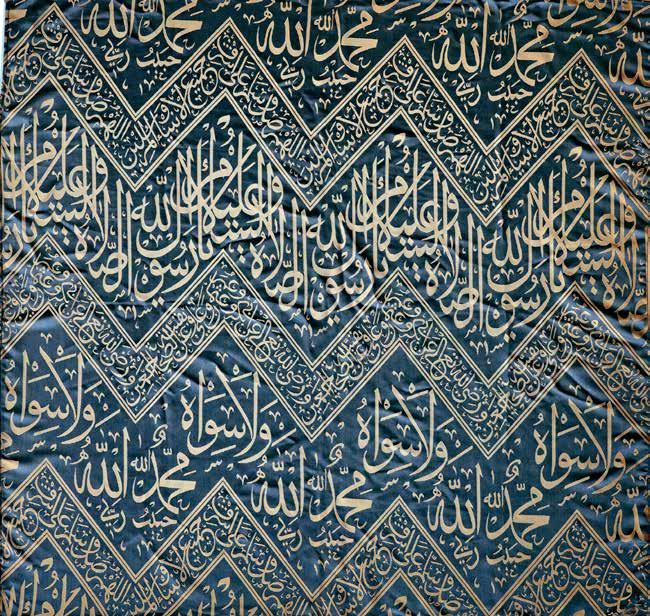
136 by 141 cm.
Estimate € 3000 - € 5000
AN OTTOMAN TALISMANIC CHART WITH EXTRACTS FROM THE QURAN AND PRAYERS, 20TH CENTURY
Cotton covered with text written in a variety of scripts and floral design, including thuluth and small square Kufic, in assorted colors, in numerous panels, roundels, cartouches and lines.

To the centre a large vieuw of Mecca with al-Masjid al-Haram with surah Al-Nasr at the top, surrounded by Dua’a al-Talbiyah in Kufic script. Further borderd by a band containing cartouches and squares with verse from the Quran an prayers.
The inscriptions of this band includes: Dua’a or prayer at first sight of Kaaba, prayer when hearing the Azaan, prayer about the sadness and the worries, prayer for drinking Zamzam water, Dua’a al-Tawaf, Dua’a when entering the prophet’s grave. Alternating with squares of Quran verses and Kalimaat al-Tawhid in Kufic brown script. The outer two large bands contains: surah Al-Baqarah v.158-v.203, surah Al-Imraan v.96-v.97, Surah Al-Hajj v.26-27 in naskh and thuluth script.
110 by 88 cm.
Estimate € 2000- € 3000

EARLY 20TH CENTURY
Four rare photographs, including of Mecca with prayers around the Kaaba.
Early 20th century
18 by 13 cm.
Estimate € 1000 - € 1400
1880-1890
Two early photographs of Mecca by Alsayyid Abd Al-Ghaffar Al-Tabib, both photograps depicts a general view of the Kabaa with the city beyond.

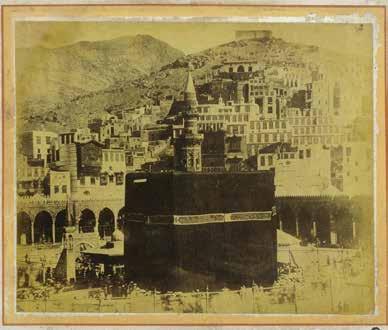
‘Abd al-Ghaffar is credited with being the earliest Arabian photographer. He was reputed to have learned the art of photography from the Dutch orientalist Christian Snouck Hurgronje who stayed with the physician in Mecca in 1884-85.
30 by 25 cm.
30 by 22 cm.
Estimate € 1200 - € 1500

These four photos show the Garden of Fatimah in the Prophet Mohammed Mosque, Al-Arabia Gate (One of Madina gates) with its market. Also, the Ottoman railway station building.Finely, a side of the pilgrims’ tents at Arafat.


29 by 20 cm.
14 by 11 cm.
Estimate € 800 - € 1200
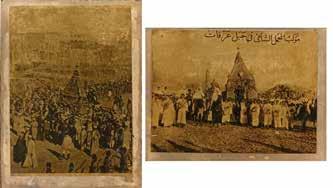

EARLY 20TH CENTURY
Two old photographs of the Syrian (Sham) and the Egyptian Mahmal. A Mahmal is a ceremonial passenger-less litter that was carried on a camel among caravans of pilgrims on the Hajj.
Early 20th century
18 by 13 cm.
Estimate € 800 - € 1200
Lot 203
Seven photographs of Mecca, Medina, the Mahmal and Hajj.
Rare photographs, including images of Mecca with prayers around the Kaaba, the Mahmal with pilgrims, the arrival of the mahmal, and prayers at the Prophet’s mosque.
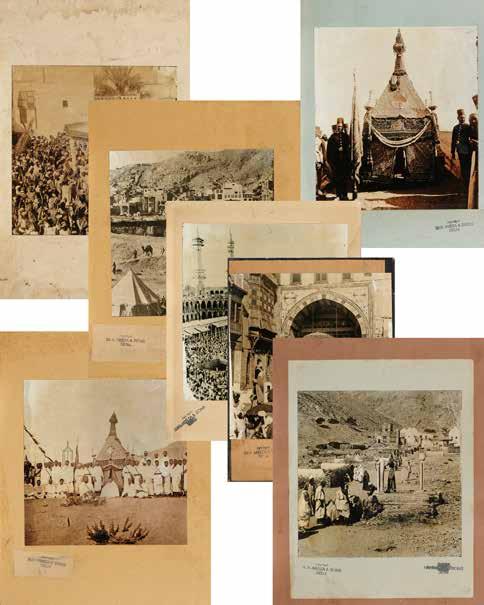
Approximately: 20 by 20 cm.
Estimate € 2000 - € 3000
Lot 204
A COLLECTION OF SEVEN OLD PHOTOGRAPHS OF MECCA, MUNA AND THE HAJJ, EARLY 20TH CENTURY
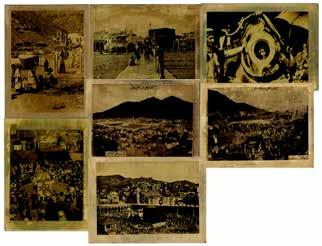
Image of vast crowds of pilgrims in the square and cloisters of al-Masjid al-Haram with house of Mecca in the background, pilgrims’ tents at Muna, a view people visiting Al-Baqi Cemetery, prayers around the Kaaba with al-Salam gate, a close picture of al-Jajaru al-Aswad or Black Stone located in the eastern corner, Ramy al-jamarathe or Stoning of the Devil during the Hajj.
Approximately: 13 by 18 cm.
Estimate € 2000 - € 3000
Lot 205
A COLLECTION OF SEVEN OLD PHOTOGRAPHS OF MECCA, MEDINA, THE MAHMAL AND THE HAJJ EARLY 20TH CENTURY
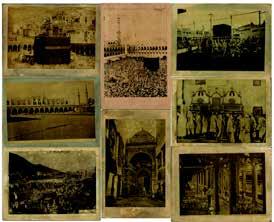

Image of Mecca with prayers around the Kaaba, image of a bedouin caravan, two pictures of the pilgrim’s tents at Muna, a view of Al-Baqi Cemetery, prayers going through al-Salam gate, a view of the city of Medina and the Prophet’s mosque, a view of al-Masjid al-Nabawi with its prominent green dome.
Approximately: 12 by 18 cm
Estimate € 1500 - € 2000
Lot 206
A COLLECTION OF EIGHT OLD PHOTOGRAPHS OF MECCA, MEDINA AND THE HAJJ, EARLY 20TH CENTURY
Images of Mecca with prayers around the Kaaba, an inside view of al-Masjid al-Nabawi, a view of Mecca with the kaaba in the foreground.
Approximately: 13 by 18 cm.
Estimate € 2000 - € 3000
Lot 207
Two images of vast crowds of prayers around the Kaaba in Mecca, image of an Ottoman caravan during the procession of the mahmal, picture of the pilgrim’s tents at Muna, two pictures of the view of al-Masjid al-Nabawi with its prominent green dome and Al-Baqi cemetery.
Approximately: 12.5 by 18 cm
Estimate € 1500 - € 2000
Lot 208
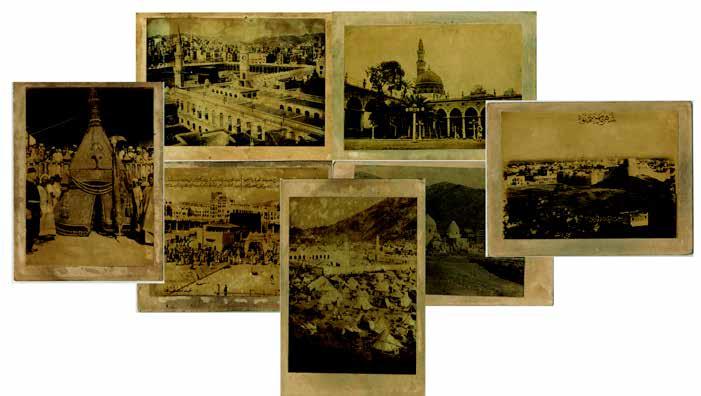

THE MAHMAL AND THE HAJJ, EARLY 20TH CENTURY
Images of Mecca with prayers around the Kaaba with al-Salam gate, arrival of the Mahmal at Mecca, pilgrims’ tents at Muna, a view of the city of Medina and the Prophet’s mosque, a close view of al-Masjid al-Nabawi with its prominent green dome, a view of Mecca with al-Kaaba in the centre, a view of Al-Baqi Cemetery.
Approximately: 13 by 18 cm
Estimate € 2000 - € 3000
A PHOTO ALBUM WITH A COLLECTION OF 95 PHOTOS OF MECCA, MEDINA THE MAHMAL AND THE HAJJ, EARLY 20TH CENTURY

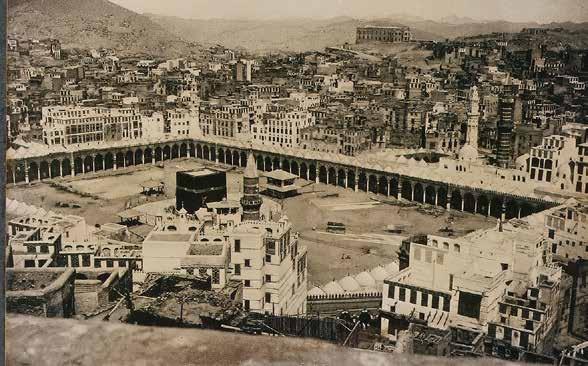
95 Photos including images of the Mahmal with pilgrims, the arrival of the Mahmal, during the Hajj travel to Mecca and Images of Mecca with prayers around the Kaaba, the Mahmal with pilgrims, pilgrims’ tents at Arafat, the Ak-Khayf mosque at Mina, and views of the city of Medina and the Prophet’s mosque.
15 by 12 cm.
12 by 10 cm.
Estimate € 15.000 - € 20.000
A LARGE MOULD-BLOWN BLUE GLASS BOTTLE-VASE OR SPRINKLER, PERSIA 12TH CENTURY

With compressed mould-blown globular body, the base with a moulded five-petalled flower head, the freeblown upper section with coiled trail.
Height: 28 cm.
Estimate € 4000 - € 60000
Lot 211

This alluring glass jug is a fine example of Islamic glass making from the early Medieval Islamic Period. Glass making production after the fall of the Roman Empire fell in to decline across the Near East, except for in the areas of modern day Egypt, Syria and Iraq, where its traditions continued, being passed on to Medieval craftsmen. As furnace technology improved, allowing wider variety of production, many new styles evolved, and the early Medieval Period between the 8th and the 12th centuries produced some of the most unique and playful glass from the across of Islamic world, little of which unfortunately survives due to its fragile nature.
This fine example consists of a rounded body, made using the dip-moulding technique where a parison of molten glass is be dipped in to a mould then tooled, blown or manipulated against the edges in to various forms . It exhibits a characteristic softly moulded pattern of raised, rolling lines across the body of the glass that radiate from the upper body in irregular curves, adding an element of decoration. This effect is achievable through the dip-mould technique and adds a sense of dynamism to the jug, making it appear almost organic, whilst the rich colour was probably achieved with the addition of Manganese inclusions during the melting process . The narrow neck, with a single ridged detail tapers to a drop-shaped spout with a slightly inverted rim that sits above a beautiful section of detailing around the neck of an undulating trail design of thick glass. A separately moulded glass handle applied when the body was still hot also exhibits and elegant trail motif at the upper end.
Height: 15 cm.
Estimate € 2000 - € 3000

Transparent bluish glass
This mold-blown vessel has a globular shape, with a flattened, slightly hollow shoulder. The cylindrical neck is provided with a thick mouth. The disk-shaped base gives the bottle stability, but shows a strongly concave pontil mark (a pontil mark is a sort of scar left on the base of a bottle by the rod that holds the container during the blowing process).
The decoration combines both molding and blowing techniques: the parison (mass of molten glass) was first poured into a mold adorned with vertical ribs, and was then blown. The counterclockwise spiral incisions were obtained by slightly rotating the bottle. Finally, the vessel was placed back into the same mold, so as to form the final criss-cross pattern with a myriad of small granules in relief. This beautiful vessel, embellished by its bluish color and elaborate decoration, belongs to a class of bottles that generally come from the central or eastern Iranian world. They exist in various sizes, globular or cylindrical, with a complex or more linear pattern: our example is remarkable for its sturdiness and its size, certainly above average. Such bottles would have been used for the storing and transport of liquids, as also attested by their rather robust appearance. Chronologically, they can be dated to the Islamic period, between the 10th and the 11th century A.D. Complete and in very good condition, despite minor cracks on the body. Surface partially worn and covered with patina.
Height: 13 cm.
Diameter: 11.7 cm.
PROVENANCE
Private collection, Switzerland.
CARBONI S., Glass from Islamic Lands, New York, 2001, pp. 206-207, nos. 51a-c. GOLDSTEIN S.M. et al., Glass, From Sasanian antecedents to European Imitation, The Nasser D. Khalili Collection of Islamic Art, London, 2005, nos. 111-114, pp. 100-103 et 333.
Estimate € 5000 - € 8000
A FATIMID GLASS BOWL, PROBABLY EGYPT, 9TH-10TH CENTURY

A Fatimid glass bowl with compressed body and short straight rim, decorated with a band of inscriptions between two bands of stiff leaves.
Inscriptions: in angular Kufic script of “
Allah is free from imperfection, all praise is due to Allah and Allahu Akbar”.
Height: 7 cm
Diameter: approximately 11 cm
Estimate € 3000 - € 5000

10TH-12TH CENTURY
A glass ewer standing on a small splayed footring created by folding the glass inward. The mark of a pontil can be seen on its base, affirming its use during the tooling process. The opening of the neck was also tooled to receive a pointed spout. A round handle was attached to the cylindrical tapering neck by a thick blob of glass, then pulled upwards and attached to the rim. An unusual thumbrest was tooled with a pincer instrument, decorated around the body in low relief with floral leafy sprays and ribs around the neck.
Height: 19 cm.
Estimate € 4000 - € 6000
A FATIMID GLASS PARFUM BOTTLE, EGYPT OR SYRIA, 10TH-11TH CENTURY
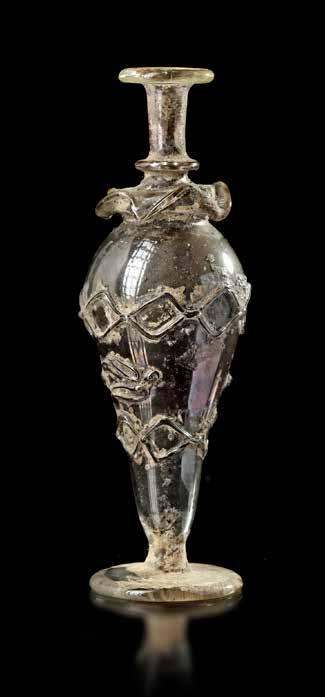
A glass tooled bottle, standing on a slightly spreading foot, with pear shaped body, ribbed neck and everted rim, applied around the shoulder a waved ring, around the body a tooled bird applied between two bands.
Height: 12 cm.
Estimate € 1000 - € 1400
AN EARLY ISLAMIC GLASS FLASK NEAR EAST, CIRCA 8TH-10TH CENTURY

Into two parts with yellow-green tinge, and applied roundels. Intact.
Height: 9 cm.
Estimate € 600 - € 800
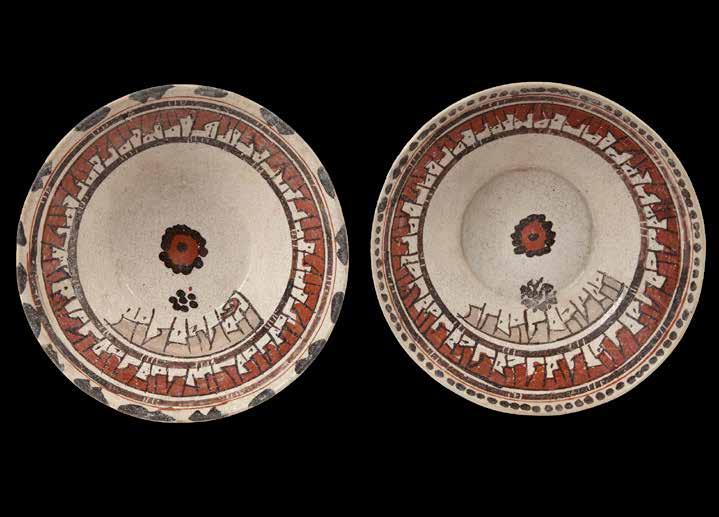
With flaring sides, decorated in manganese-brown and red on a cream ground with a band of Kufic inscription around the sides, one side with a further band of inscription, the rosette in the middle, the rim with a dotted border.
Diameter: 19.1 cm. (2)
Height: 7 cm.
Estimate € 1200 - € 1500
FOUR OTTOMAN SILVER INCENSE BURNERS, TURKEY, 19TH CENTURY

Three silver censers with typical shape and spray shaped handle, engraved with flower heads amongst foliage .
Height: 17-19 cm.
A silver fruit shaped censer
Weight: 600 gr.
Estimate € 1200 - € 1500
Lot 219
A KASHAN MOULDED BOTTLE VASE, PERSIA, 12TH CENTURY

The frit body of baluster form with a compressed globular base resting on a short foot, the narrow tapering neck joined to a wide flaring fluted mouth of tulip form, decorated with a moulded calligraphic design on the curving shoulder with splashes in cobalt blue.
Inscriptions: al-Izz wa al-Iqbal wa al-hana li sahibh “Blessing and Good-Fortune and Joy for its owner” .
Height: 23.5 cm.
Estimate € 2000 - € 3000
Lot 220
A KASHAN POTTERY KASHKUL, PERSIA, CIRCA 13TH CENTURY
Of squat rounded form on short foot, the decoration follows a precise pattern, running from the base of the body to the rim. It is made up of alternating vertical stripes in different colours (black and cobalt blue).

Height: 12 cm.
Diameter: 17.5 cm.
PROVENANCE
Private collection, Switzerland.
Sotheby’s, 26th April 1996, lot 49
Estimate € 10.000 - € 15.000
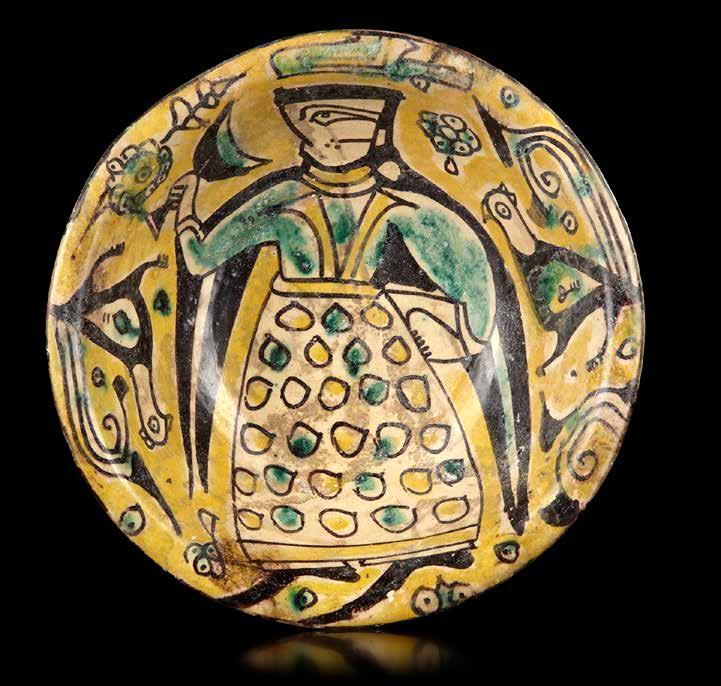
The bowl, hemispherical and low in shape, is supported by a circular base, slightly concave. The wall flares upwards and ends in a rounded edge. The buff colored clay is coated with a cream slip and transparent glaze, visible over the entire surface of the container. Polychromy includes black, used mainly for the outlines, the yellow for the background and the green for many details of the scene. Inside the cup is a standing female figure, seen from the front but with the head and the painted legs in profile; her face is rendered in a somewhat peculiar way, with the eye in almond shape and a somewhat sketchy profile. She wears a long-sleeved green tunic, a full skirt with green and yellow weights and black ankle boots with a white edge. A big black shawl covers her head like a veil and goes down along the arms before ending in point, almost at the height of the feet. The woman is holding a chalice, of which she is about to drink.
Estimate € 4000 - € 6000
The scene is completed by two birds (these are probably peacocks with their tails majestic) represented head to tail on one side and the other of the woman, by motifs plants (flowers and bushes) and, above the head of the figure, by an abstract motif, which could be a simplification of the Kufic word baraka (“hello”). The outside of the cup is decorated only with vertical spearhead motifs. Typologically, the cut belongs to the buffware (according to the Anglo-Saxon terminology, indicated by C.K. Wilkinson), which flourished in the region of Nichapour (in present-day Khorassan, northeast Iran) between the 9th and 10th centuries CE. The style, generally rather naive, is characterized above all by a horror vacui which pushes the painters to fill the available surface with a large quantity of decorations; figures and the patterns are never realistically painted and their assembly or arrangement do not meet narrative criteria. If the repertoire of shapes (cuts and dishes are largely dominant), the color palette (sometimes details are painted in red-brown) and the stylistic rendering are a bit monotonous, the choice of painted subjects presents many variations: alongside a wide fauna composed of birds, fish and quadrupeds (ibex, horses, felines, canids), there is also a series of scenes with human characters, often a bit stereotyped (hunters, riders, banquet scenes, musicians, round dances, etc.).
This cup has an excellent parallel kept in the Islamic Museum of Tehran, which reproduces a woman in the same attitude, drinking from a chalice, and surrounded by similar birds. Complete and in very good condition, but reattached from numerous fragments; minimal fillings. Glaze and paint well preserved.
Diameter : 18.7 cm.
Private collection, Switzerland. Formerly Japanese collection, collected in the 1980-90s.
PANCAROGLU O., Perpetual Glory, Medieval Islamic Ceramics from the H. B. Plotnick , Collection, Chicago, 2007, pp. 80-83, nos. 38-42. SEIPEL W. (Ed.), 7000 years of Persian art, Masterpieces of Mus. Nat. from Tehran, Milan –Vienna, 2002, pp. 312-317, nos. 170 (Tehran, Mus. Isl.), 171, 172. WATSON O., Ceramics from Islamic Lands, Kuwait Nat. Mus., The Al-Sabah Collection, London, 2004, pp. 246 ff., nos. H1-H6.
WILKINSON C.K., Nishapur, Pottery of the Early Islamic Period, New York, 1973, pp. 17,ff., nos. 59-62
Lot 222

PERSIA OR IRAQ, 7TH-8TH CENTURY
The egg-shaped jar, is covered entirely with a blue-greenglaze, which is common in Sassanid ceramic production. The decoration moulded, applied and stamped with incised detailing, the body with a band of alternating panels containing crosses and cable design with applied and stamped floral motifs, above and below a band of applied bosses in the form of flower heads, the shoulder with a band of foliate motifs arranged in a zig-zag pattern on a ground of incised dots, the neck with a frieze of moulded palmette motifs The shape, decoration and technique used in the piece are evidence of the stylistic continuity between the late Sassanid and the early Islamic periods. The jar was probably intended to store foodstuffs. The shape and decoration of the jar, the technique used and the dark green glaze are all typical of Sassanid ceramics. Height: 50 cm.
PROVENANCE
Estimate € 8000 - € 12.000
Lot 223
A FINE RAQQA TURQUOISE GLAZED POTTERY TILE, SYRIA, LATE 12TH CENTURY
A pottery tile moulded and decorated with a rich vivid opalescent turquoise alkaline glaze, decorated in high relief with the word ‘Allah’ , the letter ‘ Lam’ moulded as a trilobed palmette within raised line borders. 26.4 by 23 by 3.5 cm.

So-called Raqqa ware - which, over time, has come to refer to a wide range of pottery, including certain kinds of lustreware, underglaze painted wares, monochrome-glazed wares, and Laqabi and “Tell Minis” wares - has been the subject of several studies, especially in recent years. The city, located on the left bank of the Euphrates River in Syria, is one of the first archaeological sites where Islamic ceramics were excavated. It was once assumed that wares resembling the ones found at Raqqa were produced in that city and then travelled to other regions, such as Anatolia, Iran, and Egypt (for a summary of previous scholarship on Raqqa ware, see Jenkins-Madina 2006, pp. 7-8)
Estimate € 1000 - € 1400
Lot
A SILVER SELJUK CIRCULAR PLAQUE POSSIBLY A MIRROR

12TH-13TH CENTURY
The reverse of this mirror depicts a hunter on horseback.
Diameter: 8.5 cm.
Estimate € 1000 - € 1200
Lot 225
A FATIMID SILVER AND NIELLO BRACELET WITH KUFIC INSCRIPTION, EGYPT OR SYRIA, 11TH-12TH CENTURY

A silver bracelet nielloed with two roundels enclosing two facing birds and deer, further stylized with two cartouches of Arabic inscriptions in elegant Kufic script reading “ al-Kamal wa al-Jamal: perfection and beauty”.
Weight 41.88 gr. 5 by 5 cm.
PROVENANCE
Private collection, Germany
Estimate € 3000 - € 5000
Lot 226
AN INDIAN KARD HANDLE IN SILVER, INDIA, LATE 18TH CENTURY
The silver handle, with chiselled floral decoration and formerly enamelled, with straight Damascus blade. 28.5 cm.
Estimate € 500 - € 700

Lot 227

Of demi-lune form the surface lightly engraved with two confronted peacocks within roundels against a ground of scrolling vegetation, a crouching hare in the space beneath them, two smaller birds in the spandrels above, surrounded by a knotted border, two attachment knops in top two corners, small portion missing at bottom edge. 11 cm. across
Estimate € 1000 - € 2000
Lot 228
A SMALL INSCRIBED KNIFE, LATE TIMURID,15TH-16TH CENTURY
With straight tapering steel blade, inscribed in gold to one side, the bone hilt flat either side and stained blue, applied gold juncture.

Length: 15.5 cm.
Estimate € 800 - € 1200
Lot 229
Cast bronze with engraved and punched decoration with niello, knop-head lid with central vertical aperture, carved with foliate kufic band on lid and scrolling palmettes on body, old collector’s number written under foot ‘MTW 328’


Height: 9 cm.
Diameter: 6 cm.
Inscriptions
Repeat of: ‘Perpetual glory’
Estimate € 3000 - € 5000
Lot 230
A FINE AND RARE SILVER AND PARCEL-GILT CUP, GOLDEN HORDE
CENTRAL ASIA, 13TH-14TH CENTURY
The deep rounded body with central gilt medallion incised and punched with lotus blossom design, a foliate-edged thumb-rest rivetted to the rim with en-suite decoration, external rim with gilt band also incised and punched with foliate details
Diameter: 13 cm. max.
Estimate € 3000 - € 5000
Lot 231
CIRCA 300-400 AH/1000-1100 AD
With two bronze pans, one pan at each end, suspended by thin chains. One pan engraved with Kufic script reading: ‘alf lm mym kal faydan, ناضيفلا

Diam: 14 cm.
Height: 80 cm.
’.
Estimate € 4000 - € 6000
Lot 232
LATE 14TH- EARLY 15TH CENTURY
A cast bronze jug with a dragon handle. Globular body, resting on a low foot-ring, short cylindrical neck which has a collar at its lower end a rolled rim on top. An elegant ‘dragon-shaped’ handle is attached.
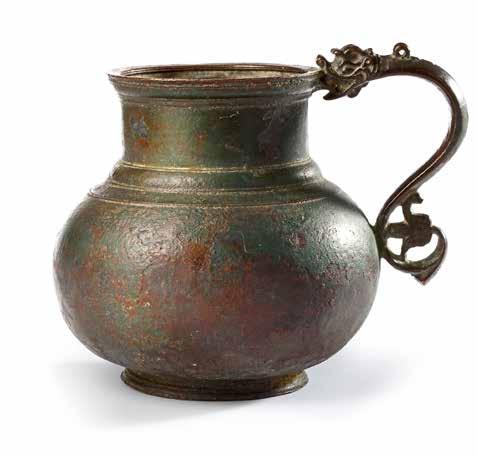
Height: 14 cm.
Estimate € 5000 - € 8000
Lot 233
15 KHURASAN BRONZE DOOR ORNAMENTS, PERSIA OR CENTRAL ASIA
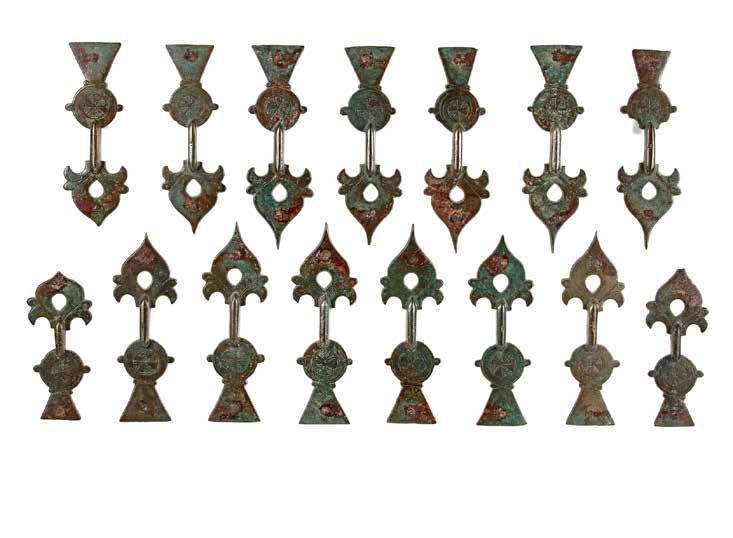
12TH CENTURY
15 bronze door ornaments in the shape of trefoils linked to a slim neck, rounded body standing on a splayed foot-ring.
Mounted 82 by 54.5 cm.
Estimate € 4000 -€ 6000
Lot 234
A SET OF GILT BRONZE HORSE TRAPPINGS, CENTRAL ASIA 14TH-15TH CENTURY
A set of twenty-four bronze horse trappings of varying shapes covered in gold, moulded in relief with various naturalistic motifs.

Large (5): 5.7 by 7.5 cm
Medium(4): 4.2 by 2 cm
Small(11): 3.8 by 2 cm
Smallest(4): 3.1 by 1.4 cm
Estimate € 2000 - € 3000

Lot 235
AN OTTOMAN SILK BARBER’S APRON (BERBER FUTASI) TURKEY, 17TH CENTURY
A fine brocaded silk barber’s apron, decorated with a series of pomegranates motifs linked to four split palmettes in gold colored silk thread against a red ground. 71 by 71 cm.
Estimate € 8000 - € 12.000
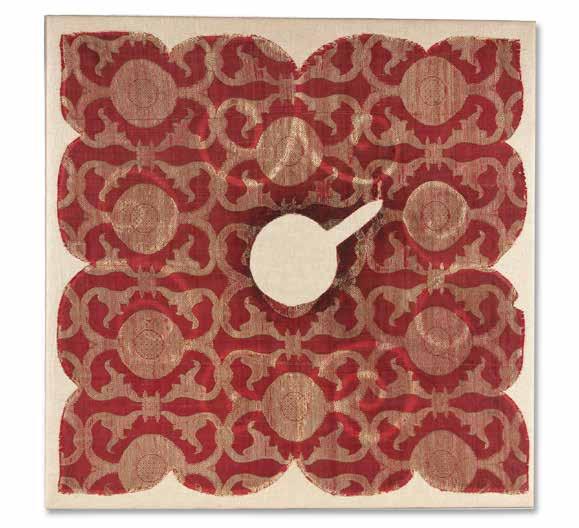
KHORASAN BRONZE EWER, PERSIA

12TH-13TH CENTURY
The cylindrical slightly upward opening body rests on a round base the top is flat and the cylindrical neck has a collar at its lower part and on top is a high semi-opened spout.The body is decorated on one side with a round medallion and opposite by a three-lobed cartouche, both with floral designs. arabesque motifs in cartouches including a sphinx An epigraphic band with foliated Kufic runs around below the shoulder and a similar one on the flat top the neck decorated with a seated lion to either side.
Height: 36 cm.
Estimate € 2000 - € 3000
Lot 237
AN UMAYYAD INSCRIBED BRONZE
OIL LAMP, POSSIBLY ANDALUSIA
12TH-13TH CENTURY
On spreading shaped trumpet foot, with lion’s head cover and with four spouts each with heart shaped funnel. The simple loop handle with finial in the form of a bird, inscribed to the shoulder.

Height: 18 cm.
Estimate € 1500 - € 2000
Lot 238
A SAFAVID GILT DECORATED DAGGER, PERSIA, 17TH CENTURY
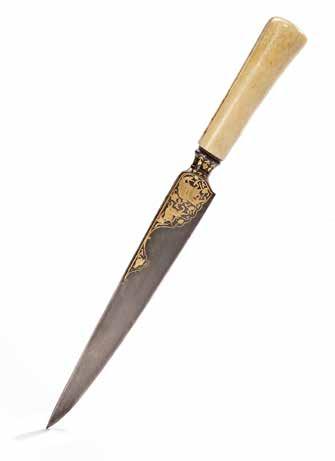
The watered steel blade with thickened spine, central ridge with raised lobed cartouches, the blade and spine gilt decorated with fighting animals, the join with single gilt flowers.
Length: 41 cm.
Estimate € 6000 - € 8000
Lot 239
Of hemispherical form on spreading trumpet foot, the shallow domed cover, the bowl plain save for a band of elegant Naskh benedictory inscription around the rim on an engraved scrolling foliate ground, the cover with similar engraved band.

Height: 22 cm.
Diameter: 15 cm.
Inscription
‘Glory, prosperity, health, power, safety, happiness, satisfaction, divine care, abundance, health, completude, perpetuity and to him [the owner] Paradise’.
22 cm. height, 15 cm. diam.
PROVENANCE
Private collection, 1970’s.
Estimate € 1200 - € 1500
Lot 240
Of truncated waisted conical form with a large splayed foot and a tall, ridged, cylindrical neck rising to a tapered candle holder.

Height: 23 cm. Width 19 cm.
Estimate € 1500 - € 2000
A LARGE CARVED MAMLUK BRASS VESSEL, EGYPT OR SYRIA, 16TH CENTURY

A large brass vessel with compressed body, short neck and everted rim, applied around the mouth with two rings, engraved around the shoulder with alternating roundels of calligraphic inscriptions and blossoming branches, between two bands of inscriptions, all above a band of foliate scrolls with downward pointing slender palmette.
Inscriptions: in large thuluth script
-Roundels of the word ‘Allah’ surrounded each by a part of v.29 from surah Al-Fath.
-Upper band enclosing v.62 from surah Yunus, v.170 from surah Al-Imraan, v.73 from surah Az-Zumar.
-Lower band enclosing Ayat- Al-Kursi v.255 from surah Al-Baqraa.
Height: 50 cm.
Diameter: 55 cm.
PROVENANCE
Private collection, France
Estimate € 3000 - € 5000
A MAMLUK BRASS BOWL WITH INSCRIPTIONS, EGYPT OR SYRIA, 14TH CENTURY

A brass bowl with rounded base and sloping inverted sides leading to a lipped rim, the shoulder engraved with a band of bold thuluth inscription on a floral engraved ground separated by six roundels of floral leafy sprays. A lower band of dense interlaced motifs issuing inverted drop shapes.
Diameter: 23 cm.
Height: 13 cm.
Inscriptions al-amir, al-kabir, al-alami, al-gazi, al-mujahidi, al-murabiti, al-muaid, al-malki, al-nasri, al-krimi, al-ali, al-mawlawi.
(made for High Authority, the Lordly, the Great Emir, the Conqueror, the Learned, the Diligent, the Possessor, [the officer of] al-Malik al-Nasir”).
Estimate € 4000 - € 6000
A Multan pottery thick tile of square form and decorated in cobalt blue and turquoise with a geometric design and leafy sprays. 34.5 by 29.5 by 4.5 cm.


Estimate € 2000 - € 3000
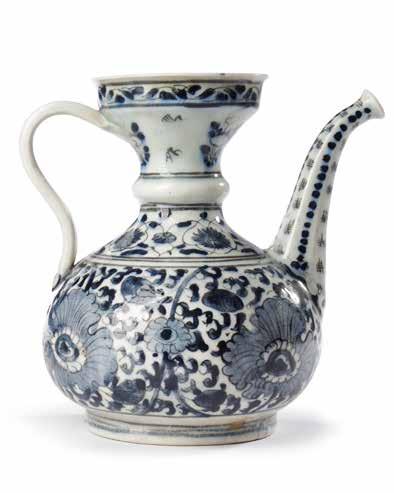
Of globular form rising to a thin neck with a wide rim, decorated in underglaze blue with large flowerheads surrounded by leafy palmettes, with an upper band of smaller flowerheads with scrolls, the neck with flower motifs, the rim with leafy scrolls and the interior with four-dot patterns, with a curvilinear handle and spout, decorated with pseudo-Chinese characters, signed on the reverse.
Height: 19.5 cm.
Estimate € 3000 - € 5000
Lot 245
A Multan pottery thick tile of square form and decorated in cobalt blue and turquoise with geometric designs. 23 by 23 by 3.5 cm.
Estimate € 2000 - € 3000
A FINE FRIT-WARE KUBACHI DISH, PERSIA TABRIZ

TIMURID TAMERLANE DYNASTY, LATE 15TH CENTURY
A fine frit-ware barbed dish resting on a short foot-ring with deep concave sides and a slightly lobed rim, decorated in the centre and around the rim with series of stylized chrysanthemums, painted in cobalt-blue against an opaque white ground. The back with a band of stylized calligraphy.
Diameter: 35 cm.
Height: 8 cm.
Comparison:Royal Ontario Museum, Toronto n.909.25.8
Tamerlane’s tableware, Lisa Golombeck, Robert B.Mason and Gauvin A. Bailey, Mazda Publishers 1996, Costa Mesa, CA 92626 USA, page 227, photo XV.
Similar piece in the Musée du Louvre, Paris
Estimate € 3000 - € 5000
Lot 248
AN AYYUBID TINNED-BRONZE
TALISMANIC BOWL, EGYPT OR SYRIA,13TH-14TH CENTURY
Shallow rounded form engraved to the interior with talismanic diagrams and inscriptions, stars and images of a dog, scorpion, snake and two-headed dragon, the exterior with a band of inscriptions to the rim. The outer band contains the names of various ailments that would be cured if drunk from this bowl as well as al-khazanah al-sharifah, ‘The noble Treasury’, and ‘Muzaffar al-Dunya wa al-Din’, to the inner bowl v.1-v.4 from surah Al-Inshiqaq, talismanic, magic texts and numbers.
Diameter: 11 cm.
The present lot is typical of the group of talismanic bowls known as ‘poison cups’. Poison cups are never dated and are all attributed to Syria or Egypt. They are characterised by representations of a scorpion, serpent, a dog-like animal and two intertwined dragons along with magical symbols, squares and words. For further reading see Francis Maddison and Emilie Savage-Smith, Science, Tools & Magic, London, 1997, pp. 73-74. For a very similar example, see Bonhams, Islamic & Indian Art, 4 October 2011, lot 137. Another similar brass bowl was sold at Sotheby’s, Arts of the Islamic World, 1 April 2009, lot 60.
Estimate € 3000 - € 5000
Lot 247
A Khorassan bronze bowl standing on a flared foot adorned with a band of animated naskh inscriptions on a dense scroll ground, the rounded body with alternating medallions and palmettes, the rim with a band of animated kufic script against a dense scrolling ground, most silver remaining

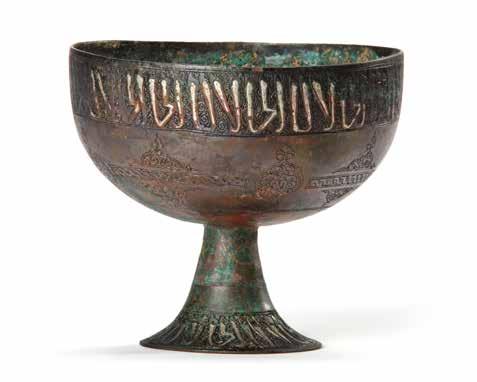
Height: 12 cm.
Diameter: 13.5 cm.
Estimate € 3000- € 5000
Lot 249
Of cylindrical form, on a splayed base, decorated with narrow bands of scrolling palmettes and floral arabesques, the neck with a central band comprising an inscription in nastaliq. Height: 27.5 cm.
Estimate € 2000 - € 3000
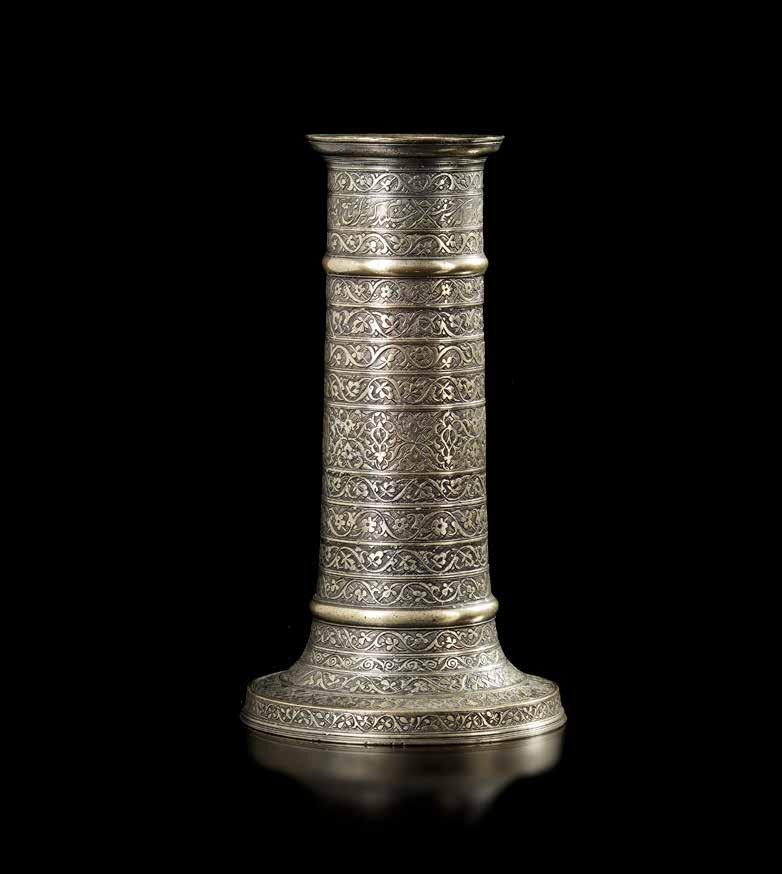
Lot 250
PERSIA, 19TH CENTURY
Of drop-shape form rising from a conical shaft with a raised boss, the central panel with a cut thuluth inscription of “Allah, Muhammed and Ali” on a ground of scrolling vine, around the outside terminating with fierce dragon-head terminals. 53.3 by 28.5 cm.
Estimate € 2000 - € 3000
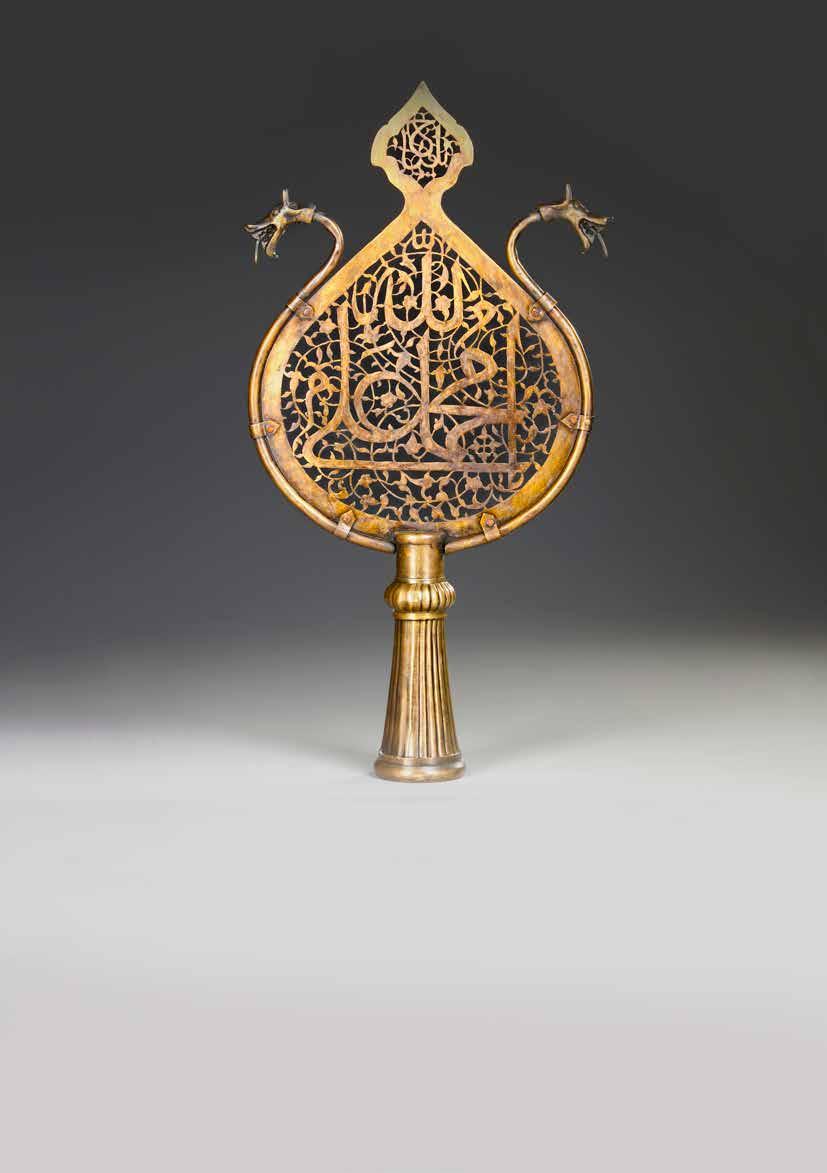

With rounded base and sloping inverted sides leading to a thickened rim, the shoulder engraved with a band of bold thuluth inscription interrupted by three scalloped roundels enclosing horsemen on a floral sprays ground. A lower band of dense interlaced motifs issuing inverted drop shapes.
Inscriptions: Izz li mawlana al-sultan malik al-arab wa al-ajam ‘Glory to our Lord, the Sultan “.
Diameter of the mouth: 18 cm.
Height: 11 cm.
Estimate € 2000 - € 3000
Lot 252
A painted steel dispatch box with interior fitted for writing. The case has a lock, The interior is painted black with gilded borders, a central panel enclosing roundel of floral leafy sprays, surrounded by a diaper band contains cartouches enclosing Persian calligraphy in nastaliq script. The cover and the sides elegantly painted and gilt with flowers and foliage and Persian calligraphy.

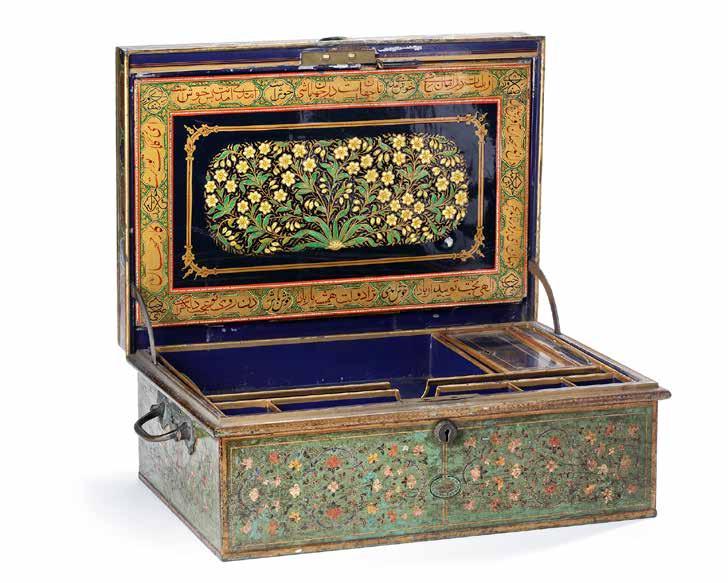
30 by 43 cm
Height: 18.8 cm
Estimate € 2000 - € 3000
Lot 253
A PAIR OF GILT AND ENAMEL GLASS MOSQUE LAMPS, MAMLUK STYLE LATE 19TH CENTURY

Each of green tinged glass, with globular body with 6 applied loop handles, flaring cylindrical neck and short splayed foot, decorated in gilt and polychrome with a frieze of interlocking flower-filled medallions, above ornamental bands of further flower-filled medallions on a scrolling ground, the base with central floral medallion.
30.8 cm. height (2)
PROVENANCE
Sotheby’s, Arts of the Islamic world, 24 October 2007, lot 340.
Estimate € 6000 - € 8000
MAMLUK-STYLE ENAMELED GLASS MOSQUE LAMP BY PHILIPPE-JOSEPH BROCARD, FRANCE 19TH CENTURY
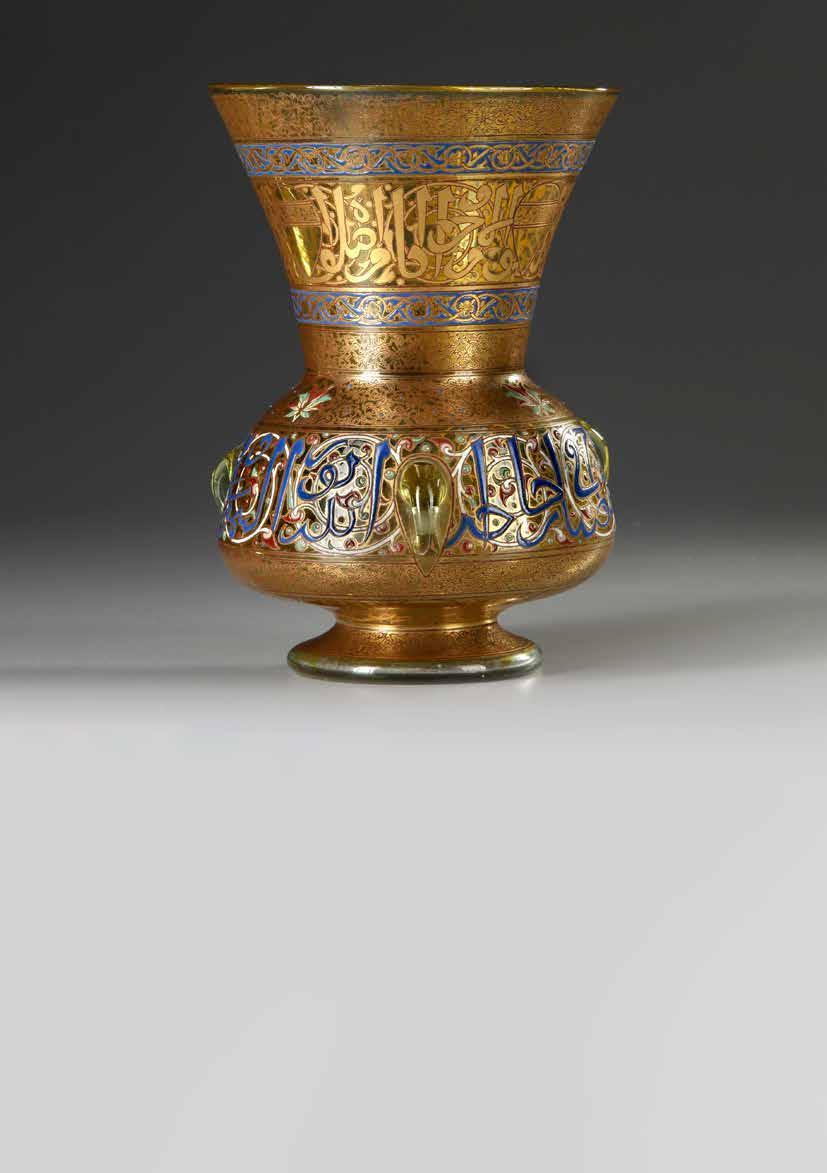
Standing on a spreading foot with high flaring mouth with finely drawn blue foliate scroll enclosing a thuluth inscription interrupted by three roundels containing small inscriptions, the body enameled with a band of blue thuluth calligraphy against a polychrome scrolling leafy ground punctuated with three applied loop handles.
Inscriptions
Around the mouth: surah At-Tawbah v.18
Around the body: surah Al-Noor v. 1
Height: 25 cm.
Philippe-Joseph Brocard (1831-1896) specialised in the production of imitations of Medieval and Islamic glass. He gained critical acclaim at the Paris Universelle Exposition of 1867, where a number of vessels by him decorated in this style were shown. Brocard’s work was subsequently shown at the 1873 Vienna World’s Fair and 1878 Paris Exposition.
Estimate € 12.000 - € 15.000
Lot 255
A MAMLUK-STYLE ENAMELED GLASS VASE BY PHILIPPE-JOSEPH BROCARD, DATED 1871

A frustoconical shaped glass vase with enamel decoration of floral medallions interlacing palmettes, singed Brocard Paris and dated 1871.
Height: 19 cm.
Diameter: 29 cm.
Philippe-Joseph Brocard (1831-1896) specialised in the production of imitations of Medieval and Islamic glass. He gained critical acclaim at the Paris Universelle Exposition of 1867, where a number of vessels by him decorated in this style were shown. Brocard’s work was subsequently shown at the 1873 Vienna World’s Fair and 1878 Paris Exposition.
Estimate € 3000 - € 5000
AN IZNIK BOWL FRAGMENT
OTTOMAN TURKEY
16TH CENTURY
A fritware bowl fragment decorated in cobalt blue, black and emerald green with interwoven split palmettes against a bole-red ground.

Height: 13 cm.
Estimate € 2000 - € 3000
AN IZNIK TILE FRAGMENT, OTTOMAN TURKEY, 16TH CENTURY
A fritware tile fragment decorated in cobalt blue, turquoise, copper red and emerald green with a rosette and arabesque.
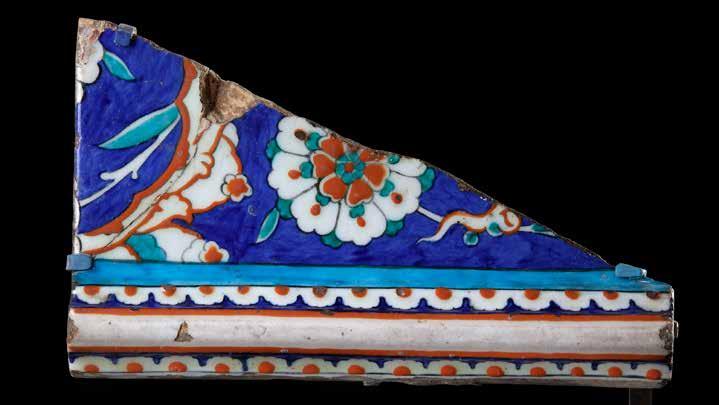
Length: 24.5 cm.
Estimate € 600 - € 800
Lot 258
A PAIR OF RARE AND FINE IZNIK TILES, OTTOMAN TURKEY, 16TH CENTURY
Decorated in cobalt blue, turquoise and red with medallion shaped cartouches containing tulips and carnations, all within arabesque patterned border. Each tile 22 by 22 cm.

PROVENANCE
Private collection, Germany
Estimate € 2000 - € 3000
Of rectangular form, the cobalt-blue ground with a meandering tendril linking a serrated leaf overpainted by flowers, a part rosette at each end issuing small floral sprays, repaired break. 12.5 by 24.3 cm.

CATALOGUE NOTE
An identical tile is in the Sadberk Hanim Museum, Istanbul (Altun, Ara, Carswell, John and Oney, Gonul: Sadberk Hanim Museum Turkish Tiles and Ceramics, Istanbul, 1991, no.I.52, p.38).
PROVENANCE
Christies London, 23 April 2002, lot 186.
Estimate € 1000 - € 1400
Lot 260
A panel of four square Ottoman Empire Dome of the Rock tiles, painted in underglaze cobalt blue with a trellis of split and winged palmettes with cloud-scroll collars, framed. 19.5 by 19.5 cm. each
CATALOGUE NOTE.
This design was first seen on the Dome of the Rock in Jerusalem, which was tiled on the instructions of the Ottoman Sultan Suleiman the Magnificent around 1545. Soon after similar tiles appeared on several building in Aleppo, most notably Bait Jumbiatt, the Ummayad Mosque and the Khosrowiyya Mosque, as well as numerous private houses.
Estimate € 2000 - € 3000
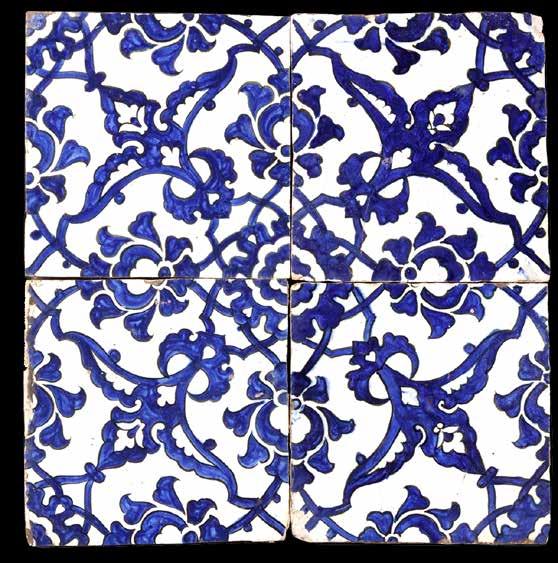
Lot 261

A Tombak ewer of pyriform shape, with hinged dome cover, ringed neck and serpentine handle, “s” shaped spout with flutes at the base, engraved with vertical flutes containing stylized leafy details, the lid with pine-shaped terminal.
Height: 38 cm.
Tombak wares became particularly popular during the eighteenth and nineteenth century for their gold-like quality (Petsopoulos 1982, pp.33-35). During Ottoman times it was considered inappropriate for vessels in solid gold to be used for utilitarian purposes; copper-gilt (tombak) wares were preferred instead. A number of tombak objects from the royal kitchenware are now in the Topkapi Palace Museum, including a sherbet pitcher, a rose-water sprinkler and a ewer comparable in form to the present piece (Istanbul 1986, pp.43-45, pl.2 and pl.3). Tombak manufacture entailed applying gold leaf and mercury to amalgam-gilded copper.
Estimate € 8000 - € 12.000
Lot 262
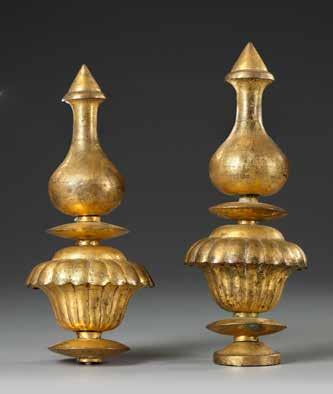
Metalwork, copper and zinc. Composed of four sections, the wide, domed base of a vase shape mounted, two discs with a flower shaped base.
Height: 25 cm.
Estimate € 3000 - € 5000
Lot 263
A PAIR OF OTTOMAN GILT- COPPER ( TOMBAK) BELT BUCKLES TURKEY, 19TH CENTURY
Two Ottoman tombak belt buckles with leaf shaped body, with chased repoussé decoration featuring a crescent amidst flower heads and foliage. Each: 31 cm.

Estimate € 3000 - € 5000
Lot 264
AN OTTOMAN GILT-COPPER (TOMBAK) HAMMAM BOWL

18TH CENTURY
An Ottoman hammer bowl of elongated form with fluted and ribbed sides, standing on a small base and covered with tombak.
Diameter: 25 cm.
Height: 11 cm.
Estimate € 4000 - € 6000
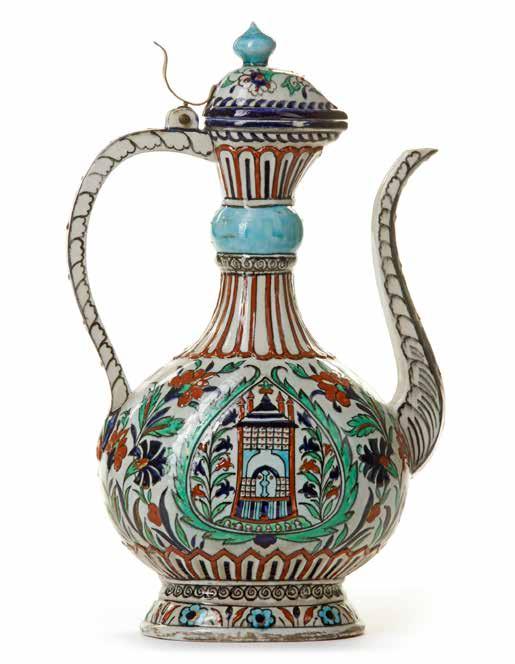
With rounded body rising from short flared foot, the long neck with pronounced turquoise central boss, s-shaped spout and simple loop handle linking body and neck, with separate lid with knop finial held by tombak hinge, the white body decorated in cobalt-blue, turquoise, green, black and bole-red, some details highlighted in gold, the body with two pronounced drop shaped medallions, one containing a heavily stylized figure, the other a small kiosk with four minarets, both flanked by hyacinth sprays, the medallions framed by green leaves and further sprays of carnations, the boss at the neck bordered by raised lobed motifs, intact.
Height: 35 cm.
Estimate € 1600 - € 2000
AN OTTOMAN SILVER METAL-THREAD EMBROIDERED PANEL TURKEY, 19TH CENTURY
Of rectangular form, the silver thread embroidery on a blue ground arranged in a central panel enclosing a basket filled with flowers, surrounded by floral leafy sprays. 46 by 86 cm.

Estimate € 800 - € 1200
AN OPENWORK STEEL PANEL (WINDOW), MUGHAL 18TH-19TH CENTURY

Of rectangular form, finely worked cut steel spiraling tendrils issuing palmettes and leaves. 25 by 40 cm.
Estimate € 800 - € 1200
Lot 268
17TH CENTURY
A rectangular textile woven fragment, comprising three sections superbly and colourfully embroidered in satin stitch.
The red velvet central part embroidered in silk threads with roundels and cupsed cartouches enclosing Ottoman Arabic inscriptions in thuluth script and mirrored style, flanked on both sides with a cream coloured velvet bands embroidered with interlocked palmettes amongst floral leafy sprays.
109 by 60 cm.
Estimate € 3000 - € 5000
A RARE MAMLUK SILK LAMPAS FRAGMENT, EGYPT OR SYRIA, 14TH CENTURY
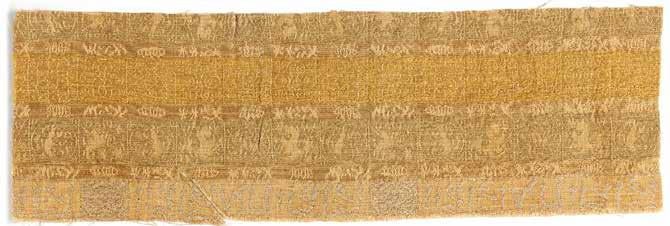
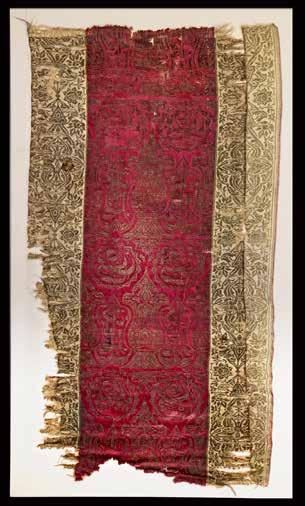
The registers decorated with calligraphy, foliate and animal designs interspersed with narrow registers of foliate designs picked out in gold thread.
36 by 11.5 cm.
The inscriptions are a repetition of: al-’izz wa al-nasr wa al-iqbal, ‘Glory and Victory and Prosperity’.
Estimate € 800 - € 1200
Lot 270
A LARGE CAIROWARE GOLD, SILVER AND COPPER INLAID BRASS KURSI
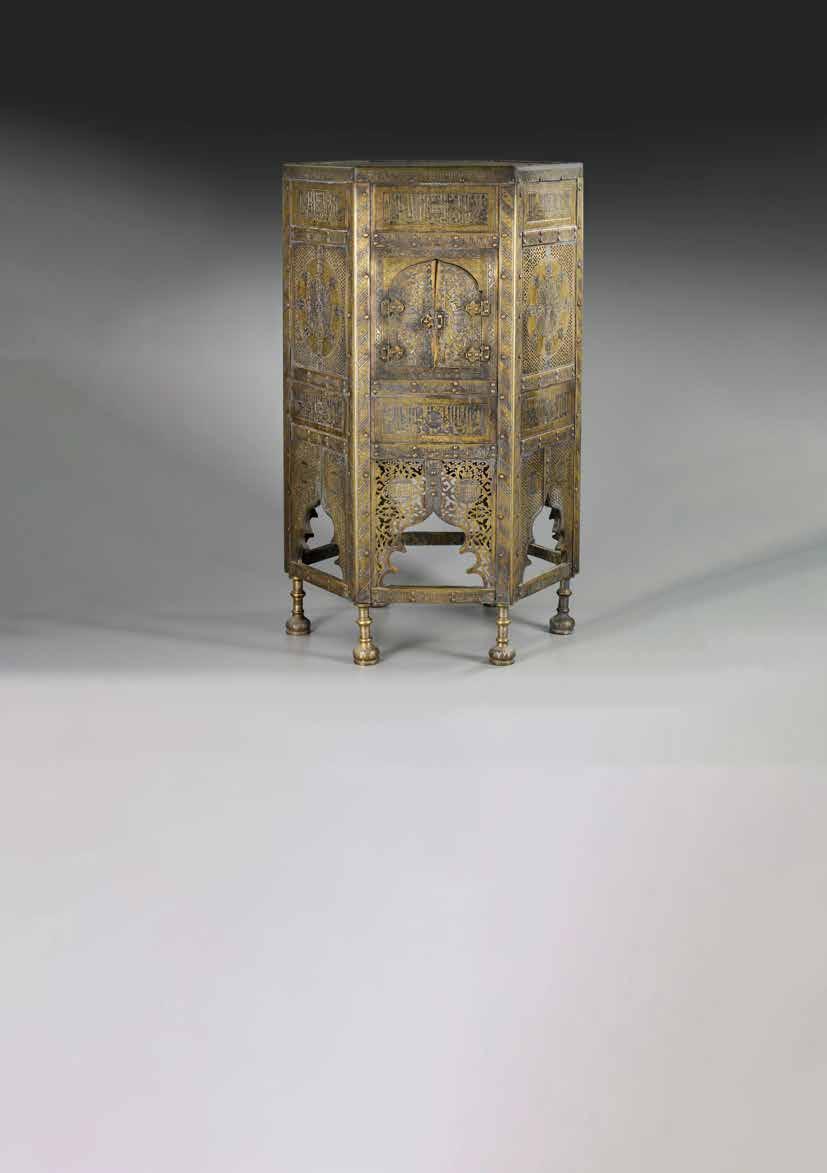
EGYPT, LATE 19TH CENTURY
In the Mamluk style, of hexagonal cylindrical form standing on knopped baluster feet supporting arched openings, an arched opening with two doors in the centre of one side, the surface covered with panels of silver inlay and intricate pierced and incised decoration forming titular and dedicatory inscription bands and roundels, palmette scrolls, bird roundels and arabesques, fine fretwork interlace and other geometric and foliate motifs, copper pins holding the panels.
Height: 80.5 cm.
Width: 50.5 cm.
PROVENANCE
Private collection, France
Estimate € 4000 - € 6000

Gouache color heightened with gold on paper, the lion is attacking an elephant on whose back is a howdah containing a price with his mistress attacking the lion with a spear. The mahout (driver) of the elephant sits on the elephants neck and looks over his shoulder to watch. He holds an ankusha (elephant goad) in his left hand. The elephant has its trunk raised and is agitated due to the tiger attack. It has a richly decorated blanket under the howdah, which also has painted decoration. A green foreground under the moonlight. Framed and glazed.
Painting: 23.5 by 15 cm.
Estimate € 500 - € 800
Gouache pigments heightened with gold on paper, laid down on an album page with outer polychrome borders, depicting a Hindu woman seated with a Mughal lady and her servant in a temple. The later outer margin is decorated with Persian inscriptions in nastaliq script reserved in clouds on a cream-colored ground, further stylized with polychrome flower sprays on a gilt ground. 39 by 26 cm.
Estimate € 1000 - € 1200

Lot 273
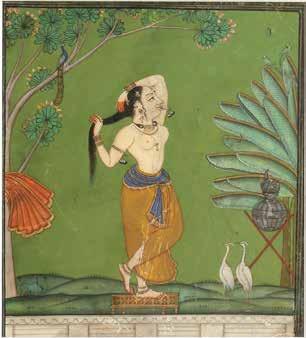
LATE 18TH CENTURY
Gouache color heightened with gold on paper, depicting a prince with his consort while a group of women playing music at instrument on a terrace with a landscape in the background.

Miniature: 26.5 by 18 cm.
Frame: 38.5 by 28 cm.
Estimate € 400 - € 600
Lot 274
MEWAR INDIA, 19TH CENTURY
Gouache colors heightened with gold on paper, depicting a beauty adorned with gold jewellery, combing her hair. Painting: 23 by 21 cm.
Estimate € 400- € 600
Ink, gouache and gold on paper pasted on a cardboard page, four in Persian, in Nastaliq, in reserve in clouds on a gold background garnished with foliage.

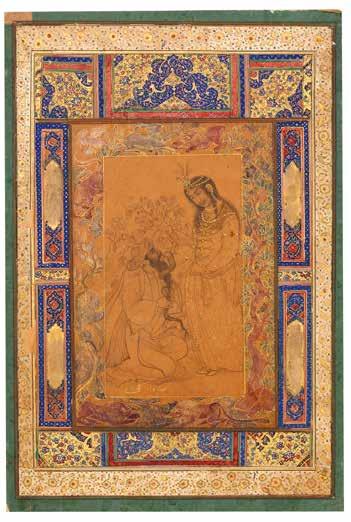
Text: 21 by 14 cm.
Page: 34 by 23 cm.
Estimate € 1000 - € 1200
Ink on paper with the use of gold, inner borders decorated with animals and vegetation in colors and gold, outer border with illuminated panels cut out from earlier manuscripts. 14.2 by 8.5 cm.
The inscriptions read: ‘His Holiness, Whad Juki, 112 (1)112 AH/1700 AD or 112(0) AH/ 1708 AD’, and on the top the name ‘Mansur’.
Estimate € 800 - € 1200
Lot 277
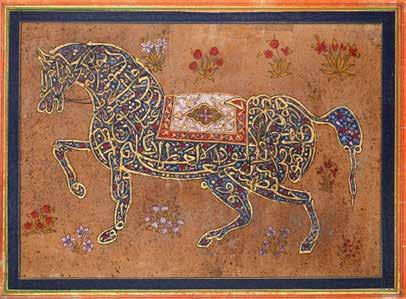
19TH CENTURY
Ink, opaque watercolor and gold on paper
Text: Quran 2 surah Al-Baqarah v.255. The text of the Throne Verse begins at the horse’s head; the first half of the verse is written in the area in front of the saddle; the second half of the verse is written in the area behind the saddle, and the final words are spread across the area below the saddle from the hind quarters to just above the vertical front leg.
25.5 by 35 cm.
Estimate € 2000 - € 3000
Lot 278
AN INDO-PERSIAN CALLIGRAPHIC PANEL, 19TH CENTURY
Persian text, two lines elegant black nastaliq script within clouds on gold and polychrome ground, the outer border heavily gilt and decorated with floral sprays on a blue ground.

Inscriptions: Arabic alphabetical order, a verse from Quran in praise of Allah.
Signed “written by Deep Narain”. Framed and glazed.
34 by 22.7 cm.
Including frame: 46.5 by 37 cm.
Estimate € 500 - € 800

Persian manuscript on paper, each page with a central panel enclosing 15 lines in nastaliq black script, surrounded by diagonally written scripts, ruled in gilt and blue borders, each chapter with an opening biofolio with a gilt and polychrome decoration. Multiple miniatures painted in gouache colors with different scenes of typical Qajar era.
In Qajar lacquer binding decorated with dense design of flowers. 17 by 26 cm.
This book contains different articles or chapters of al-Saadi work.
1-The Gulistan: prose written, means ‘the rose garden’ and the text is divided into eight chapters called babs (‘gates’) corresponding to the eight gates to the garden of paradise. It is a moralistic and anecdotal work mostly written in hikayats (short prose vignettes) combined with verse. These are light and humorous in tone, particularly in comparison to his earlier work, the Bustan. The poet writes in the Gulistan’s epilogue that his aim was to deliver advice in palatable form. 2- The Bustan: contains the fruits of Saadi’s long experience and his judgements upon life, and is illustrated by a vast collection of anecdotes. It includes accounts of Saadi’s travels and his analysis of human psychology. He often mentions his accounts with fervour and advice similar to Aesop’s fables. The book has ten chapters regarding the issues of ethics and training; namely, justice, mercy, love, humility, contentment, devotions, education, gratitude, repentance, and praying. 3- Persian Poetry
Abu-Muhammad Muslih al-Din bin Abdallah Shirazi, better known by his pen name Saadi, was a major Persian poet and prose writer of the medieval period. He is recognized for the quality of his writings and for the depth of his social and moral thoughts. Saadi is widely recognized as one of the greatest poets of the classical literary tradition, earning him the nickname “Master of Speech” among Persian scholars.
Estimate € 10.000 - € 14.000
Lot 280
Gouache heightened with gold on paper, a young man wearing a sky-blue robe with elaborate turban, a young woman wearing a gilt splashed red robe, embracing each other and drinking wine on a gold ground, ruled in polychrome borders, the margins with gilt and striking blue decoration. 29 by 19 cm.
Estimate € 1500 - € 2500
Lot 281
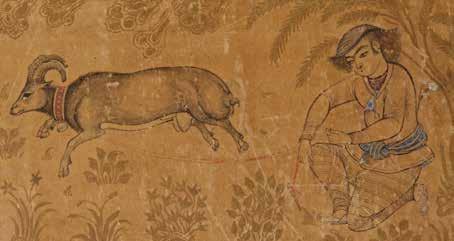

Ink and watercolor on paper, depicting a seated shepherd holding a tow of his goat in a landscape. 12 by 19 cm.
Estimate € 800 - € 1200
Lot 282
A Safavid calligraphic quatrain on a gold ground, with four lines of neat black diagonal nastal’iq script on a gold ground with polychrome floral scroll, with blue border and laid down on red album page. Panel: 25.5 by 12 cm.

Estimate € 600 - € 800
Lot 283
A TEMPLE PLAN OF THE JAGANNATH TEMPLE AT PURI, ORISSA INDIA
19TH CENTURY
Pigments on pata or cloth, depicting symbolic representations of the ritual topography of city-temple, pilgrimage souvenirs painted by the hereditary citrakaras or painters associated with the great temple of Jagannath at Puri in Orissa in eastern India. The earliest known by far is one in the Victoria and Albert. Museum dated 1670.

Painting: 22 by 24.5 cm.
Estimate € 500 - € 800
The tile of rectangular form with cusped ends and small arch at the centre of each horizontal edge, comprising elements in cobalt-blue, turquoise, yellow, white and red, depicting the Basmala in elegant white naskh script between two flower heads with a turquoise border on a cobalt-blue ground. 33 by 24 cm.

Estimate € 4000 - € 6000
Lot 285
__________________________________________.
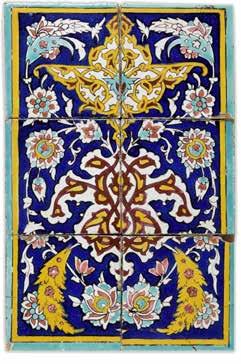
ZAND DYNASTY, 18TH CENTURY
The square panel comprising 6 tiles, decorated in yellow, brown and turquoise on a white and blue ground with lotus and peony flowers amongst foliage and interlaced floral sprays, in a reciprocal yellow and turquoise cusped border. 42 by 28 cm.
Estimate € 1200 - € 1500
Lot 287
A PERSIAN SET OF ELEVEN INSCRIBED STEEL DIVINATION RODS 19TH CENTURY
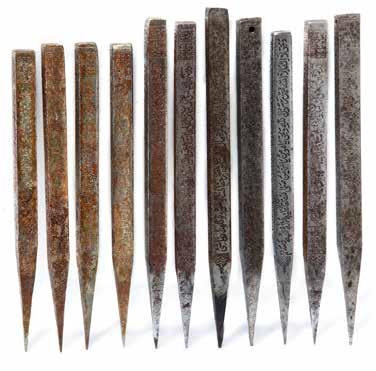
Each of faceted form, inscribed to each face with verses from the Quran and a domed design. The length varies from 18 to 22.2 cm.
Estimate € 600 - € 800
Ceramic with decoration painted in blue, yellow and manganese on a yellow-green background, representing two kneeling figures in a richly flowered landscape.

66.5 by 66.5 cm.
Estimate € 1500 - € 2000
Lot 288
AN INDIAN IVORY PACHISI SET, 17TH CENTURY
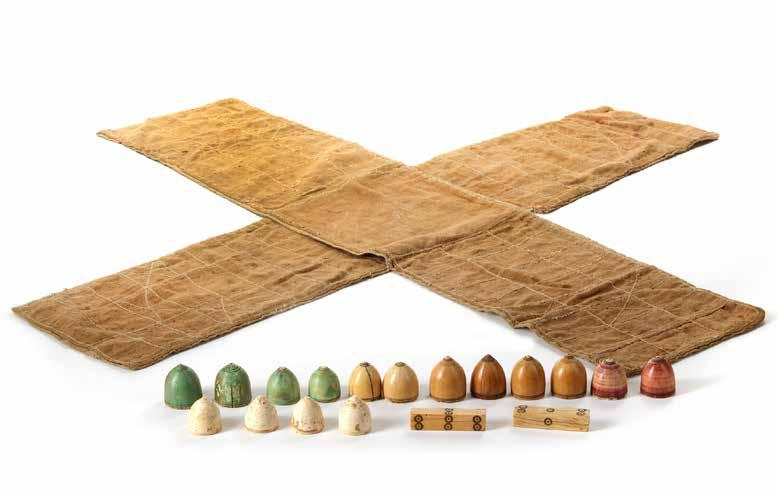
Comprises sixteen domed ivory pieces (narads) and two ivory long dice (usually called pasas). The pieces are of characteristically dome-shaped solid ivory, engraved at the top with circular grooves which hold red, black green and yellow colored lac – a color for each of the four players.
Height: 3.5 cm.
Diam: 3 cm. (16).
PROVENANCE
Private collection, Germany
Estimate € 1500 - € 2000
Lot lot 289
A MUGHAL DAGGER WITH PIGEON-SHAPED HILT INDIA, 18TH CENTURY
A Mughal dagger with pigeon-shaped hilt and associated watered-steel blade with double curve and central ridge.

Lenght: 37 cm.
Estimate € 1000 - € 1500
AN OTTOMAN MOTHER OF PEARL AND BONE INLAID WOODEN MIRROR, SYRIA, 19TH CENTURY
Of rectangular form with feet and tapering crest, decorated in mashribiyya, mother-of-pearl inlay, the crest in openwork with interlaced vines. The crown and sides are very finely handcrafted with inlaid mother-of-pearl in floral and geometric Islamic design. 234 by 110 cm.
Estimate € 2000 - € 3000
AN OTTOMAN MOTHER OF PEARL, BONE AND TORTOISESHELL INLAID WOODEN MIRROR, SYRIA, 19TH CENTURY
A large Damascus mother-of-pearl inlaid wood mirror of rectangular form with feet and tapering crest, decorated in mother-of-pearl inlay, the crest in openwork with interlaced vines. 113 by 212 cm.
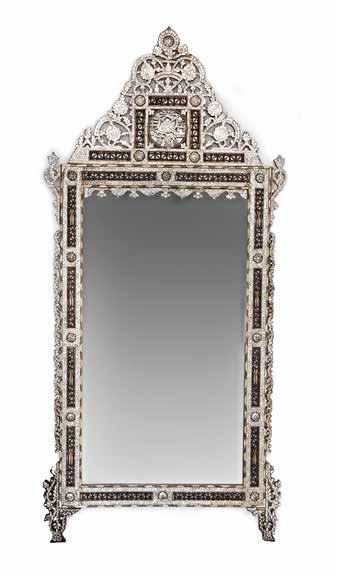
Estimate € 2000 - € 3000
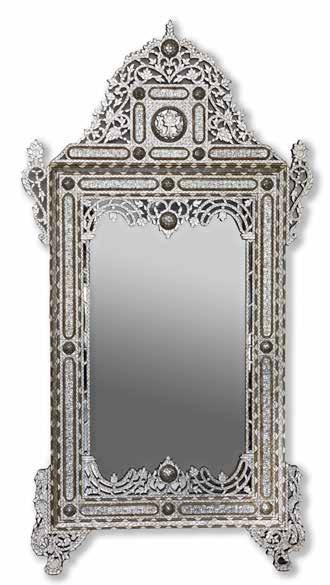
Lot 292

Of long rectangular form, woven in red, blue, green and cream silk, the central panel with alternating horizontal bands of floral interlace and cartouches enclosing flowerheads and vegetal motifs, a panel enclosing floral sprays to each end, the borders with floral vine
Length: 299
Width: 34 cm.
Estimate € 1200 - € 1500
Lot 293
A SILK CAUCASIAN EMBROIDERED PRAYER RUG, SAFAVID, AZERBAIJAN
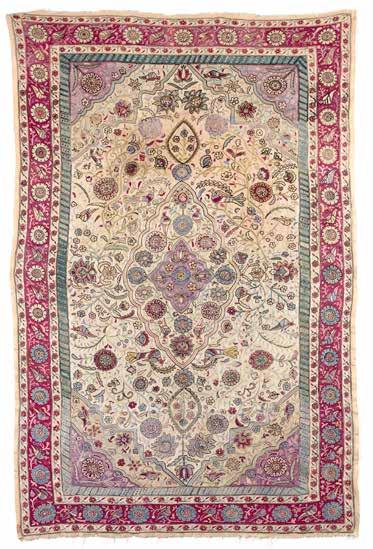
18TH CENTURY
180 by 120 cm.
Estimate € 3000 - € 5000

Silk woven with silver thread, the decoration comprising a reticulated design of eglantines alternating with leafy sprigs on an olive ground.

89 by 35 cm.
For two closely related fragments offered at auction, see Sotheby’s London, 24th October 2007, lot 362.
See also Patricia Baker, Islamic Textiles, London 1995, p.119, for an example in the Musée des Tissus, Lyons.
Estimate € 400 - € 600
Rectangular, decorated in cream on a black ground with inscription filled trellis, backed. 110.5 by 48.5 cm.
Estimate € 600 - € 800
AN EUROPEAN SILK, VELVET AND METAL TEXTILE, PROBABLY ITALY EARLY 18TH CENTURY
98 by 85 cm.
Estimate € 600 - € 800
A SAFAVID PRAYER TEXTILE WITH METAL, PERSIA, MID 18TH CENTURY


177 by 113 cm.
Estimate € 600 - € 800
A PERSIAN KASHAN CARPET,EARLY 20TH CENTURY

500 by 323 cm.
Estimate € 600 - € 800
A TRANSYLVANIAN RUG, SECOND HALF 19TH CENTURY

165 by 120 cm.
Estimate € 400 - € 600
Lot 300
A ZIEGLER MAHAL CARPET PERSIA, LATE 19TH CENTURY

490 by 288 cm.
Estimate € 800 - € 1200
Lot 301
A CAUCASIAN SHIELD KAZAK RUG, AZERBAIJAN LATE 19TH CENTURY
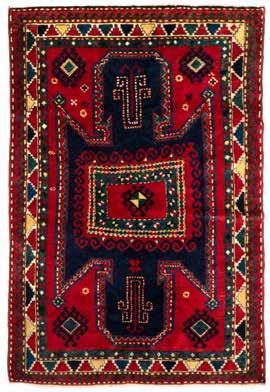
210 by 143 cm.
Estimate € 300 - € 500
Lot 303
A SHIRVAN CAUCASUS RUG
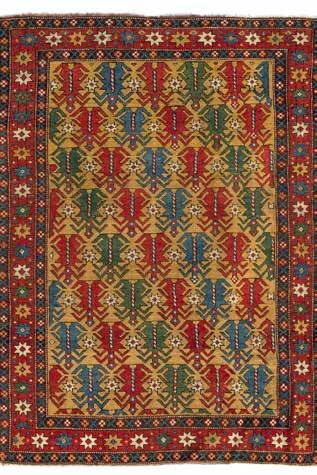
AZERBIJAN, LATE 19TH CENTURY
153 by 117 cm.
Estimate € 600 - € 800
Lot 302
A PERSIAN TABRIZ CARPET
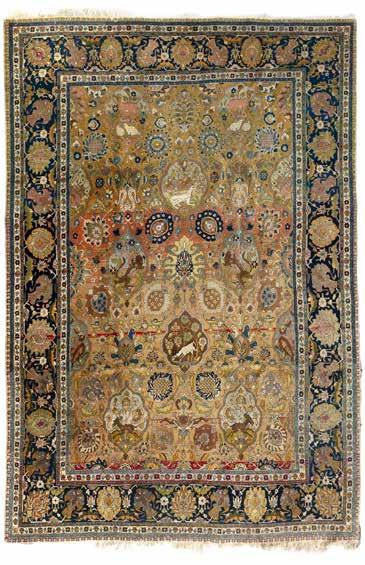
390 by 262 cm.
Estimate € 400 - € 600
Lot 304
A PERSIAN KASHAN CARPET


EARLY 20TH CENTURY
206 by 134 cm.
Estimate € 800 - € 1200
Lot 305
A CAUCASIAN WOLKENBAND
KHNDZORESK KAZAK
AZERBAIJAN
LATE 19TH CENTURY
229 by 140 cm.
Estimate € 600 - € 800
Lot 307
A TABRIZ CARPET, PERSIA, 1900
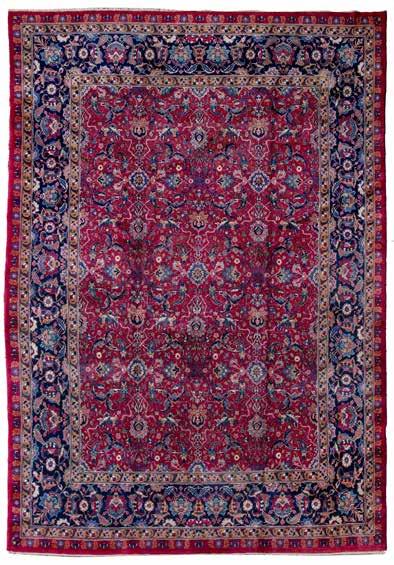
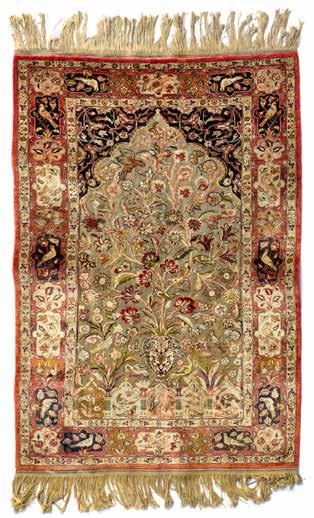
490 by 348 cm.
Estimate € 800 - € 1200
Lot 306
A PERSIAN SOUF KASHAN CARPET
LATE 19TH CENTURY
158 by 103 cm.
Estimate € 600 - € 800
Lot 309
A HERIZ SERAPI, PERSIA, 1900
285 by 235 cm.
Estimate € 800 - € 1200
Lot 308
A HERIZ SERAPI, PERSIA, 1900
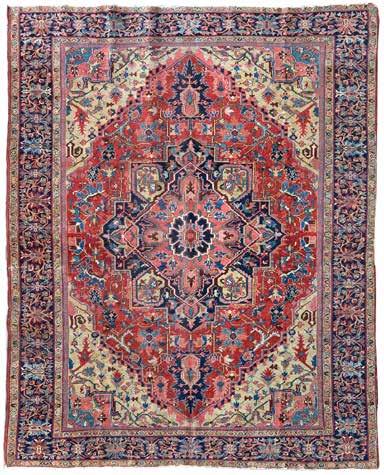

440 by 334 cm.
Estimate € 700- € 900
Lot 310
A LONG HERIZ RUNNER, PERSIA, 1900
554 by 90 cm.
Estimate € 400 - € 600
Lot 311
A KAZAK RUG, CAUCASUS


MID 19TH CENTURY
333 by 175 cm.
Estimate € 500 - € 800
Lot 313
A LANKORAN RUNNER, CAUCASUS
1920
426 by 113 cm.
Estimate € 300 - € 500
Lot 312
A KASHAN KORK RUG, PERSIA, 1920

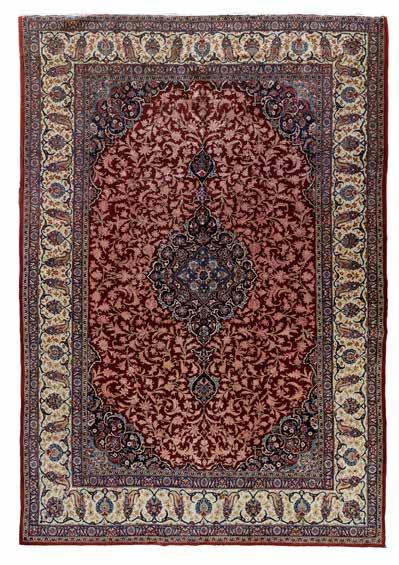
315 by 216 cm.
Estimate € 600 - € 800
Lot 315
A HERIZ SERAPI CARPET, PERSIA LATE 19TH CENTURY
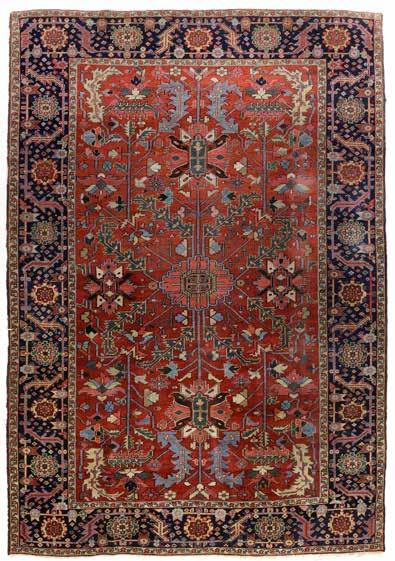
397 by 284 cm.
Estimate € 500 - € 800
Lot 314
A KAZAK RUG, CAUCASUS MID 19TH CENTURY
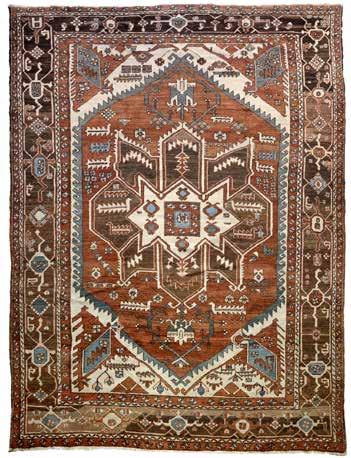
333 by 175 cm.
Estimate € 800 - € 1200
A TEHRAN RUG, PERSIA CIRCA 1920
307 by 200 cm.
Estimate € 600 - € 800
Lot 317
A HERIZ SERAP RUG, PERSIA LATE 19TH CENTURY
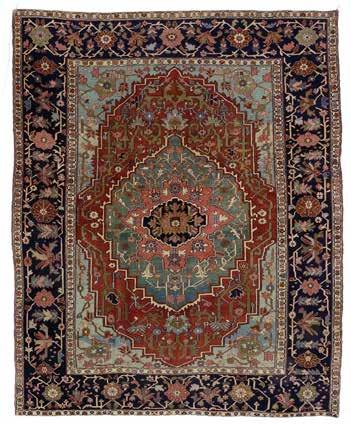

291 by 237 cm.
Estimate € 800 - € 1200
Lot 319
A KASHAN PRAYER RUG
PERSIA, CIRCA 1920
215 by 146 cm.
Estimate € 600 - € 800
Lot 318
A SPANISH CARPET, CIRCA 1920
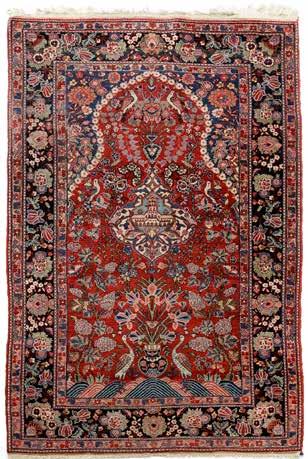

297 by 248 cm.
Estimate € 600 - € 800
Lot 321
A SILK AND METAL HEREKE RUG TURKEY, 1950


155 by 98 cm.
Estimate € 600 - € 800
Lot 320
A HERIZ RUNNER, PERSIA 1900
340 by 100 cm.
Estimate € 300 - € 500
Lot 322
A SILK HEREKE RUG, TURKEY, 1950
137 by 99 cm.
Estimate € 400 - € 600
Lot 323
A HERIZ SERAPI RUG, PERSIA, 1900
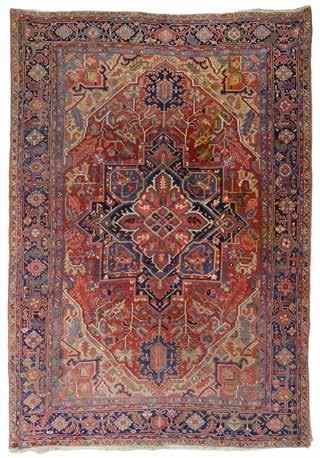

323 by 219 cm.
Estimate € 500 - € 700
Lot 324
A VERAMIN CARPET, PERSIA, 1900
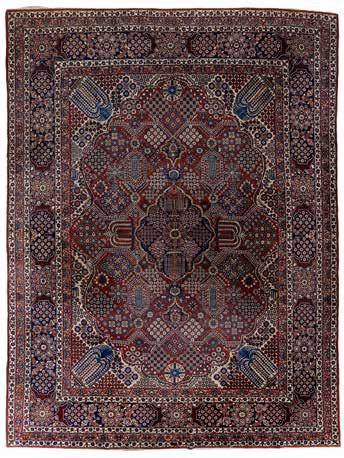
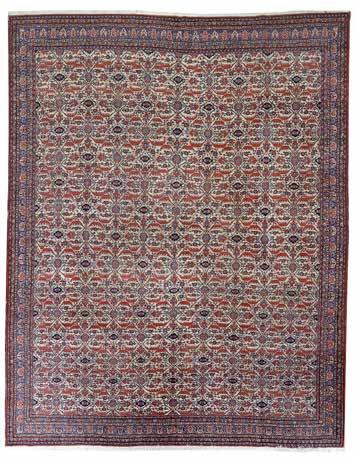
423 by 317 cm.
Estimate € 200 - € 300
Lot 325
AN ISFAHAN CARPET, PERSIA, 1900
420 by 300 cm.
Estimate € 500 - € 700
Lot 327
A BAKTIARI CARPET, PERSIA LATE 19TH CENTURY


495 by 434 cm.
Estimate € 400 - € 600
Lot 326
A BIDJAR RUG, PERSIA MID 19TH CENTURY
224 by 137 cm.
Estimate € 300 - € 400
Lot 328
A TURKMEN YAMUT PRAYER RUG

LATE 19TH CENTURY
195 by 151 cm.
Estimate € 300 - € 500
Lot 329
A BAKTIARI RUG, PERSIA
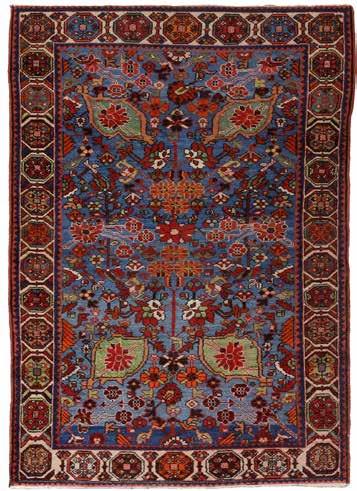
170 by 118 cm.
Estimate € 200 - € 300
Lot 330
A NORTH WEST RUNNER
AZERBAIJAN, MID 19TH CENTURY
371 by 103 cm.
Estimate € 400 - € 600
Lot 331
A KAZAK RUG, CAUCASUS
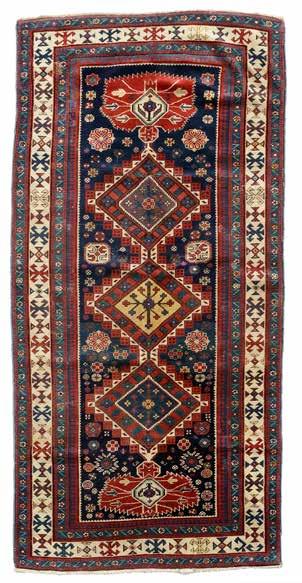

MID 19TH CENTURY
265 by 126 cm.
Estimate € 300 - € 500
Lot 333
A QASHQAI RUG, PERSIA


19TH CENTURY
170 by 94 cm.
Estimate € 300 - € 500
Lot 332
A HAJI JALILI TABRIZ PRAYER CARPET, PERSIA
339 by 281 cm.
Estimate € 400 - € 600
Lot 335
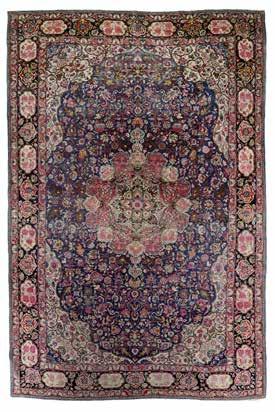

313 by 209 cm.
Estimate € 300 - € 500
Lot 334
180 by 281 cm.
Estimate € 500 - € 700
Lot 337
A KOTAN CARPET
223 by 148 cm.
Estimate € 200 - € 300
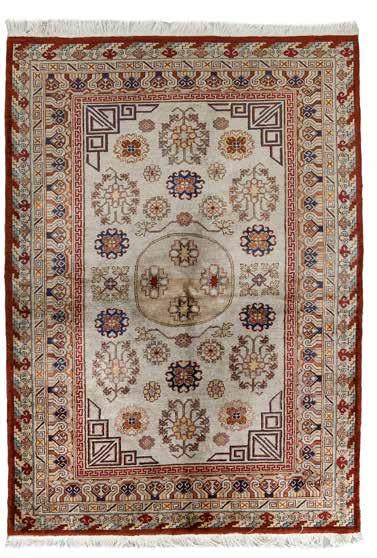

222 by 142 cm.
Estimate € 600 - € 800
Lot 339
A SAHSEWAN KILIM, AZARBAIJAN
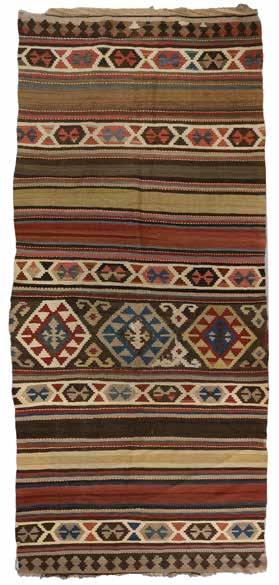

363 by 167 cm.
Estimate € 300 - € 500
Lot 338
A CAUCASIAN KONAKKENT
SUMAK CARPET
353 by 227 cm.
Estimate € 400 - € 800
Lot 341
A FINE HEREKE WOOL CARPET TURKEY
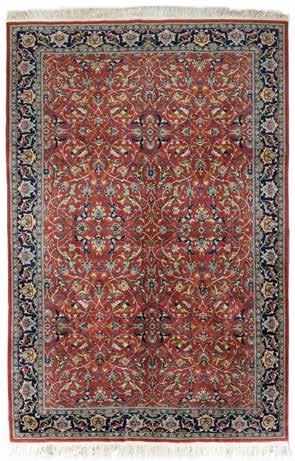
303 by 197 cm.
Estimate € 800 - € 1200
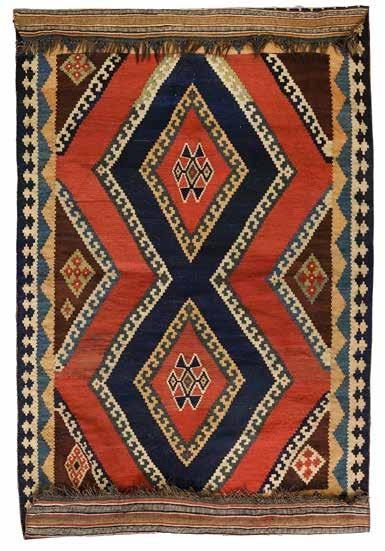
500-684 cm.
Estimate € 400 - € 600
Lot
A CAUCASIAN MOGHAN KOZAK
RUG
288 by 132 cm.
Estimate € 400 - € 600
Lot 342
A KIRMAN RAWER PICTORIAL RUG, PERSIA


180 by 140 cm.
Estimate € 800 - € 1200
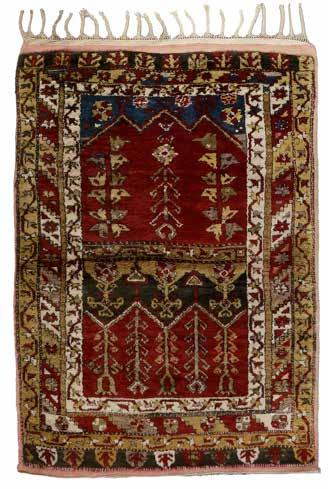

357 by 240 cm.
Estimate € 800 - € 1200
Lot 345
AN ANATOLIAN LADIK RUG
183 by 130 cm.
Estimate € 300 - € 500


140 by 114 cm.
Estimate € 200 - € 300
406 by 130 cm.
Estimate € 300 - € 500

195 by 138 cm.
Estimate € 400 - € 600
A
HERATI RUG, PERSIA
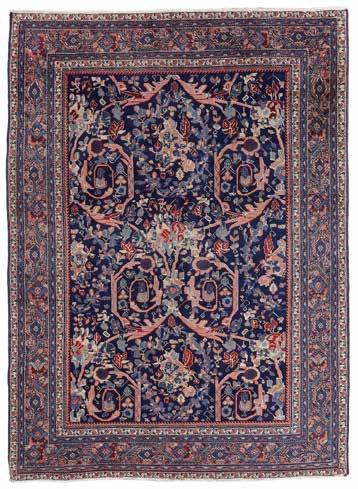
227 by 126 cm.
Estimate € 400 - € 600
Lot 351
A CAUCASIAN LESGHI SHIRVAN RUG
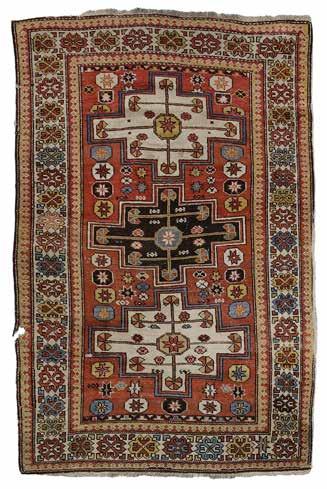

175 by 118 cm.
Estimate € 200 - € 300
Lot 350
A KASHAN KORK PRAGER RUG PERSIA
122 by 136 cm.
Estimate € 200 - € 300
A


200 by 133 cm.
Estimate € 300 - € 500
A
.
140 by 118 cm.
Estimate € 200 - € 300
Lot 355
A SEICHUR SUAMK RUG, CAUCASUS

236 by 172 cm.
Estimate € 300- € 500
Lot 354
A SARUK FARAHAN RUG, PERSIA

200 by 128 cm.
Estimate € 800 - € 1200

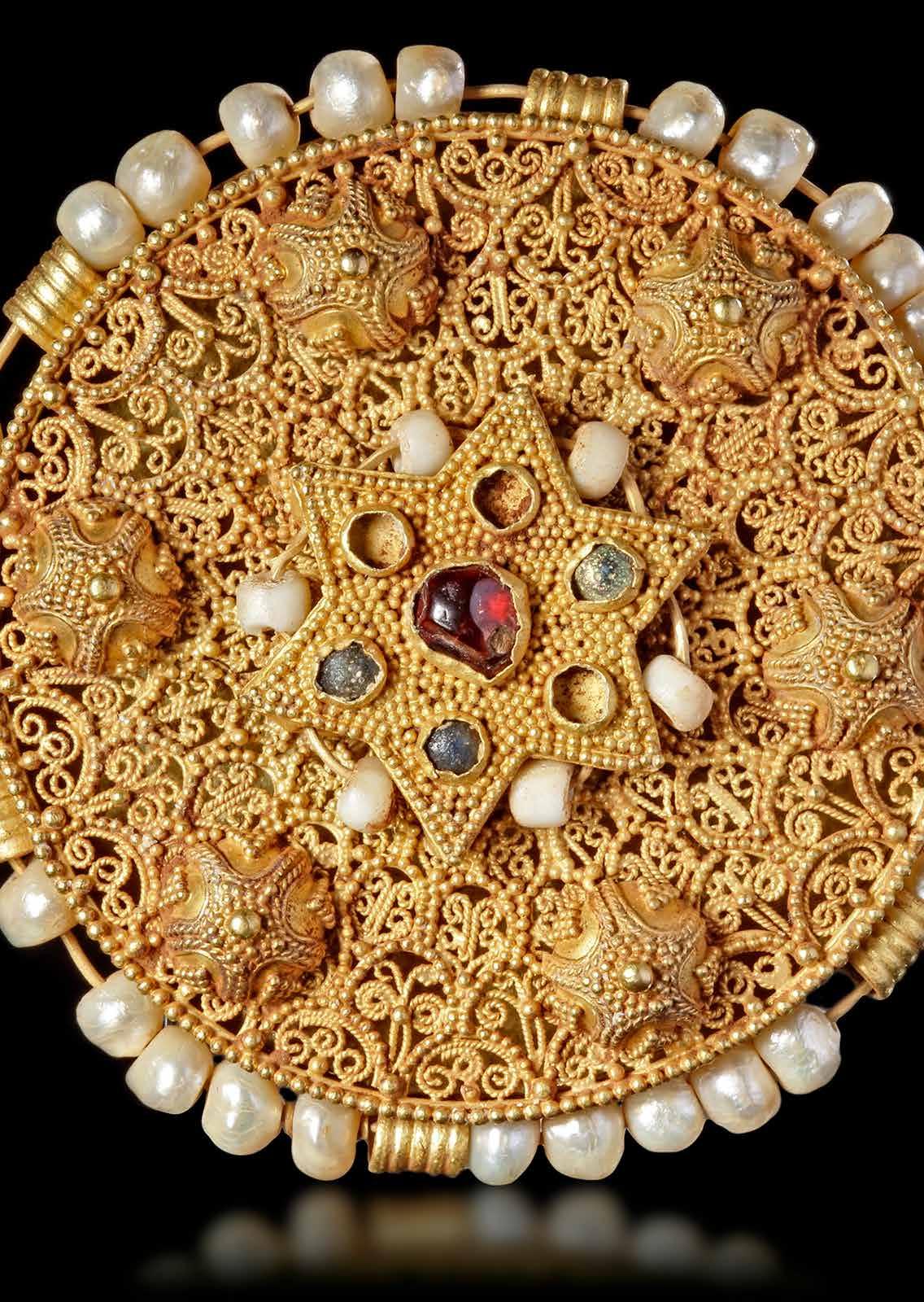
There are several ways to bid at Oriental Art Auctions:
Many clients prefer bidding live online. It’s easy to register with us online and you can watch the auction as it happens and place bids from the comfort of your computer. You can easily register on our website. After being approved you receive an email. Now you can subscribe for the auctions on our website and make bids or auto bids. Clients who wish to bid on line through our website during auction should register 24 hours in advance of a sale.
Simply register at the sale room, or on auction days at the registration and cash desk. You may need to provide identification. Once you have registered you will be handed a bidding number to use in the saleroom. When the bidding begins on your lot raise your number to bid. When the bidding stops the auctioneer will bring down the gavel and read out your number if you have won the lot.
If you are unable to attend the auction we can bid on your behalf. You can leave an absentee bid completing an absentee bid form and either hand it to a member of staff or email it to info@orientalartauctions.com. Please note that our bid department may contact you for further details.
Either way, the amount you enter on the form should be your maximum limit excluding buyer’s premium and applicable VAT. We will bid up to that limit for you, and remember you may end up paying less than your limit, depending on other bidding on the day.
All absentee bids must be received 24 hours in advance of the auction.
If you would like to bid by telephone, a member of staff will call you from the saleroom on the auction day, just before your lot(s) come up, and will then relay to you the events in the room, and bid on your behalf live at the auction when instructed to do so.
If you would like to bid by telephone please contact our team prior to the auction with your details of the lots you are interested in and your full name, mailing address, telephone number(s) and email.
Once our team have processed your bid request you will receive an email confirmation.
All telephone bids must be received 24 hours in advance of the auction.
Please note that Oriental Art Auctions cannot be held responsible for being unable to contact you by telephone. We advise you to remain in an area where mobile communication has good reception.
Please note: some lots contain ivory and are therefore subject to the relevant trade restrictions in correspondence with CITES regulations. Customers should familiarize themselves with the relevant CITES regulations before bidding.
All items may be viewed for inspection in person at the sale room. Viewing dates will be published well in advance on the website. You can always make an appointment for viewing outside the viewing days.
Our auctions are available to view online. We make very high resolution images available online so you can check the item well online. For further information on a lot you may be able to view a condition report online (see below) or contact info@orientalartauctions. com
All lots carry an estimated price range, which indicates our opinion of value. If there is a reserve on the lot then it cannot be sold below that price. Reserves are never higher than the bottom estimate.
We highly recommend that potential bidders gather as much information as possible regarding a lot before placing a bid. Oriental Art Auctions provide as much possible information regarding condition and detailed photographs of each object online. If, however, you are unable to view a lot in person you may request a condition report and/or additional images of a lot by email info@orientalartauctions.com
We kindly request that you submit your wish for additional information as early as possible.
Lot descriptions and estimates are prepared in advance of the auction and may be subject to change. Any alterations will be published on the alteration sheet and be mentioned by the auctioneer before bidding of the items in question begin.
All purchases are subject to a buyer’s premium of 28% including VAT per lot. When you successfully bid on any lot, the price you pay will be the hammer price (the value you bid at the auction), plus the buyer’s premium.
The premium is subject to VAT at the standard rate, with the exception of lots marked in the catalogue with a hash (#) where VAT applies to both hammer price and buyer’s premium.
Credit card payments are subject to a 4% surcharge on the final total.
You may present these documents in person at our saleroom or, if registering for a telephone, internet or absentee bid, by email.We may, at our discretion, ask you to provide a bank reference and/or deposit as a condition of allowing you to bid.
Congratulations on your successful bidding, the next stage is payment.
There are number of ways to pay to make it as easy as possible for you. We accept cash, credit or debit card or bank transfer. All items must be paid for before they can be collected.
Please find details in any email invoice we issue or upon request from our accounts department.
Cash payments can be made at the accounts desk during or after an auction. Please note that due to money laundering regulations we cannot accept cash payments above € 15.000
Payment can be made by credit or bank card. Please note we can accept Visa or MasterCard only, and there will be 4% surcharge
If you attend an auction in person and are successful in your bid, you are free to collect and remove your item there and then once payment has been cleared.
If you are not able to collect in person, Oriental Art Auctions provide in-house packing and shipping possibilities as well as providing quotes for external shippers.
Please contact info@orientalartauctions.com and we will provide you with the various possibilities.
As you may be aware several countries prohibit the importation of property containing materials from endangered species, such as rhino horn, ivory, coral and tortoiseshell. If you are interested in bidding on a lot containing these materials and you wish to export please make sure you are familiar with all relevant customs regulations prior to bidding.
It is the buyer’s sole responsibility to obtain any relevant export or import license.
Please be aware that lots marked with the symbol Y may be subject to CITES regulations when exporting outside the EU.
For further information on buying at Oriental Art Auctions please see our Conditions of Sale.
As we wish to avoid unpaid bids in our auctions, please note the followingpoints before bidding. Bidders who have Chinese nationality must register using their name as stated on their Chinese resident’s identity card and Chinese passport, as a condition of participating in any auction. This rule is stipulated to prevent identity theft. If a bidder has entered a bid using a false identity, the company reserves the right to cancel any existing or future bid made by that bidder. Please carefully inspect and investigate the age and quality of original lots by yourself or have them inspected by your agents, in order to avoid any confusion or misunderstanding between the company and bidders. The company has received legal advice from Chinese law firms, to the effect that anybidders who violate relevant rules or provide fake identity, phone numbers or proof of address, shall bear all liabilityand relevant costs, including lawyers’ fees, litigation fees, arbitration fees, notarial fees, translation fees, travel fees and communication fees. In some circumstances, the company or the seller may apply to prevent the bidder from entering the country where the company is based or prevent them from departing from China. Bidders are required to followt hese rules and the company’s terms and conditions.
We are happy to value any items brought in to the saleroom. Should you have a number of items, please contact us and ask for an onsite valuation.
Once you have decided to sell your items at Oriental Art Auctions, you will receive a receipt detailing in short the items and any applicable reserves and conditions. The items will then be inspected again and processed in our system. Well in advance of the sale, you will receive a detailed receipt with descriptions via email and/or post.
You will receive an advised estimate of each item offered for sale, and we advise that the items are sold the auctioneer’s discretion. This discretionary value would equal a selling price of 10% below the low estimate. Alternatively a fixed reserve price below which we will not sell can be agreed upon when consigning your items. A reserve can never exceed the lower estimate.
You will receive notification of the lot numbers of your property usually about two weeks before the sale. You are of course welcome to come to the view or attend the auction if you wish.
Sale results are sent out within 48 hours of the auction and settlement is usually made six weeks after the sale, subject to normal business conditions. We can only pay out if the buyer paid for the items.
The present document comprises the Terms & Conditions of Consignment between you and Oriental Art Auctions and is applicable to the present and to each subsequent consignment terminating upon expiry at the end of the calendar year or upon the issue of a new version made available to you. Please read this document carefully, in view of the fact that rights and obligations arise as a result of this Agreement.
1.1 The present Agreement containing the General Terms & Conditions of Business is applicable to all parts of the relationship between Oriental Art Auctions B.V., hereinafter referred to as ‘Oriental Art Auctions” and the Consignor/Seller, hereinafter referred to as “the Consignor”, which include a particular purchase, sale, intermediary services, appraisals, evaluations, estimates, cataloguing, and custody, unless expressly agreed otherwise.
1.2 Any departure from the present General Conditions ls only possible if and insofar as expressly agreed in writing by Oriental Art Auctions.
2. COMMISSION CONTRACT
2.1 The Consignor hereby instructs Oriental Art Auctions to examine, appraise and sell at auction the movable property brought in by Consignor and taken delivery of by a representative of Oriental Art Auctions (hereinafter also referred to as: ‘the Items’).
2.2 Oriental Art Auctions are hereby authorized by the Consignor to sell the Items via Oriental Art Auctions under the auction conditions to be set by Oriental Art Auctions, irrespective of whether said authorisation regards all or, alternatively merely a few pieces. Consignor and Oriental Art Auctions may mutually agree upon setting a minimum price (reserve) for each consigned Item.
2.3 Taking delivery of Items, however, does not obligate Oriental Art Auctions to sell or to offer said items for sale at auction. ln the event that Oriental Art Auctions is not willing to enter the Items into auction, the Consignor will be informed by Oriental Art Auctions within four weeks subsequent to any such decision.
3. RIGHTS AND OBLIGATIONS ON THE PART OF THE CONSIGNOR
3.1 The Consignor shall provide proof of identity at the request of Oriental Art Auctions.
3.2 The Consignor warrants that in his/her capacity as true owner or by means of proper authorisation he is authorised to offer the Items for sale at auction and hereby indemnifies and holds Oriental Art Auctions harmless against any and all claims from a third party in relation thereto.
3.3 The Consignor at the request of Oriental Art Auctions is obliged to provide Oriental Art Auctions with information on and substantiated proof of provenance and origin of the Items. The Consignor is liable for any loss/damage in case of information which is inaccurate or misleading and/or in case of any other circumstances attributable to the Consignor and hereby indemnifies and holds Oriental Art Auctions harmless against any and all claims from a third party in relation thereto.
3.4 The Consignor duly declares that sale at auction of the Items is not obstructed by any national or international statutory provisions.
3.5 The Consignor is not allowed to bid on any Items brought in by him unless otherwise agreed in writing with Oriental Art Auctions.
3.6 The rights and obligations by virtue of the present General Terms and Conditions belong exclusively to the Consignor and cannot be transferred by Consignor to a third party.
4. THE RIGHTS OF ORIENTAL ART AUCTIONS
4.1 The inclusion of Items in an auction sale or the exclusion thereof, similarly any (oral) announcement in respect of an Item in the Sale Catalogue or in a brochure, is at the sole discretion of the Oriental Art Auctions, who reserve the right to consult or rely on any expert without accepting any responsibility in connection therewith.
4.2 Oriental Art Auctions reserve the right to determine in which of their sales an Item shall be put up for auction.
4.3 In the event that Oriental Art Auctions are instructed to clear the complete contents of a dwelling or warehouse, they reserve the right to exclude Items from said clearance and also to remove or dispose of any such Items which in their opinion are not suitable for auction or if possible, to convert said Items into cash by other means.
4.4 Consignor duly declares that Oriental Art Auctions are authorized to photograph, illustrate or otherwise make visual representations of all the Items offered for sale and to copy or cause said Items to be copied in any way whatsoever, both prior and subsequent to the sale, and shall observe any statutory regulations applicable thereto. Oriental Art Auctions retain the copyright in all such visual representations for use at their discretion.
5.1 Once an Item has been entered into an auction, it can only be withdrawn by the Consignor following payment of 30% of the agreed reserve, or of a lesser amount if in the opinion of Oriental Art Auctions this is reasonable, or in the absence of a reserve price, payment of 30% or of a lesser amount of the expected proceeds at auction as estimated by Oriental Art Auctions plus all incurred costs, if any.
5.2 In the event that the Consignor is not satisfied with the estimate as set out in 5.1, he/she can request a re/estimation at his/ her own expense, to be performed by three experts who are approved Registered Brokers/ or Registered Broker-Assessors and whose area of specialisation is that of the Item or alternatively, to be performed by certified appraisers or brokers, one of whom to be appointed by Oriental Art Auctions, one of whom by the Consignor, and the third to be nominated jointly by the two already appointed. Should the re-estimation result in a different value, said different value shall be binding upon Oriental Art Auctions and applicable to the Consignor in accordance with the applicability of the present Clause.
In case of sale of the Items at auction, the commission payable to Oriental Art Auctions amounts to a percentage of the price achieved at the sale agreed prior to the sale.
7.1 The Consignor acknowledges that he/she is familiar and agrees with the General Conditions of Oriental Art Auctions, applicable to Oriental Art Auctions and Buyer in respect of a purchase at auction of movable property, of his willingness to do the following:
‘Unless certain items in the catalogue are expressly excluded - except for a number of cases mentioned in the General Conditions of Sale applicable to the purchase of movable property at auction - Oriental Art Auctions may be willing to set aside the sale of a Lot at auction and to refund an amount corresponding to the original Purchase Price and auction costs, in the event that the Seller within a period of three weeks subsequent to the sale has established to the satisfaction of Oriental Art Auctions that the Lot sold at auction has such serious hidden faults or that the description given is shown to be so erroneous, that had the Buyer been aware of said faults or had there been an accurate description at the fall of the hammer, said Buyer would have decided not to proceed with the purchase or would have made the purchase only at a considerably lower price:.
7.2 The Consignor shall grant Oriental Art Auctions an irrevocable authorisation to set aside the sale in consideration for a refund of the Purchase Price and auctions costs. Oriental Art Auctions has sole discretion to determine whether the circumstances are applicable in any such case. By reason of the setting aside of the sale, the Item is considered to be unsold within the meaning of Clause 11 of the present contractual Terms & Conditions
8.1 Oriental Art Auctions shall in the name of Oriental Art Auctions ensure payment to the Consignor of the proceeds from the sale less all fees and charges to be borne by the Consignor, such as transport costs, restoration costs, commission fees, vetting costs, insurance premiums, if applicable, and any other costs agreed in advance as well as VAT [BTW]. hereinafter referred to as: •[the] Compensation’, providing that Oriental Art Auctions has received from the Buyer the full Purchase Price, and providing that the Buyer has not asserted the obligation on the part of Oriental Art Auctions to set aside the sale within the meaning of Clause 7 of the present Agreement, which assertion is acknowledged by the auctioneer and provided that no cancellation of the sale has occurred within the meaning of Clause 9 of the present contractual Terms & Conditions.
8.2 Payment of The Compensation ls normally is effected within 45 days following a sale. unless a written notice as set out in Clause 7 of the present Conditions is received from the Buyer, or a setting aside of the sale within the meaning of Clause 9 of the present Agreement has occurred.
8.3 Invocation of the so-called margin scheme can only be made in the event that prior to the sale all the necessary conditions have been met, including inter alia the declaration of purchase for VAT purposes (inkoopverklaring): the above at the absolute discretion of Oriental Art Auctions.
In the case of “a setting aside’ as set out in Clause 7 of the present Terms & Conditions, or a cancellation of the Purchase agreement with the Buyer for any other reason, then Oriental Art Auctions reserves the right to claim back any Compensation already paid to the Consignor as well as any other loss/damage and costs incurred by Oriental Art Auctions as a consequence of said setting aside, including interest charges and judicial and extrajudicial costs.
10.1 The Consignor is familiar with the fact that Oriental Art Auctions, in the Conditions of Sale (being the General Terms & Conditions of Oriental Art Auctions and the Buyer in respect of a purchase at auction of movable property), reserves the right to set aside the Purchase agreement in the event that the Buyer shall exceed the term for payment.
10.2 The Consignor expressly acknowledges and agrees that Oriental Art Auctions have the right to recover any loss/damage and costs against the Buyer in case of the occurrence of a situation as set out in 10.1. Also the Consignor expressly acknowledges and agrees that Oriental Art Auctions have the right to claim specific performance when the Buyer has failed to comply with the period for payment, or alternatively, to proceed to set aside the sale, or alternatively, first to file a claim against the Buyer for specific performance which if unsuccessful, then to take steps to set aside the sale: the above at the discretion of Oriental Art Auctions.
11.1 Oriental Art Auctions are irrevocably authorized but never obligated to offer Items for sale at a later auction, hereinafter referred to as: “to resell”, or alternatively, to sell said Items within a period of ten days after a particular auction. Any such post-auction sale (“aftersale”) can only take place at a price that is at least the equivalent of the Purchase price less all costs to be borne by the Consignor to which the Consignor would have been entitled if the Item had sold for the reserve set at auction.
11.2 In the event of such an aftersale, the rights and obligations of the Consignor and Oriental Art Auctions by virtue of the present Agreement shall be equally binding and apply in full as if the Item had been sold at the particular auction.
11.3 Accordingly, the provisions set out in the present Agreement shall apply in full to any such resale or aftersale.
12.1 All packaging materials in respect of the Items consigned to the auction sale may be removed or disposed of by Oriental Art Auctions unless expressly agreed otherwise by Oriental Art Auctions and the Consignor.
12.2 All the Items consigned to Oriental Art Auctions are insured for the value stated on the receipt, or alternatively for an appropriate value determined at the sole discretion of Oriental Art Auctions. against fire. theft, loss and damage provided that said Items are kept in the offices of Oriental Art Auctions or in other storage facilities chosen by Oriental Art Auctions. The Consignor is entitled to claim a receipt for the Items consigned to Oriental Art Auctions, which receipt indicates the value represented by the Items at the moment of consignment according to a preliminary estimate given by Oriental Art Auctions.
12.3 Oriental Art Auctions reserves the right to take measures for storing with a third party Items sent or brought to auction, and to charge the Consignor for any such costs in relation thereto.
12.4 Items which have been sent or brought in to Oriental Art Auctions and which have not been accepted for auction and which are not stored for [temporary] safekeeping, shall at the risk and expense of the Sender be returned to the Sender wholly at his own cost.
13.1 Oriental Art Auctions accept no liability whatsoever for any damage to frames of paintings, or other works of ort, nor to any parts thereof such as glass coverings, passe-partouts, etc, except in case of damage caused wilfully or by gross negligence on the part of Oriental Art Auctions and/or his/her employees or representatives.
13.2 In no event shall Oriental Art Auctions be liable for any damage/loss caused by interruption to business, consequential damage/loss, damage/loss of property and/or indirect damage.
13.3 Furthermore, Oriental Art Auctions cannot be held liable for any accident or any form of personal injury suffered on or in the vicinity of the premises or surrounding areas in use for consignment, storing or viewing, for holding auctions or in use for picking up the goods sold, except in case of damage caused wilfully or by gross negligence on the part of Oriental Art Auctions and/or his/ her employees or representatives and/or except insofar as such accident/personal injury is covered by the insurance of Oriental Art Auctions.
13.4 Entering the premises or surrounding areas is entirely at your own risk.
14.1 In the event that an agreement is entered into between Oriental Art Auctions and the Consignor/natural person who is not acting in the course of his/her trade or profession, under which, up to and including the conclusion of the Agreement, use can only be made of one or more techniques for long-distance communication within the context of the auction system for long distance services maintained by Oriental Art Auctions. in case of the above, the following shall apply.
14.2 During the duration of 7 working days to be calculated from the day upon which the Agreement is concluded, the Consignor/natural person is entitled to cancel the Agreement free of charge and without giving reasons. Under certain circumstances the period can be extended to three months subsequent to the conclusion of the agreement. Any such termination must occur in writing (per e-mail or written letter).
14.3 The Consignor/natural person cannot assert the abovementioned right. in the event that with his/her consent Oriental Art Auctions has commenced performance of the Agreement prior to the expiry of the term mentioned above.
14.4 In deviation from the provisions set out in Article 7:46101 the Dutch Civil Code pertaining to an occurrence of default, the statutory provisions set out in Articles 6:81-83 01 the Dutch Civil Code shall apply instead.
15.1 Nullification, annulment or the non-bindingness of one of the provisions set out in the present Agreement containing General Conditions 01 Business shall not affect the validity of the remaining provisions. In the event that one or more provisions is null and void, annulled or nonbinding, Consigner and Oriental Art Auctions shall agree one or more provisions to replace the above which are valid and which correspond as far as possible in content and purport to the provisions that are null and void, annulled or nonbinding.
15.2 Objects which, even without prior knowledge of the owner, are deemed to be cultural heritage, and objects which are made with materials which do not have the necessary CITES certificate, (Ivory, Coral, Rhinoceros horn etc.) are excluded from our Auctions. This also counts for objects which may be considered plundered artworks by the authorities. Possible confiscations and legal consequences are the sole responsibility and expense of the consignor.
15.3 The present Conditions of Business are governed exclusively by the Laws of the Netherlands.
15.4 All disputes pertaining to, arising from or in connection with any agreement entered into between Oriental Art Auctions and the Consignor or in connection with the formation of any such agreement shall be submitted to the exclusive jurisdiction of the competent court in Zwolle, except for the right of Oriental Art Auctions to choose to have the dispute adjudicated by the competent court located in the district of the Consignor.


